Forums
- Forums
- Axis And Allies Forum
- General Discussion
- Aviation News
Aviation News
Post a reply
- Go to Next topic
- Go to Welcome
- Go to Introduce Yourself
- Go to General Discussion
- Go to Screenshots, Images and Videos
- Go to Off topic
- Go to Works in Progress
- Go to Skinning Tips / Tutorials
- Go to Skin Requests
- Go to IJAAF Library
- Go to Luftwaffe Library
- Go to RAF Library
- Go to USAAF / USN Library
- Go to Misc Library
- Go to The Ops Room
- Go to Made in Germany
- Go to Campaigns and Missions
- Go to Works in Progress
- Go to Juri's Air-Raid Shelter
- Go to Campaigns and Missions
- Go to Works in Progress
- Go to Skinpacks
- Go to External Projects Discussion
- Go to Books & Resources
-
 Main AdminPARIS ? Four U.S. Air Force F-22 Raptor fifth generation fighters fly over the Lafayette Escadrille Memorial in Marnes-la-Coquette, France, April 20, 2016, during a ceremony honoring the 268 Americans who joined the French air force before the U.S. officially engaged in World War I. In addition to the F-22s, a U.S. Air Force B-52 Stratofortress bomber, four French air force Mirage 2000Ns and a World War I-era Steerman PT-17 biplane performed flyovers during the ceremony commemorating the 100th anniversary of the Layfette Escadrille?s formation. Men of the Lafayette Escadrille and Lafayette Flying Corps were critical to the formation of the U.S. Air Force. (U.S. Air Force Photo by Tech. Sgt. Joshua DeMotts)
Main AdminPARIS ? Four U.S. Air Force F-22 Raptor fifth generation fighters fly over the Lafayette Escadrille Memorial in Marnes-la-Coquette, France, April 20, 2016, during a ceremony honoring the 268 Americans who joined the French air force before the U.S. officially engaged in World War I. In addition to the F-22s, a U.S. Air Force B-52 Stratofortress bomber, four French air force Mirage 2000Ns and a World War I-era Steerman PT-17 biplane performed flyovers during the ceremony commemorating the 100th anniversary of the Layfette Escadrille?s formation. Men of the Lafayette Escadrille and Lafayette Flying Corps were critical to the formation of the U.S. Air Force. (U.S. Air Force Photo by Tech. Sgt. Joshua DeMotts)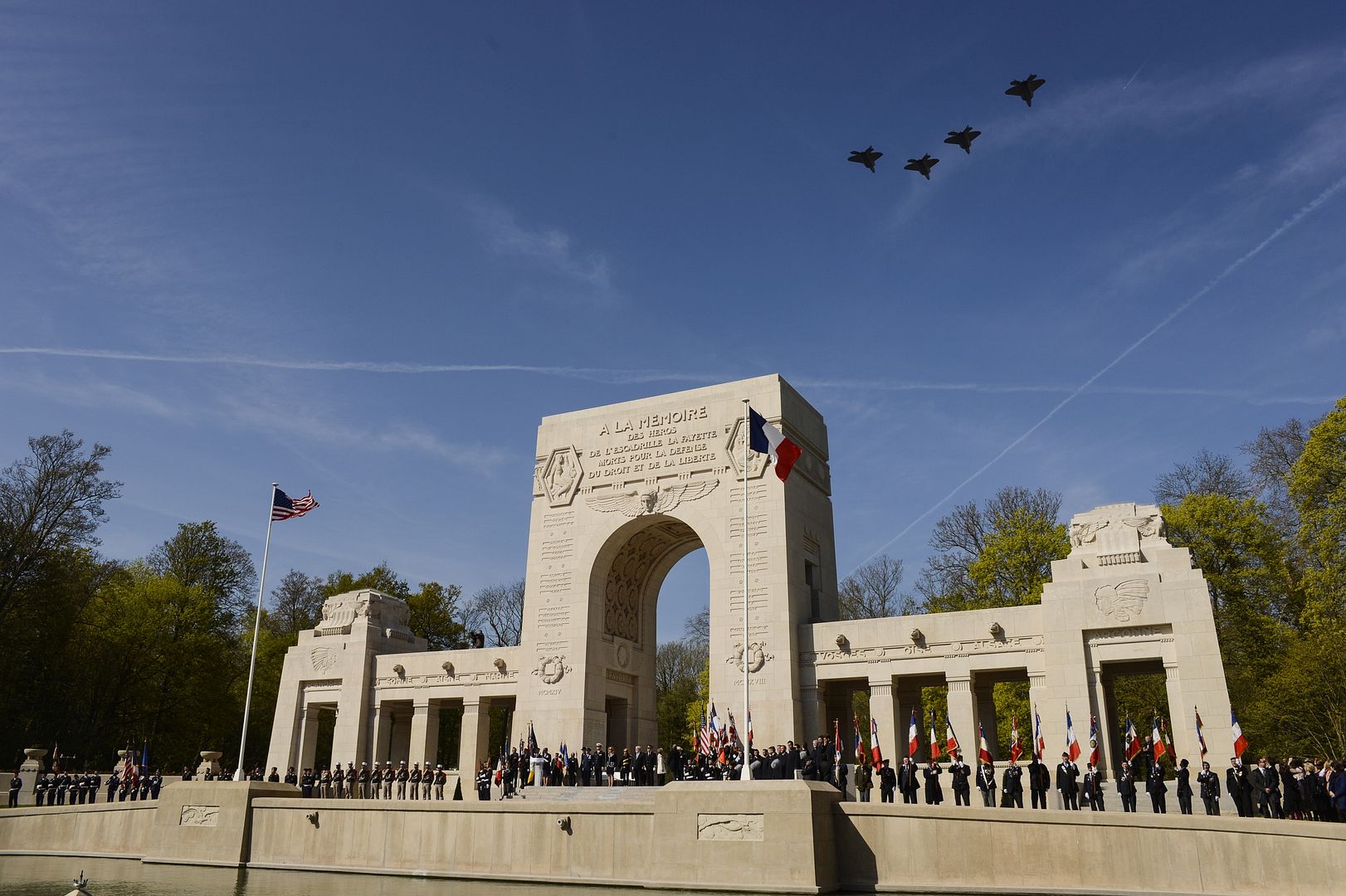
Journalists from various news agencies in the South Korea take photos of an EA-18 Growler from Electronic Attack Squadron138, Naval Air Station Whidbey Island, Wash., during Media Day at Kunsan Air Base, South Korea, April 20, 2016. Media Day was held during Max Thunder 16, which is held annually to integrate U.S. and South Korea forces to train for air-to-air and air-to-ground missions to continuously sharpen mutual understanding and cooperation between the two nations. (U.S. Air Force photo by Staff Sgt. Nick Wilson)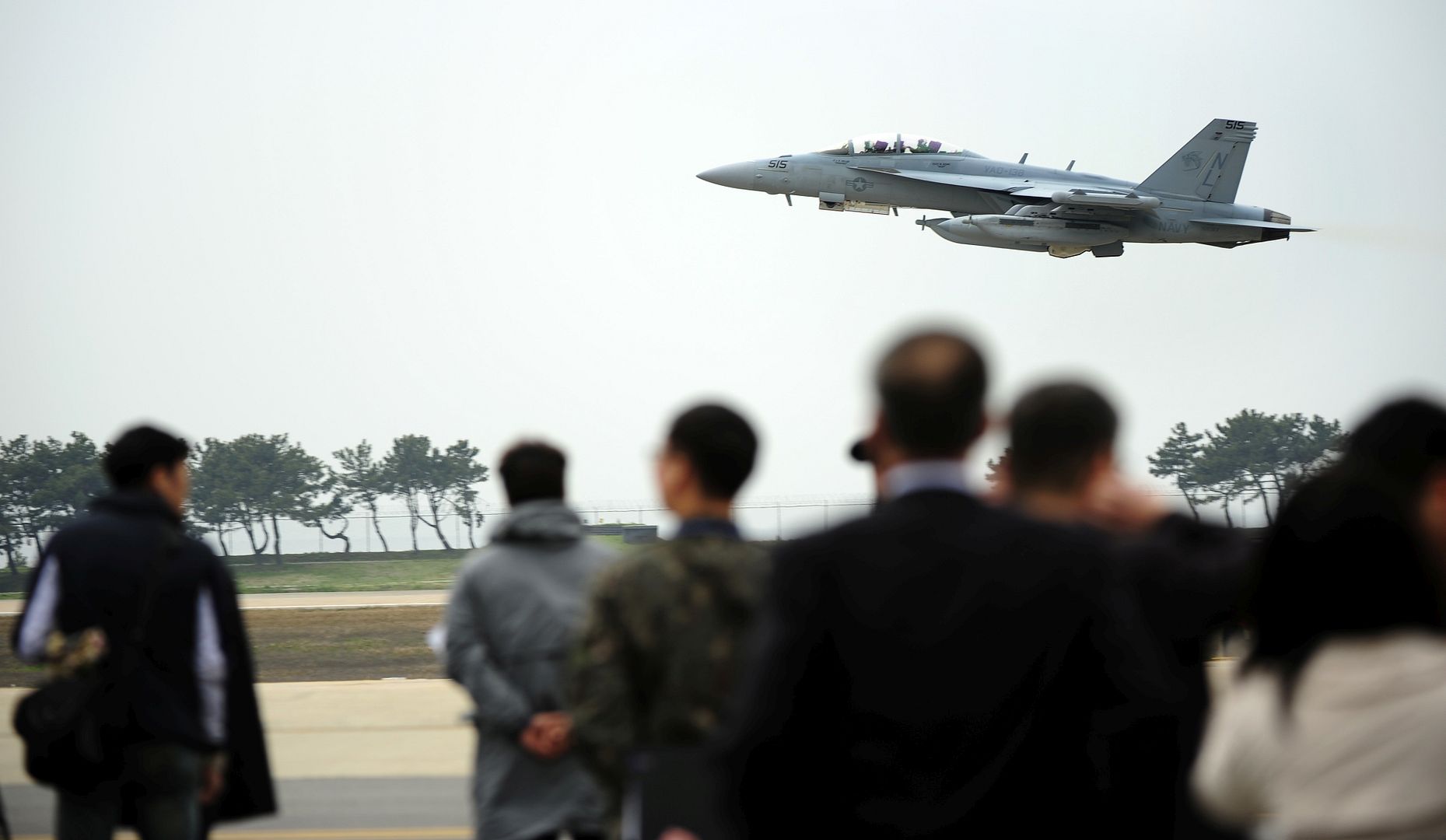
Journalists from various news agencies in the Republic of Korea take photos of an F-15K Slam Eagle from the 11th Fighter Wing, Daegu Air Base, Republic of Korea, during Media Day at Kunsan Air Base, ROK, April 20, 2016. Media Day was held during Max Thunder 16, which is held annually to integrate U.S. and ROK forces to train for air-to-air and air-to-ground missions to continuously sharpen mutual understanding and cooperation between the two nations. (U.S. Air Force photo by Staff Sgt. Nick Wilson/Released)
HILL AIR FORCE BASE, Utah (AFNS) -- The Ogden Air Logistics Complex here became the first depot facility to perform modifications on all three F-35 Lightning II variants after it inducted a Navy F-35C carrier version April 15.
The F-35C was flown in from Eglin Air Force Base, Florida, by Navy Capt. Mark Weisgerber, the 33rd Fighter Wing vice commander.
"Hill has the capacity to accomplish the needed modifications and it is important to optimize the workflow within the Air Logistics Complex," Weisgerber said.
The first F-35 arrived at Hill AFB for modifications in September 2013. Since then, the depot has performed modifications on the Air Force's fleet of conventional takeoff and landing F-35As. It also has completed work on four Marine Corps F-35B short takeoff/vertical landing aircraft, helping the Marine Corps reach initial operational capability.
For the Navy's carrier variant, the complex's 570th Aircraft Maintenance Squadron, along with Lockheed Martin, will perform structural upgrades, low-observable restoration and system modifications that will enhance performance across the aircraft's service life.
"The men and women of the 570th (AMXS)have risen to the challenges of supporting the dynamic changes in this program and take great pride in being the first depot to work on all three variants of the F-35," said Greg Hoffman, the 570th AMXS director.
With the program's ever-evolving requirements, exact numbers of how many aircraft will be worked on this year is not yet available. The squadron's main focus will center on completing work on the Air Force fleet of F-35A models and Navy's F-35C models, and returning the aircraft to the warfighter better than they arrived.
"We were able to support the U.S. Marine Corps with critical modifications on the F-35B to meet their initial operational capability (IOC) milestone," Hoffman said. "Today, we are working closely with the 388th Fighter Wing to provide modifications that will ensure they are able to meet their IOC target with the F-35A and are proud to support the Navy with work on the F-35C.?
The complex had been planning for the arrival of the C-model for months and expects work on the fighter jet to last through early September as workers train with the aircraft and perform verification and validation on the new modifications.
21 April 2016
Senior Leaders from the Royal Air Force and French Air Force (FrAF) have spoken of their pride in the two air forces? close cooperation, as UK-French wargames entered their second week.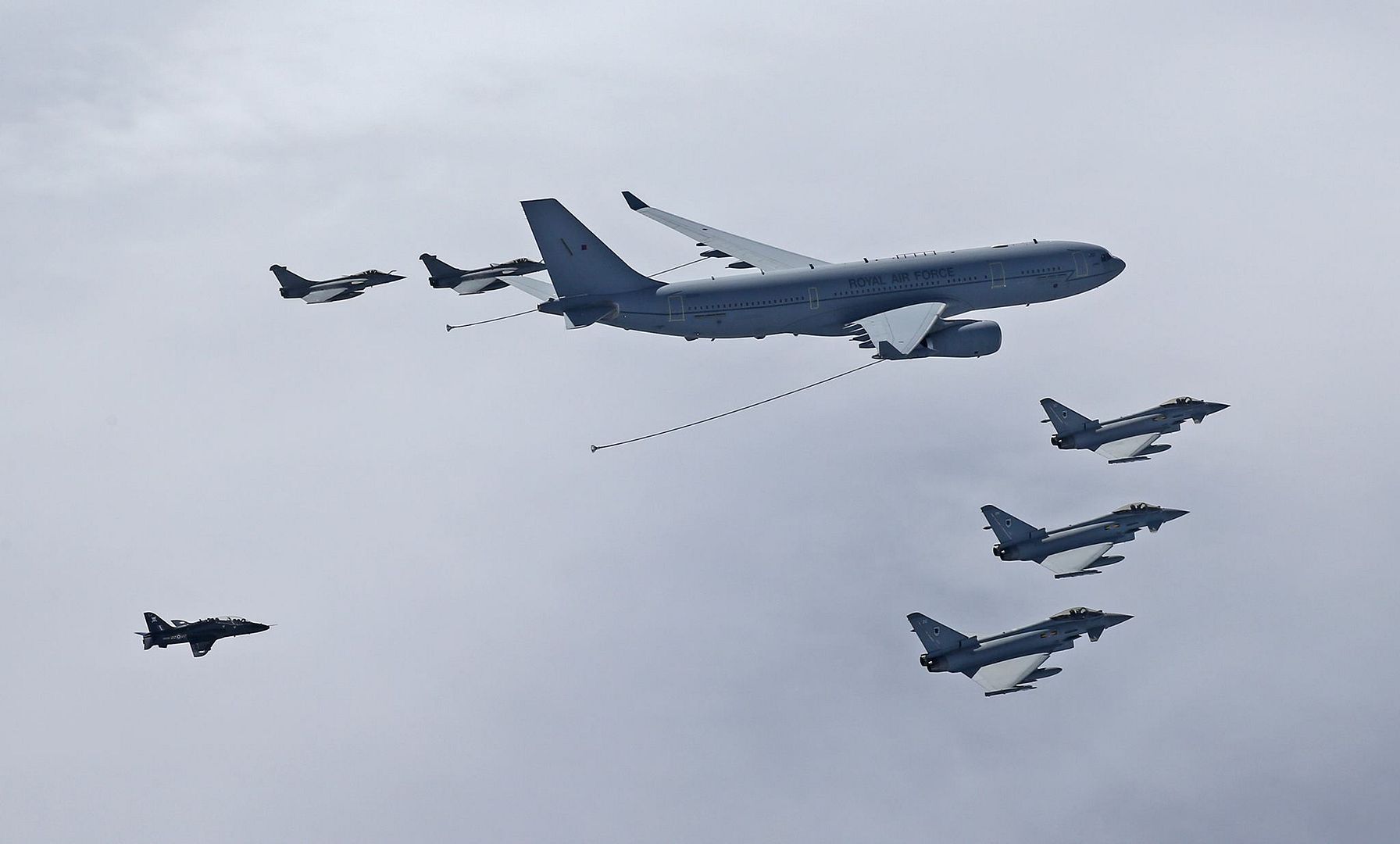
Following a visit to UK and French aircrew involved in Exercise Griffin Strike, a major UK-French wargame, the AAF?s head of air operations and air defence said cooperation between the two air forces was ?in their DNA?. His RAF counterpart praised the allies? work together on operations.
Exercise Griffin Strike, which ends this week, has been designed to test the Combined Joint Expeditionary Force, a military force created to support the two countries? shared security interests. 135 Combined Expeditionary Air Wing, a formation of RAF Typhoon and FrAF Rafale fast jets, has been operating from RAF Leeming since 11 April in support of the British and French armies, the Royal Navy and the French Navy. Air operations are coordinated through a Combined Joint Force Air Component Headquarters at RAF High Wycombe. More than 640 air force personnel from both countries are involved in the 5,400-strong exercise.
The FrAF?s Chief of Staff Air Defence & Air Operations Command, G?n?ral de Brigade A?rienne Gilles Perron, said: ?Over the years, The French Air Force has developed interesting synergies with allies for delivering air power. Our aviators have been working closely together to build standard operating procedures and maintain a high level of confidence. I think this interoperability lies in their DNA. And it fuels this exercise. Given the growing instability around the world, I think it is a wise choice to foster such a CJEF concept: a plug-and-play kit, an agile and synchronized force, and a cost-effective tool for crisis management.?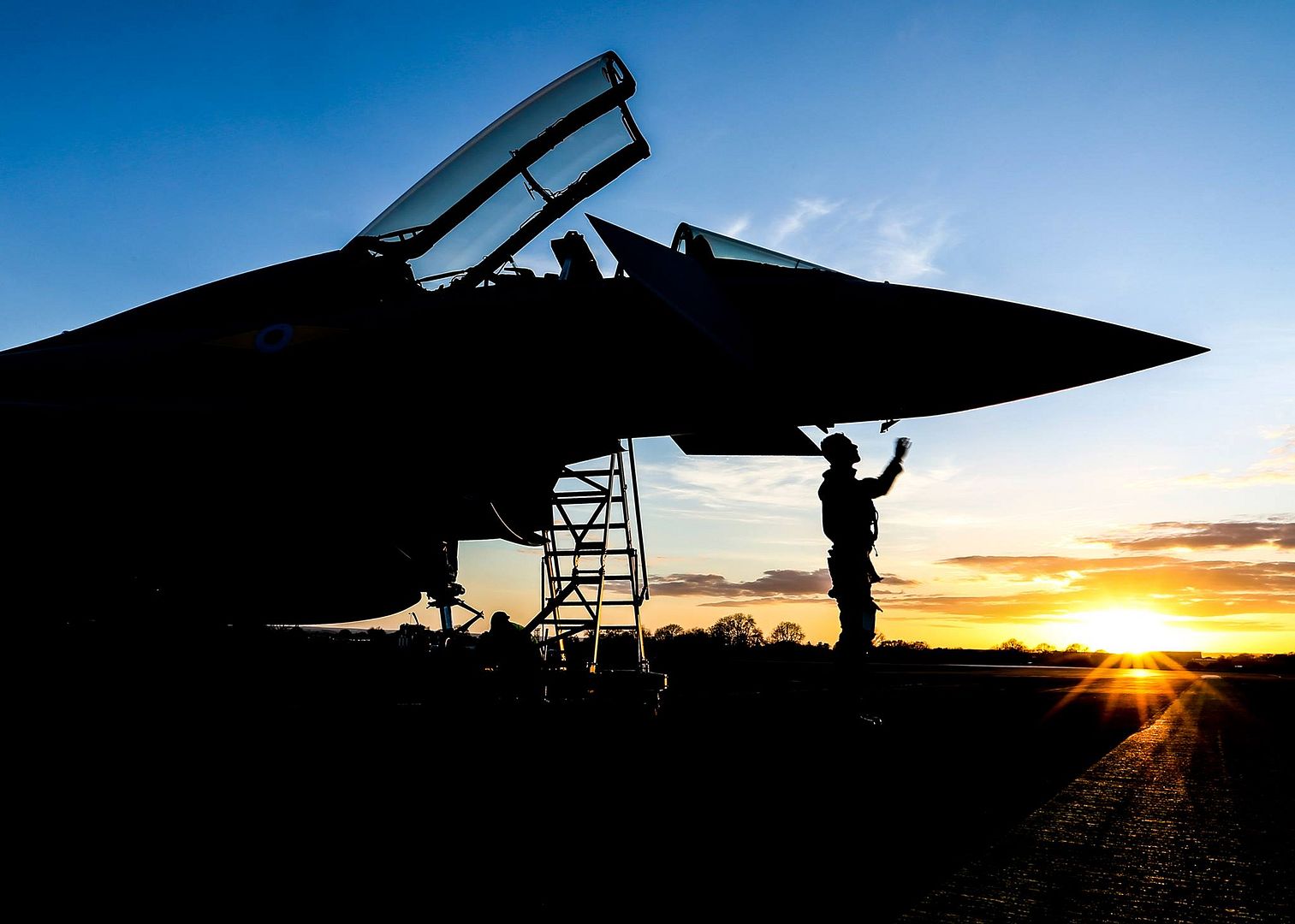
The RAF?s Assistant Chief of Staff (Operations), Air Commodore Johnny Stringer, said: ?Britain and France have shared interests and shared responsibilities as key players in NATO and Europe?s principal investors in Defence. Combined British and French air power is already playing a significant role in protecting our security and defending our values in the fight against Daesh; through the Combined Joint Expeditionary Force we will be able to do even more together as close friends and allies. Griffin Strike sets the seal on years of close cooperation between the Royal Air Force and the French Air Force ? we look forward to further developing that in the months and years ahead.?
Editor: Sqn Ldr Andy Wasley
Photographs: Sgt Peter George
-
 Main AdminU.S. Air Force crew chiefs with the 153rd Maintenance Group, Wyoming Air National Guard tow an aircraft inside a hangar to facilitate maintenance, Apr. 21, 2016 in Cheyenne, Wyoming. Maintainers must tow the aircraft in the hangar when wind gusts are out of limits to perform certain types of repairs. (U.S. Air National Guard photo by Master Sgt. Charles Delano/released)
Main AdminU.S. Air Force crew chiefs with the 153rd Maintenance Group, Wyoming Air National Guard tow an aircraft inside a hangar to facilitate maintenance, Apr. 21, 2016 in Cheyenne, Wyoming. Maintainers must tow the aircraft in the hangar when wind gusts are out of limits to perform certain types of repairs. (U.S. Air National Guard photo by Master Sgt. Charles Delano/released)
A Lithuanian soldier slides down a fast rope from a Latvian Mi-17 helicopter during fast rope insertion extraction training, April 21 at Lielvarde Air Base, Latvia. Soldiers assigned to Headquarters and Headquarters Troop, 3rd Squadron, 2nd Cavalry Regiment joined allies from Latvia, Canada, Lithuania and Germany for the training, which ended with special purpose insertion extraction exercises. Soldiers from the five North Atlantic Treaty Organization nations have been conducting a variety of training together during Summer Shield XIII, an annual two-week long interoperability training event in Latvia.(U.S. Army photo by Sgt. Paige Behringer, 10th Press Camp Headquarters)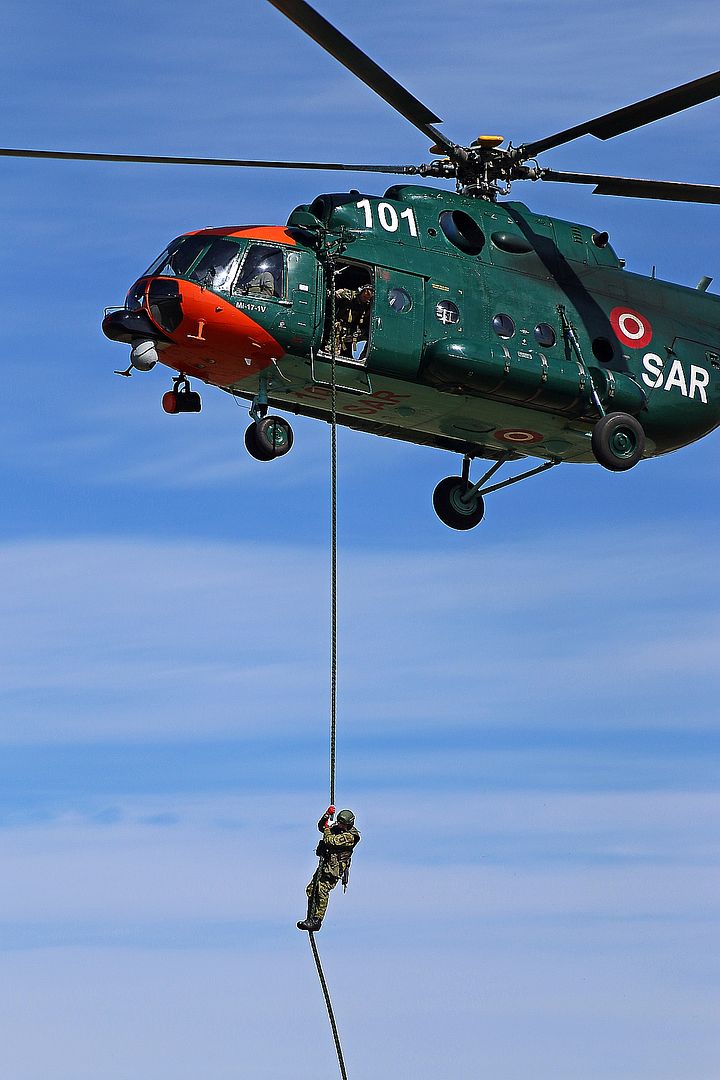
An FA 50 from the 16th Fighter Wing, Yecheon Air Base, Republic of Korea, taxis on the flight line as an EA-18 Growler from Electronic Attack Squadron 138, Naval Air Station Whidbey Island, Wa., takes off on the runway as part of Max Thunder 16 at Kunsan Air Base, Republic of Korea, April, 20, 2016. This exercise is held annually to integrate U.S. and ROK forces to train for air-to-air and air-to-ground missions to continuously sharpen mutual understanding and cooperation between the two nations. (U.S. Air Force photo by Staff Sgt. Nick Wilson/Released)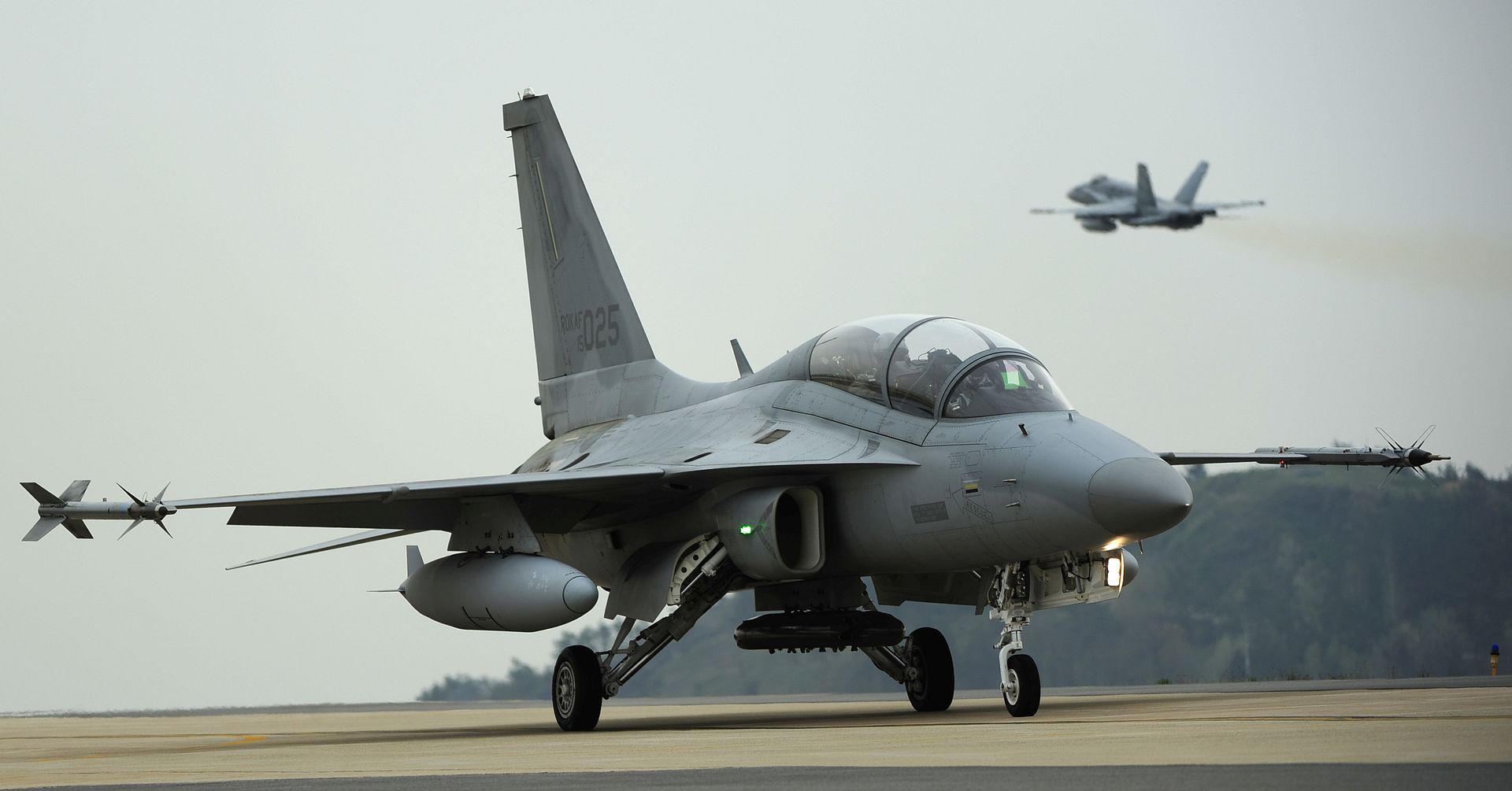
An F-15E Strike Eagle from the 494th Fighter Squadron lands after conducting air-to-air fighter integration training with F-22 Raptors from the 95th Fighter Squadron April 20, at Royal Air Force Lakenheath, England. The training allows the legacy aircraft a unique opportunity to fly alongside the advanced fifth-generation aircraft while working with joint partners and NATO allies. (U.S. Air Force photo/ Tech. Sgt. Matthew Plew)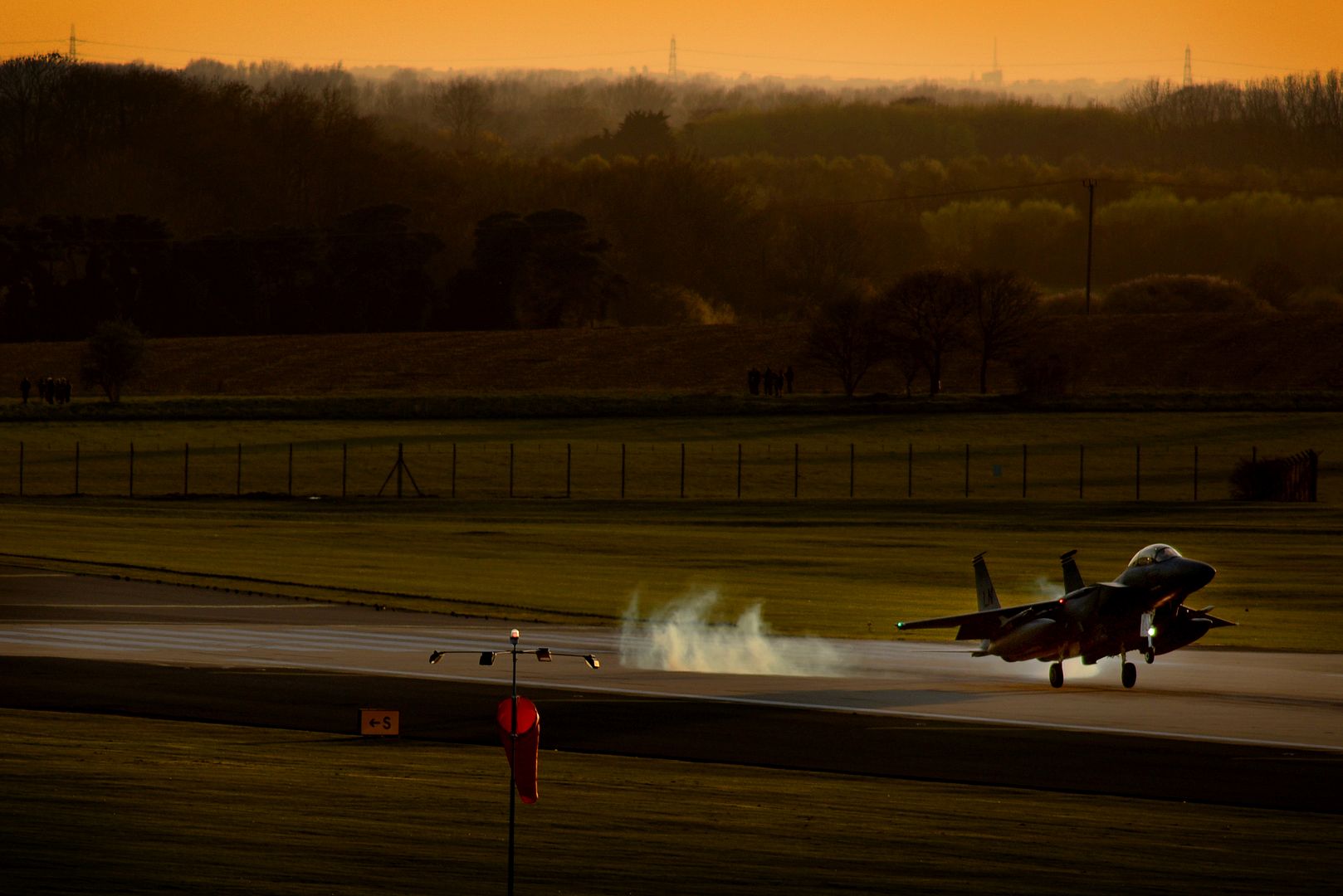
An F-15E Strike Eagle from the 492d Fighter Squadron taxis for takeoff April 20, at Royal Air Force Lakenheath, England. The F-15 conducted air-to-air fighter integration training with F-22 Raptors from the 95th Fighter Squadron which allows the legacy aircraft a unique opportunity to fly alongside the advanced fifth-generation aircraft while working with joint partners and NATO allies. (U.S. Air Force photo/ Tech. Sgt. Matthew Plew)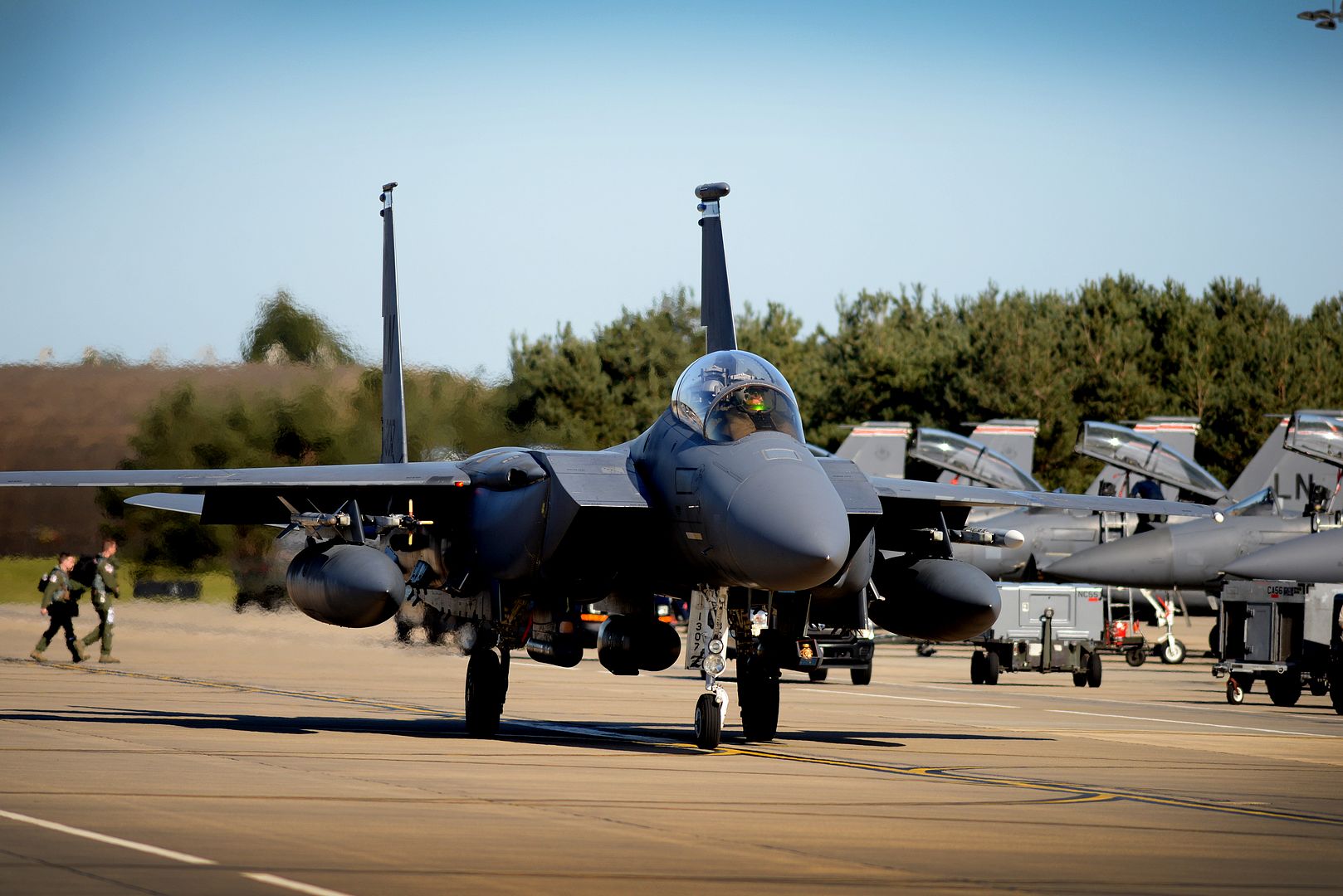
F-22 Raptors from the 95th Fighter Squadron taxi for takeoff April 20, at Royal Air Force Lakenheath, England. The F-22's conducted air-to-air fighter integration training with F-15 Strike Eagles from the 492d Fighter Squadron, which allows the advanced aircraft a unique opportunity to fly alongside other U.S. Air Force aircraft, joint partners and NATO allies. (U.S. Air Force photo/ Tech. Sgt. Matthew Plew)
TOKYO --- Today, Mitsubishi Heavy Industries, Ltd. (MHI) successfully completed the maiden flight of the "X-2," an advanced technology demonstrator jet.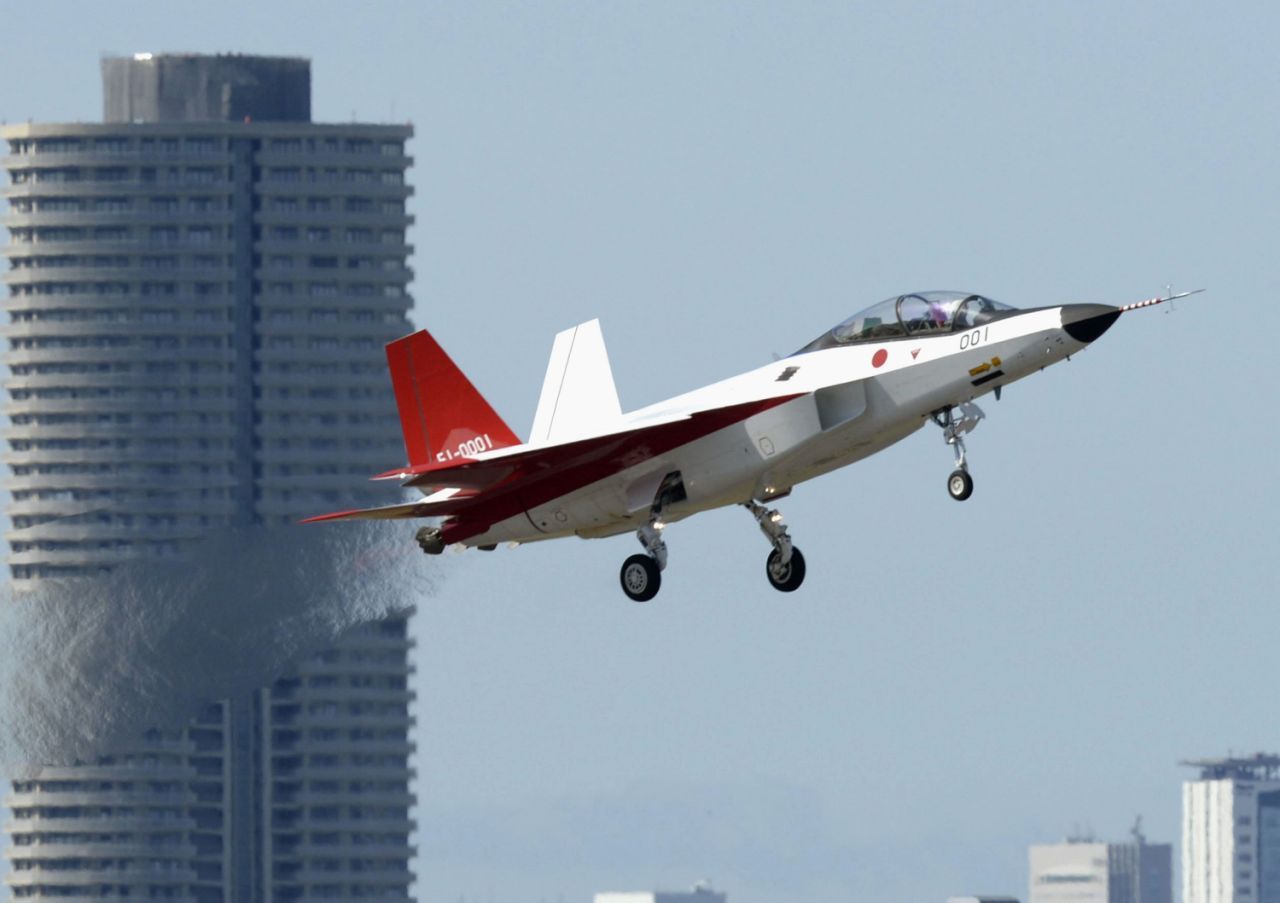
The aircraft took off from Nagoya Airport and went through a series of trials to confirm basic maneuvers including climbing, descent and circling operations. It then landed at the Japan Air Self-Defense Force?s Gifu Air Base. After completing the maiden flight, the pilot, from MHI, described the flight experience as "extremely stable."
"Control of the aircraft went exactly as in our simulated training sessions," he said, "and after piloting the aircraft I?m 100% positive the X-2 is magnificent and will meet the Ministry of Defense?s requirements."
The X-2 is a prototype stealth aircraft - the first in Japan to feature technology impeding its detection by radar - engineered for extremely high maneuverability. The prototype integrates an airframe, engines, and other advanced systems and equipment all adaptable to future fighters.
As the coordinating company of the X-2 development project, MHI has been developing the aircraft?s airframe since 2009 with cooperation provided by 220 domestic companies and guidance from Japan?s Acquisition, Technology & Logistics Agency (ATLA). In this way, world-class cutting-edge technologies developed in Japan are featured throughout the prototype unit.
Going forward MHI will continue to develop, manufacture and support the operation of defense aircraft incorporating the world?s leading technologies, thereby contributing to Japan?s national security.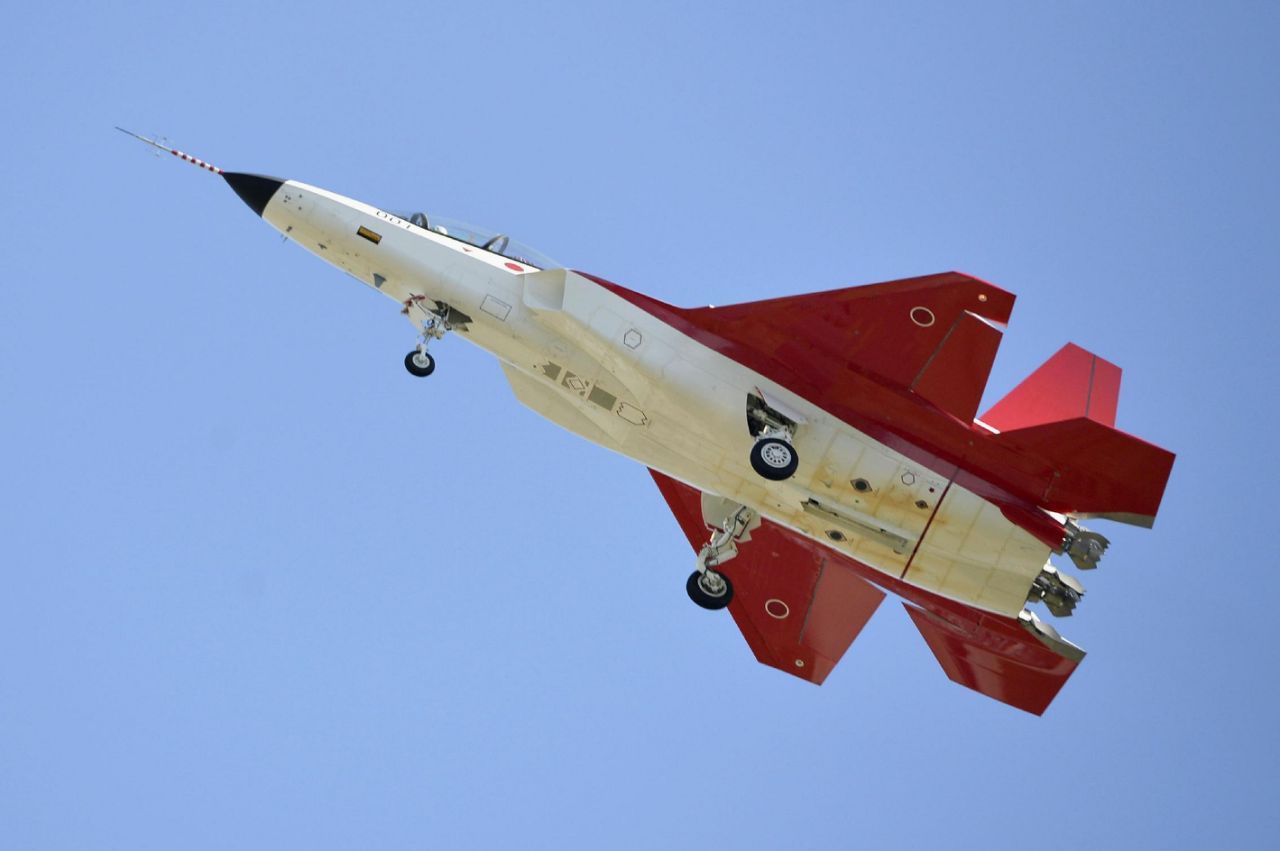
The first Airbus A321 aircraft produced for American Airlines at the Airbus U.S. Manufacturing Facility has flown for the first time.
On April 19, the A321 took off from the Mobile Aeroplex at Brookley in Mobile, Alabama, at 1:32 p.m. CDT, performed its test sequences, and landed safely at approximately 5:10 p.m. CDT.
The aircraft was flown by Test Pilots Mark McCullins and Bruce Macdonald. They were accompanied on the flight by Flight Test Engineer Nick Picconi, and Ground Test Engineer/Cabin Specialists Alexander Gentzsch and Mike Johns.The flight lasted approximately 3 hours and 40 minutes during which tests were performed on systems, engines and structure performance.
Following the flight, the aircraft will go through a few more weeks in final production before being delivered to American Airlines.
-
 Main AdminF-16 Fighting Falcons from the 148th Fighter Wing taxi on the flightline after arriving to Osan Air Base, Republic of Korea, April 20, 2016. The 148th FW out of Duluth Air National Guard Base, Minnesota, deployed 12 F-16 aircraft to Osan as part of a theater security package to enhance regional security on the Korea Peninsula. The U.S. Air Force routinely deploys force packages of fighters throughout the Republic of Korea to demonstrate the U.S. commitment to stability on the Korea Peninsula. (U.S. Air Force photo by Senior Airman Dillian Bamman/Released)
Main AdminF-16 Fighting Falcons from the 148th Fighter Wing taxi on the flightline after arriving to Osan Air Base, Republic of Korea, April 20, 2016. The 148th FW out of Duluth Air National Guard Base, Minnesota, deployed 12 F-16 aircraft to Osan as part of a theater security package to enhance regional security on the Korea Peninsula. The U.S. Air Force routinely deploys force packages of fighters throughout the Republic of Korea to demonstrate the U.S. commitment to stability on the Korea Peninsula. (U.S. Air Force photo by Senior Airman Dillian Bamman/Released)
An F-16 Fighting Falcon from the 148th Fighter Wing taxis on the flightline after arriving to Osan Air Base, Republic of Korea, April 20, 2016. The 148th FW out of Duluth Air National Guard Base, Minnesota, deployed 12 F-16 aircraft to Osan as part of a theater security package to enhance regional security on the Korea Peninsula. The U.S. Air Force routinely deploys force packages of fighters throughout the Republic of Korea to demonstrate the U.S. commitment to stability on the Korea Peninsula. (U.S. Air Force photo by Senior Airman Dillian Bamman/Released)
A CH-148 Cyclone helicopter moves into position over the flight deck of Her Majesty's Canadian Ship (HMCS) Montreal for refueling on April 20, 2016 off the coast of Nova Scotia.
Photo: Leading Seaman Dan Bard,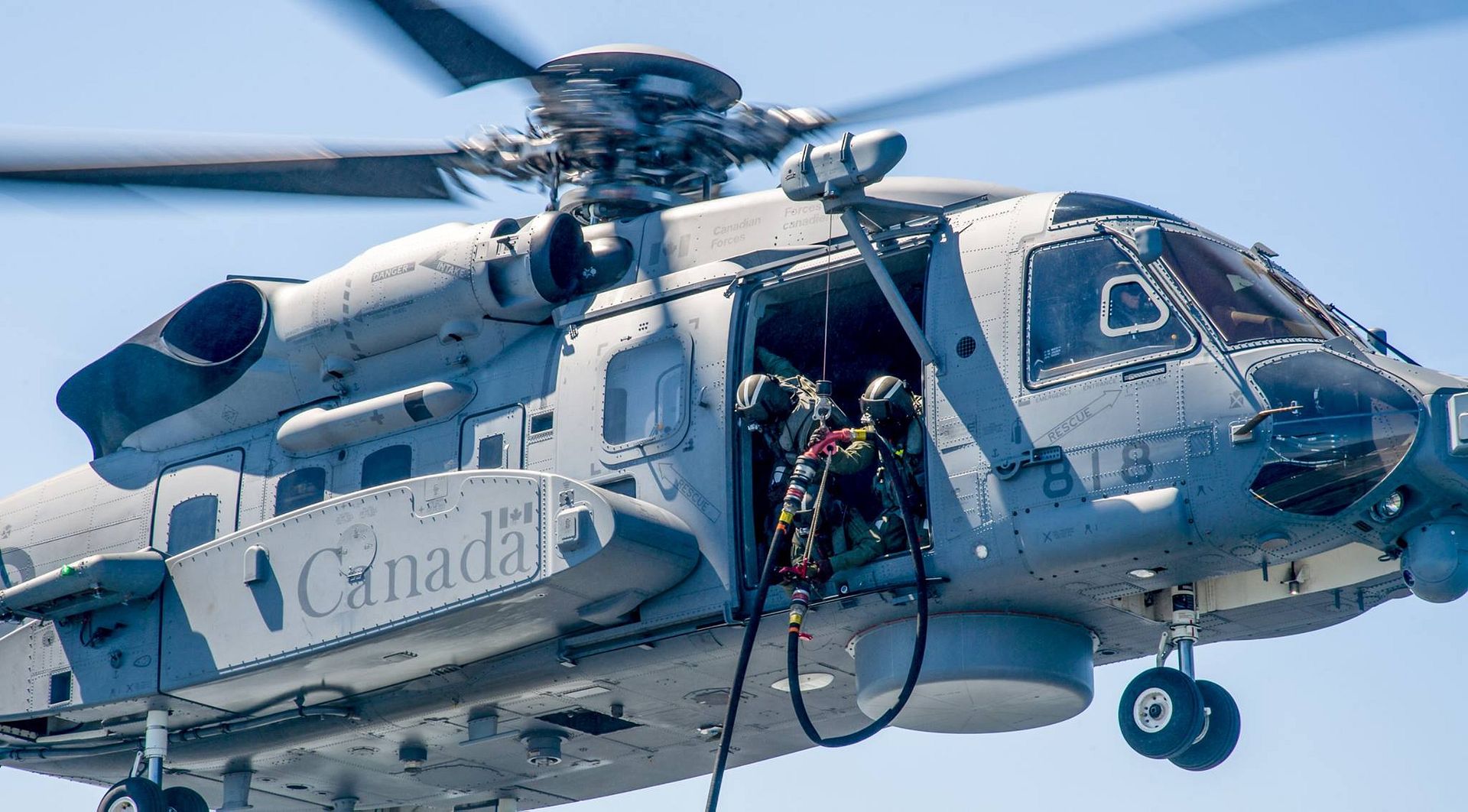
ATLANTIC OCEAN (April 22, 2016) A CH-53E Super Stallion lands on the flight deck aboard the amphibious assault ship USS Wasp (LHD 1). Wasp is underway with the Wasp Amphibious Ready Group participating in Amphibious Ready Group/Marine Expeditionary Unit Exercise. (U.S. Navy photo by Mass Communication Specialist Seaman Michael Molina/Released)
YATSUSHIRO BAY, Japan (April 22, 2016) An MV-22B Osprey from Marine Medium Tiltrotor Squadron (VMM) 265 (Reinforced) attached to the 31st Marine Expeditionary Unit approaches the destroyer helicopter ship JS Hyuga (DDH) 181. At request of the Japanese government, U.S. Forces Japan is providing airlift support to Japanese Self-Defense Forces (JSDF). A JSDF task force of more than 25,000 personnel is providing humanitarian and disaster relief assistance to the people affected by the magnitude 6.5 and 7.3 earthquakes that struck the Kumamoto area on 14 and 16 April 2016. (U.S. Navy photo by Mass Communication Specialist 1st Class James Mitchell/Released)
An A-10C Thunderbolt II with the 51st Fighter Wing at Osan Air Base, South Korea, takes off from Clark Air Base, Philippines, April 19, 2016. The A-10Cs flew as part of a newly stood up air contingent in the Indo-Asia-Pacific region. The air contingent will promote interoperability and provide greater and more transparent air and maritime situational awareness to ensure safety for military and civilian activities in international waters and airspace. (U.S. Air Force photo/Staff Sgt. Benjamin W. Stratton)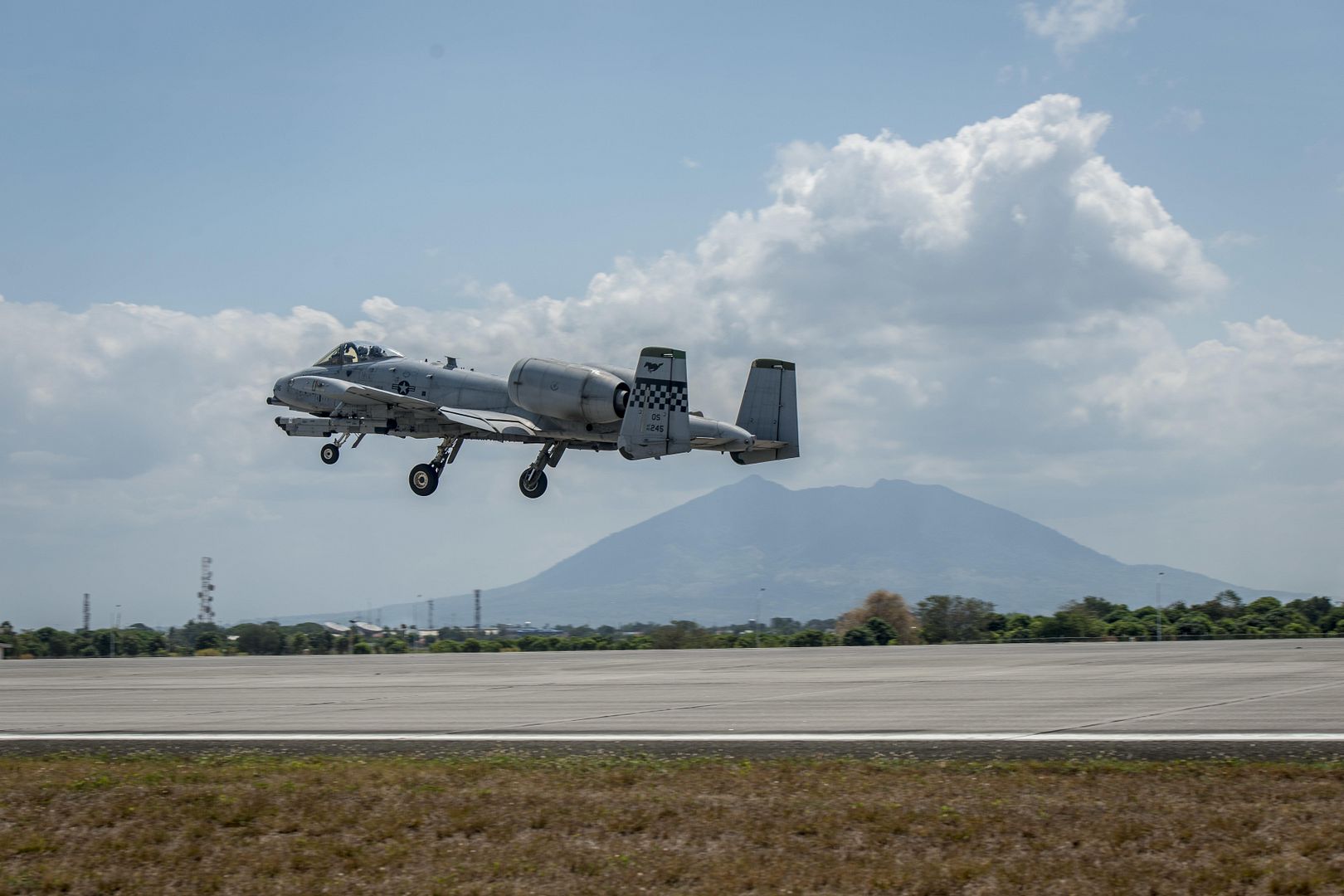
-
 Main AdminEight Air National Guard F-15C/D Eagle aircraft on the ramp before flying commences on the last day of Frisian Flag 2016, Leeuwarden Air Base, Netherlands, April 22, 2016. The Royal Netherlands Air Force exercise is designed to foster military cooperation between participating nations and these types of exchanges help establish trust and relationships, April 21, 2016.
Main AdminEight Air National Guard F-15C/D Eagle aircraft on the ramp before flying commences on the last day of Frisian Flag 2016, Leeuwarden Air Base, Netherlands, April 22, 2016. The Royal Netherlands Air Force exercise is designed to foster military cooperation between participating nations and these types of exchanges help establish trust and relationships, April 21, 2016.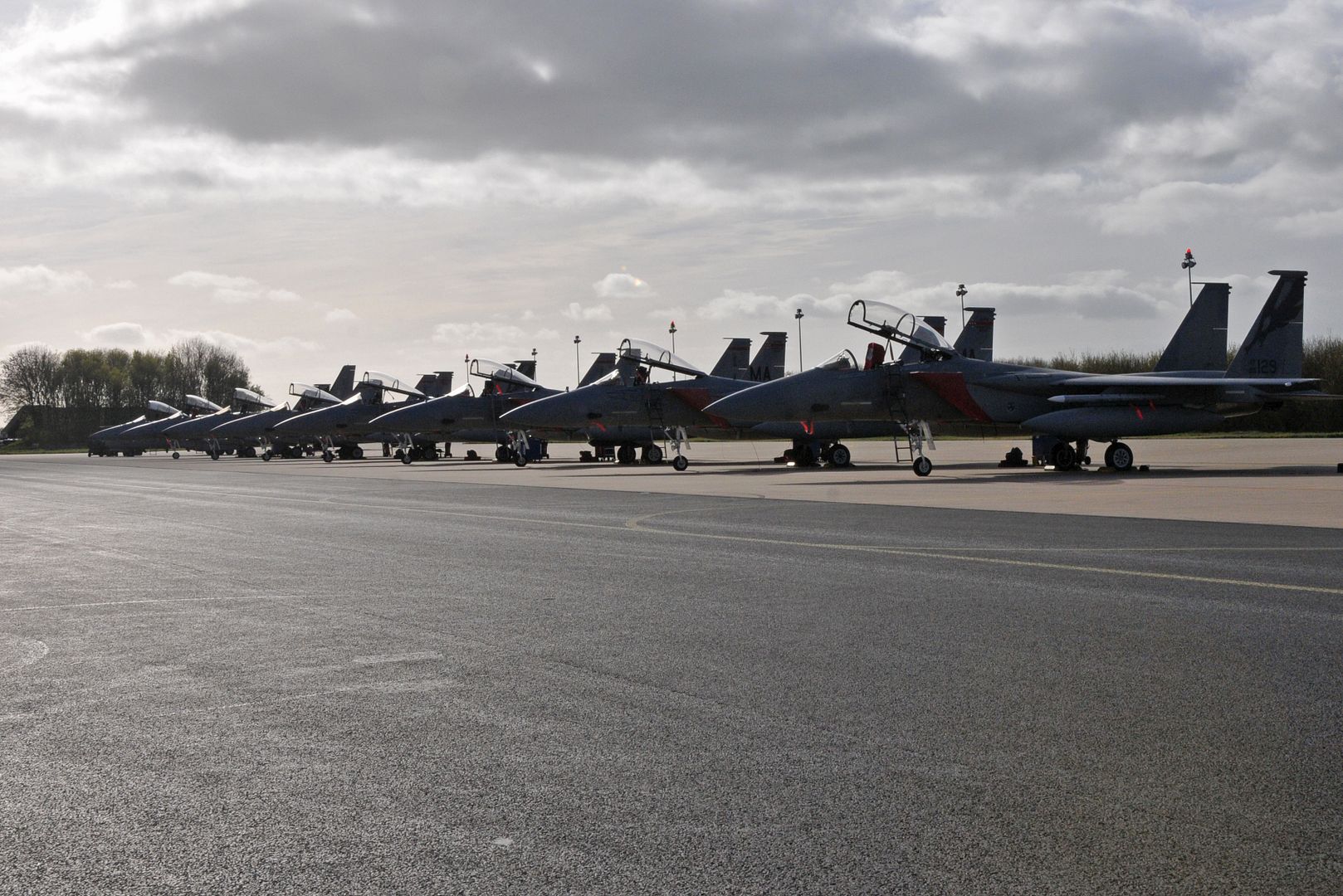
U.S. Air Force and Massachusetts Air National Guard public affairs officer 1st Lt. Bonnie Harper takes photos of F-15C Eagle aircraft taxing out for take-off during the Royal Netherlands Air Force Frisian Flag 2016 exercise, Leeuwarden Air Base, Netherlands, April 18, 2016. More than 70 aircraft and several hundred personnel from the United States, Netherlands, Belgium, France, Finland, Poland, Norway, United Kingdom, Germany and Australia are taking part.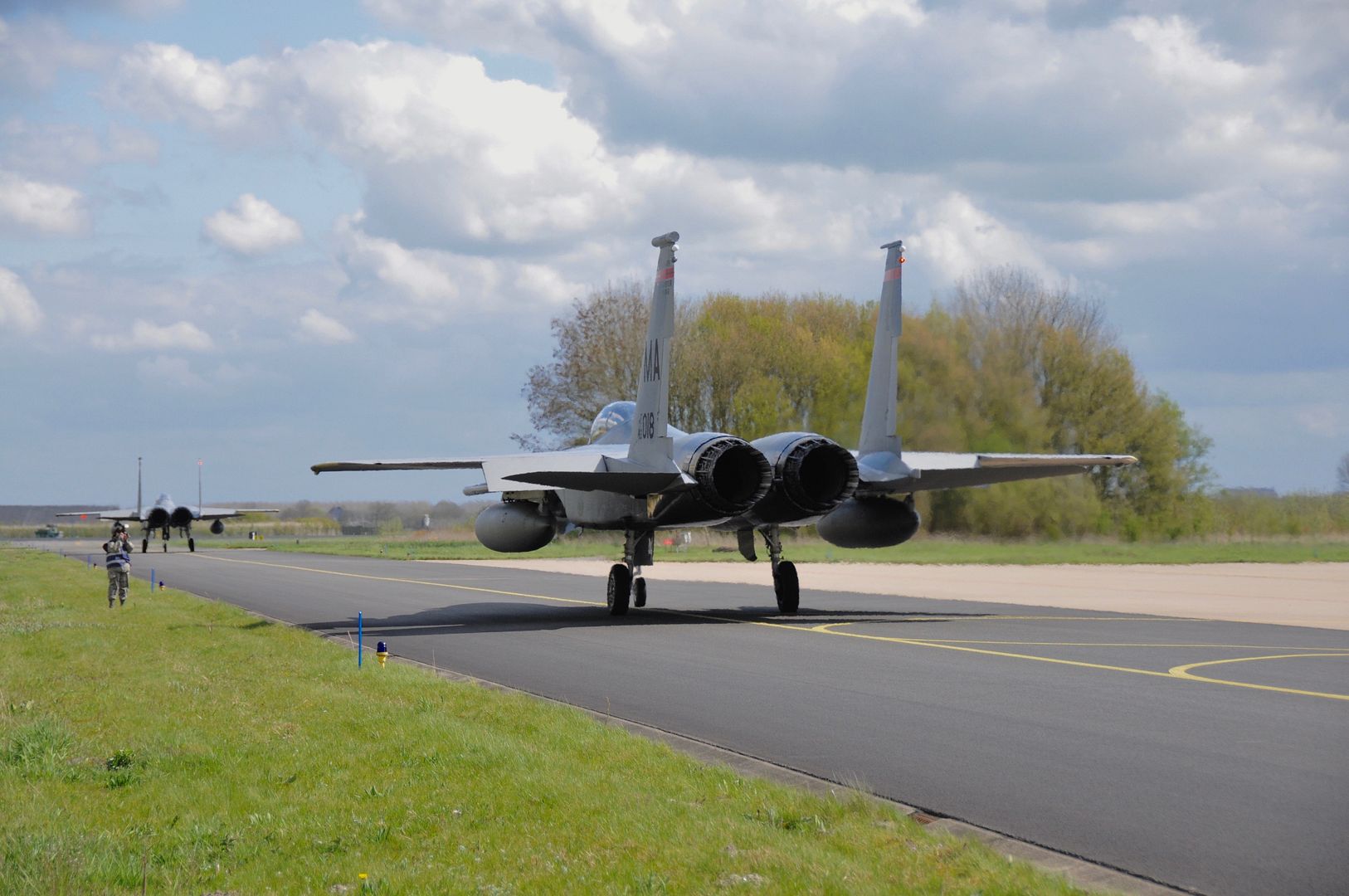
U.S. Air Force and Massachusetts Air National Guard crew chief marshals an F-15C Eagle aircraft during Frisian Flag 2016. The Royal Netherlands Air Force exercise is designed to foster military cooperation between participating nations and these types of exchanges help establish trust and relationships, April 21, 2016.
An F-22 Raptor lands during the AirPower over Hampton Roads Open House at Langley Air Force Base, Va., April 23, 2016. The F-22, a critical component of the Global Strike Task Force, is designed to project air dominance, rapidly and at great distances, and defeat threats attempting to deny access to our nation's Coast Guard, Air Force, Army, Navy and Marine Corps. (U.S. Air Force photo by Senior Airman Kayla Newman)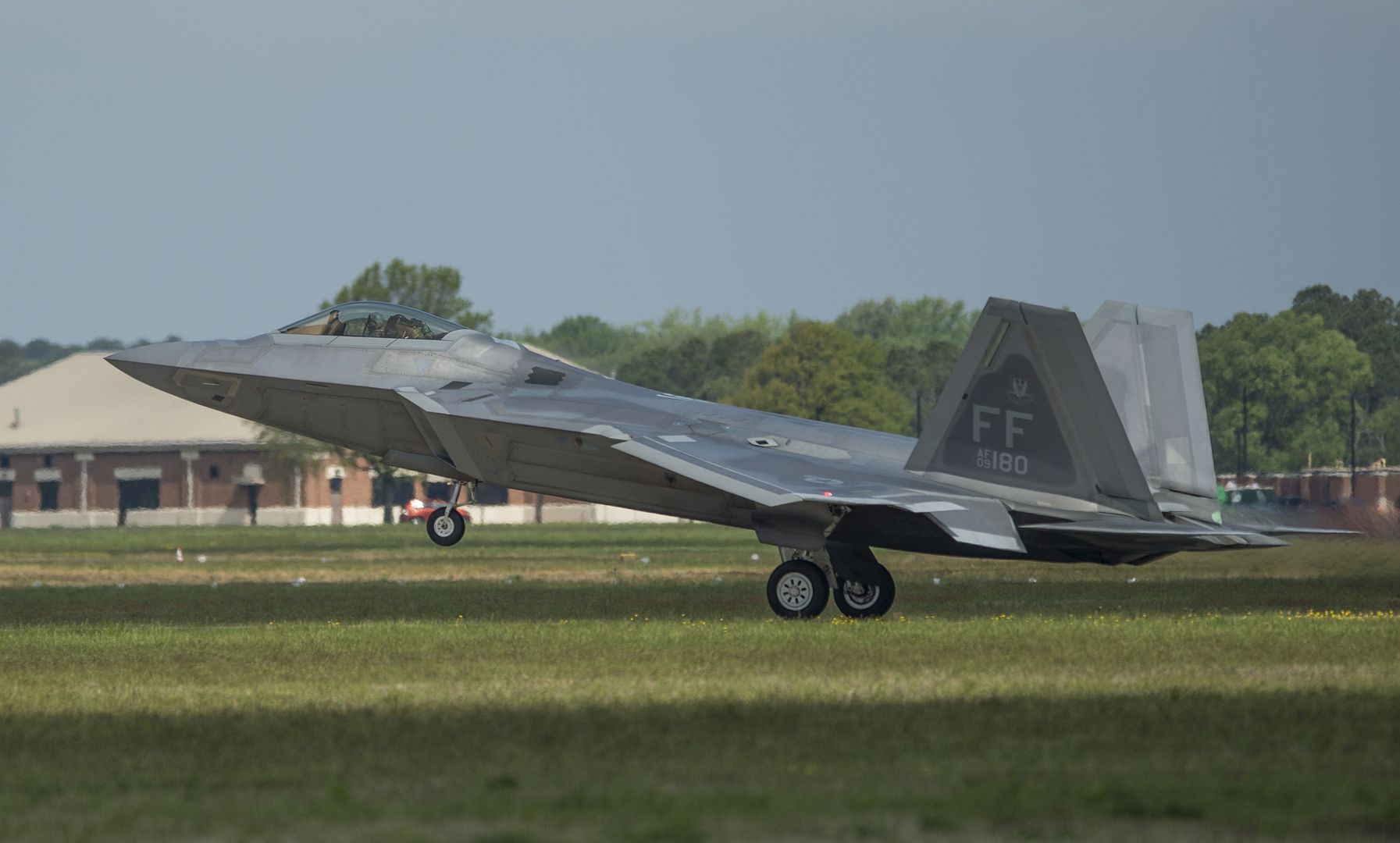
Two U.S. Air Force F-22 Raptors and a T-38 Talon fly in formation during the AirPower over Hampton Roads Open House at Langley Air Force Base, Va., April 23, 2016. This air show marks the first of its kind at the base in five years. (U.S. Air Force photo by Staff Sgt. Natasha Stannard)
Norwegian fighter jet helps save dying patient
Quick-thinking medical staff in Norway saved a patient's life by calling in an F-16 fighter jet to whisk life saving medical equipment from one hospital to another, media reports said on Friday.
The patient was fighting for his life and without a special lung and heart procedure - called extracorporeal membrane oxygenation (ECMO) - he would die.
But the hospital in the town of Bodo in central Norway, where he was being treated, had neither the equipment nor the skills to carry out the complex last-ditch treatment.
A hospital in Trondheim, about 450 kilometres to the south, did, however, have a machine available.
Staff there contacted the air force on April 4th for help in transporting the equipment - a request that came in just as two F-16 fighter jets were getting ready to take off from an airbase near Trondheim, the reports said.
"They didn't ask any questions, except for what size the machine was," Anders Wetting Carlsen, chief doctor at Trondheim's Saint Olaf hospital, told AFP.
In a stroke of good luck, one of the fighter jets was equipped with an external hold that allowed it to transport equipment. The machine was loaded onto the aircraft, which made for Bodo at top speed.
"Usually we cover that distance in 35 minutes," air squadron head Borge Kleppe told Norwegian daily Verdens Gang.
"But given the special nature of the cargo, the pilot stepped on it and arrived at the destination less than 25 minutes later," he added.
-
 Main AdminU.S. Navy Blue Angels performed at the Air Power Expo, April 23, at Naval Air Station Fort Worth Joint Reserve Base, Texas. During the expo, F/A-18 Hornets were joined by Fat Albert, the Blue Angels' C-130, and the U. S. Army Parachute Team, the Golden Knights, among other performers who celebrated the 50th anniversary of the ending of the Vietnam War. (U.S. Navy photo by Mass Communication Specialist 2nd Class Jonathan Vargas/Released)
Main AdminU.S. Navy Blue Angels performed at the Air Power Expo, April 23, at Naval Air Station Fort Worth Joint Reserve Base, Texas. During the expo, F/A-18 Hornets were joined by Fat Albert, the Blue Angels' C-130, and the U. S. Army Parachute Team, the Golden Knights, among other performers who celebrated the 50th anniversary of the ending of the Vietnam War. (U.S. Navy photo by Mass Communication Specialist 2nd Class Jonathan Vargas/Released)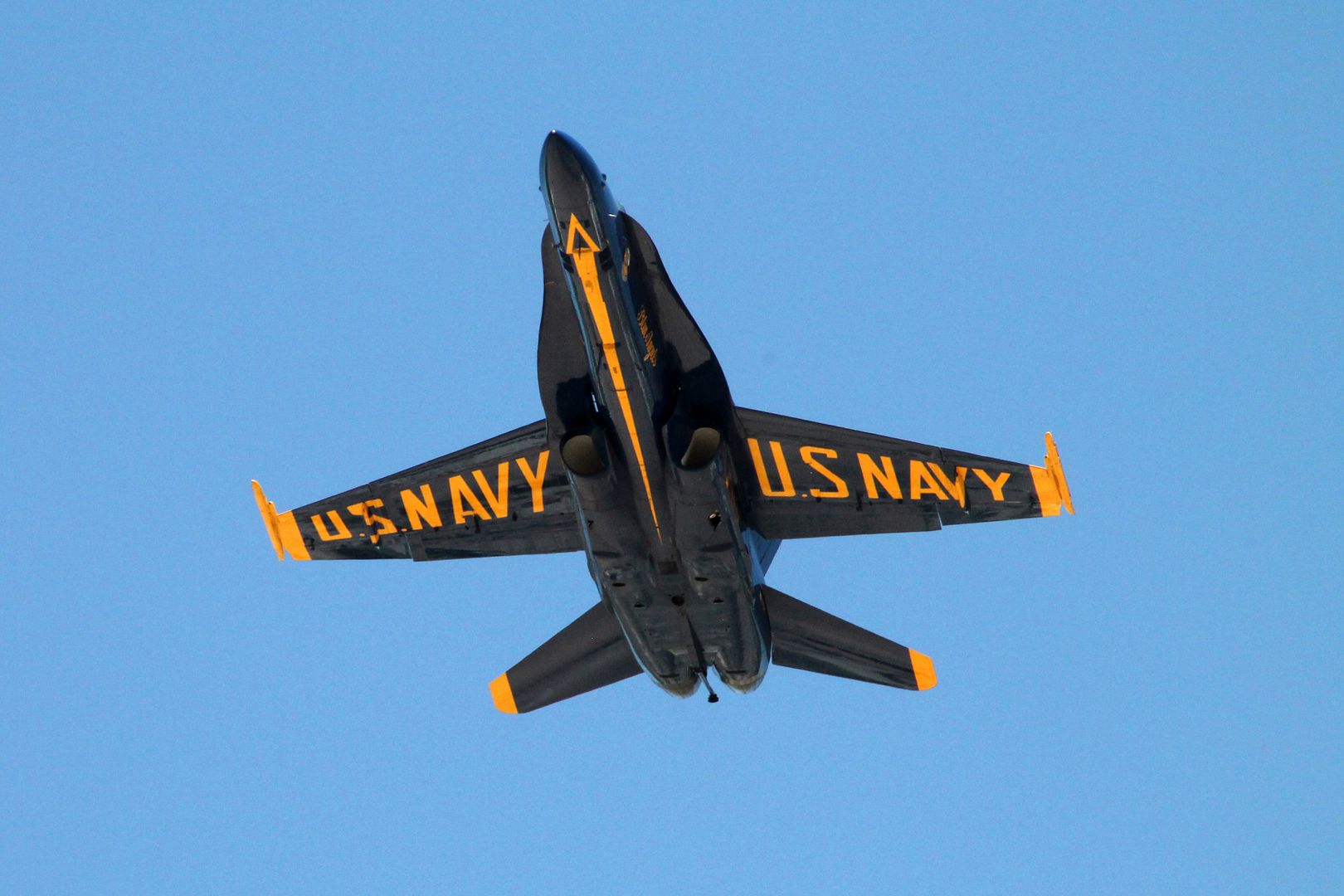
-
 Main AdminSouth Carolina Army National Guard AH-64D Apache helicopters from the 1-151st Attack and Reconnaissance Battalion, S.C Army National Guard, depart to Ft. Stewart, Ga., for gunnery qualifications and annual training from McEntire Joint National Guard Base, Eastover, S.C. April 23, 2016. (U.S. Army National Guard Photo by Staff Sgt. Roby Di Giovine/Released)
Main AdminSouth Carolina Army National Guard AH-64D Apache helicopters from the 1-151st Attack and Reconnaissance Battalion, S.C Army National Guard, depart to Ft. Stewart, Ga., for gunnery qualifications and annual training from McEntire Joint National Guard Base, Eastover, S.C. April 23, 2016. (U.S. Army National Guard Photo by Staff Sgt. Roby Di Giovine/Released)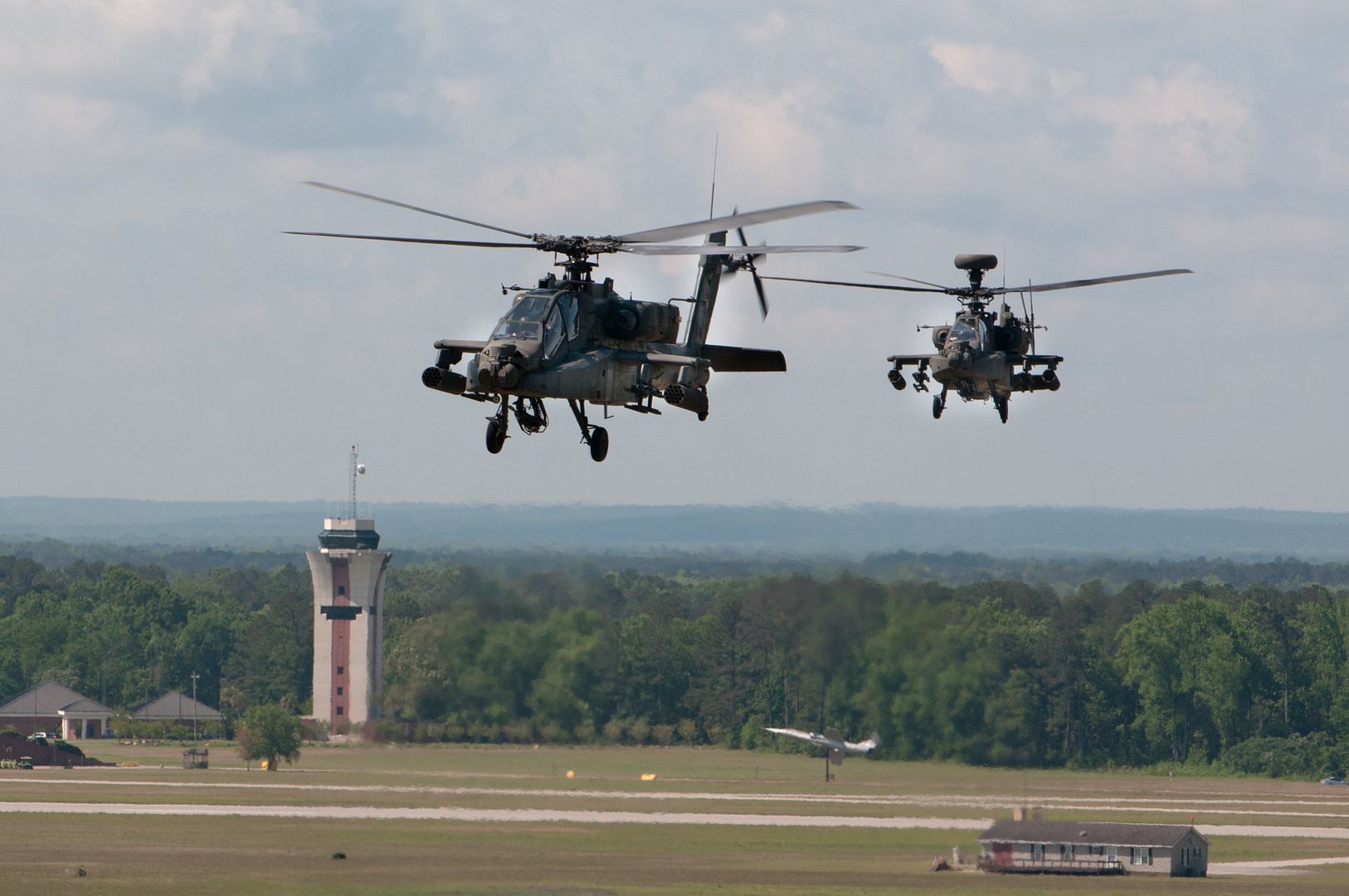
ATLANTIC OCEAN (April 23, 2016) A T-45C Goshawk, assigned to Training Air Wing (TW) 1, lands on the flight deck of the aircraft carrier USS George Washington (CVN 73). Washington, homeported in Norfolk, is underway conducting carrier qualifications in the Atlantic Ocean. (U.S. Navy photo by Mass Communication Specialist Seaman Apprentice Krystofer N. Belknap/Released)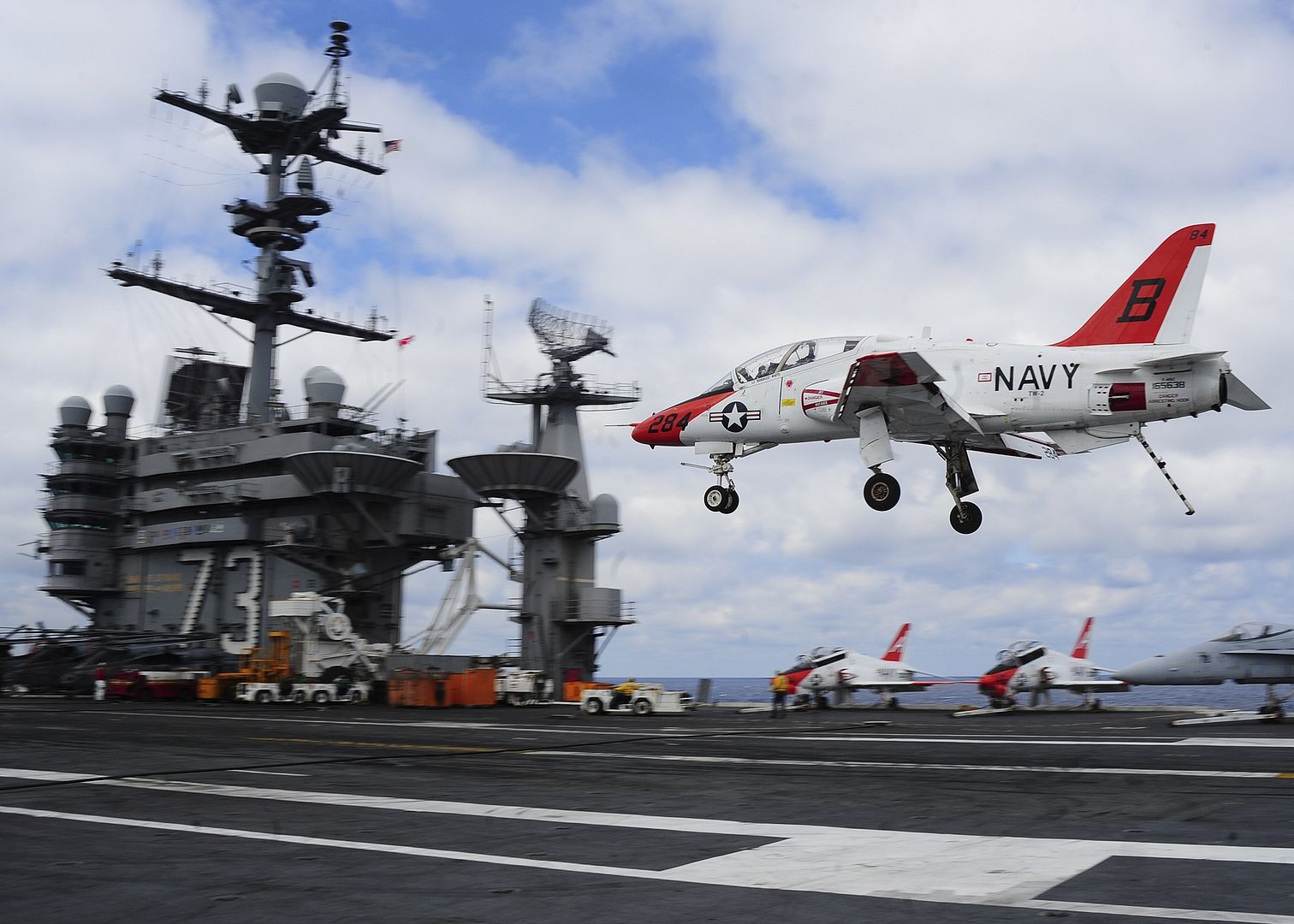
The U.S. Air Force Thunderbirds aerial demonstration team performs during the AirPower over Hampton Roads Open House at Langley Air Force Base, Va., April 24, 2016. The Thunderbirds were the finale of the show that featured the future, present and past of air power capabilities. (U.S. Air Force photo by Staff Sgt. Natasha Stannard)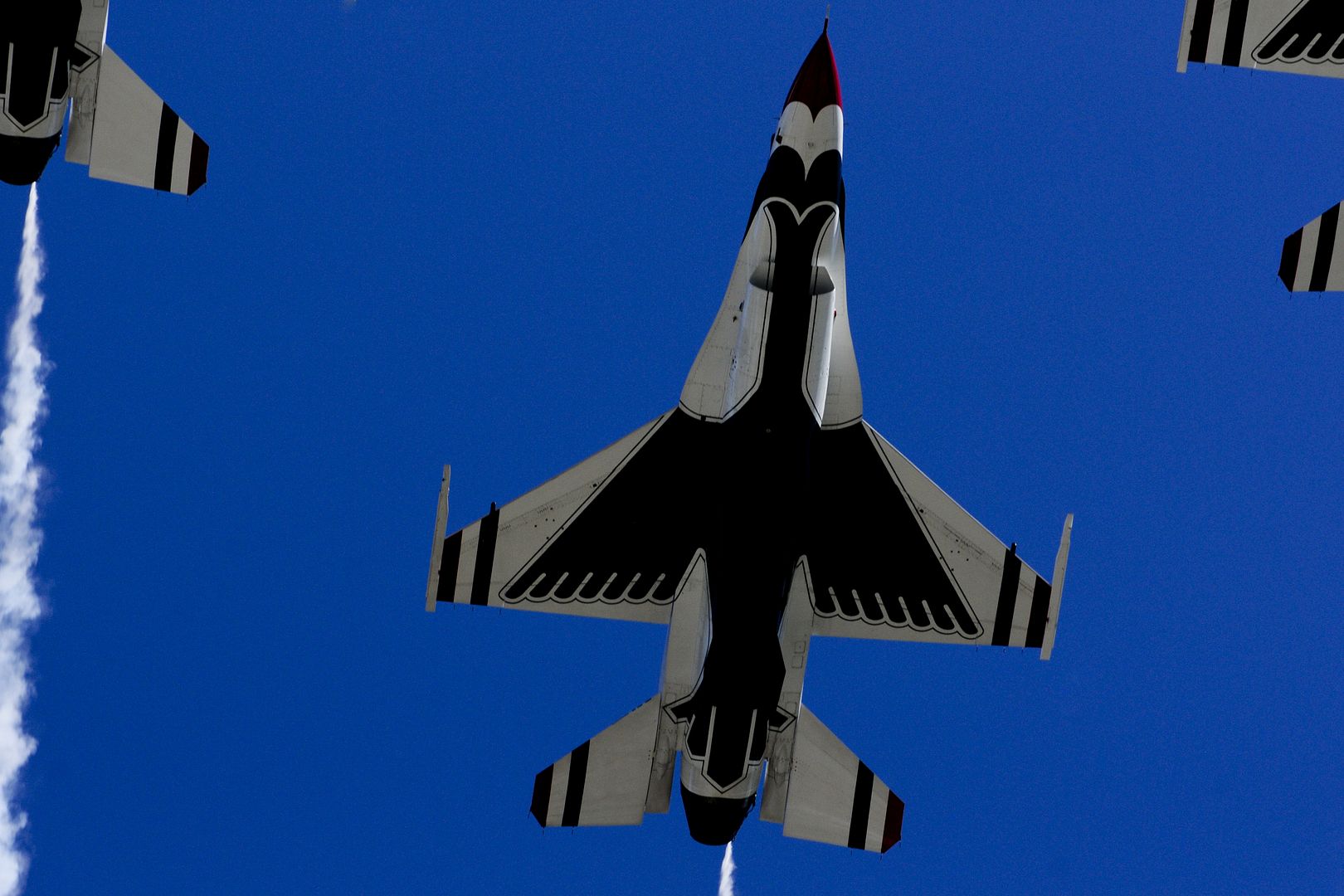
An F-22 Raptor performs in front of a crowd during the AirPower over Hampton Roads Open House at Langley Air Force Base, Va., April 24, 2016. The Raptor is stationed at Langley and travels around the country displaying its unique capabilities. (U.S. Air Force photo by Senior Airman Kayla Newman)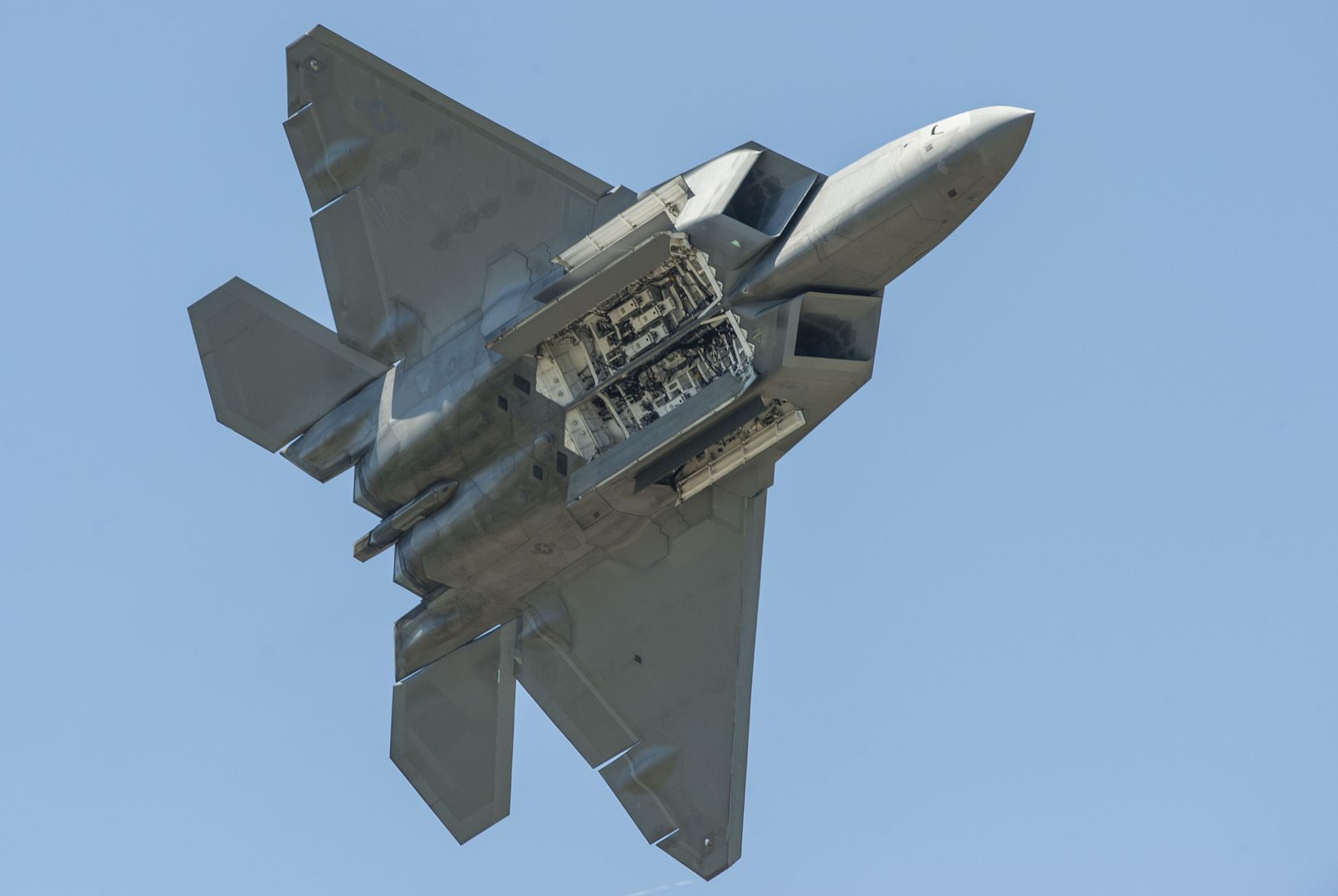
An F-22 Raptor, F-35 Lighting and P-51 Mustang fly in formation as part of the U.S. Air Force Heritage Flight during the AirPower over Hampton Roads Open House at Langley Air Force Base, Va., April 24, 2016. The Heritage Flight presents the evolution of Air Force air power by flying today?s state-of-the-art aircraft in formation with vintage fighter aircraft. (U.S. Air Force photo by Senior Airman Kayla Newman)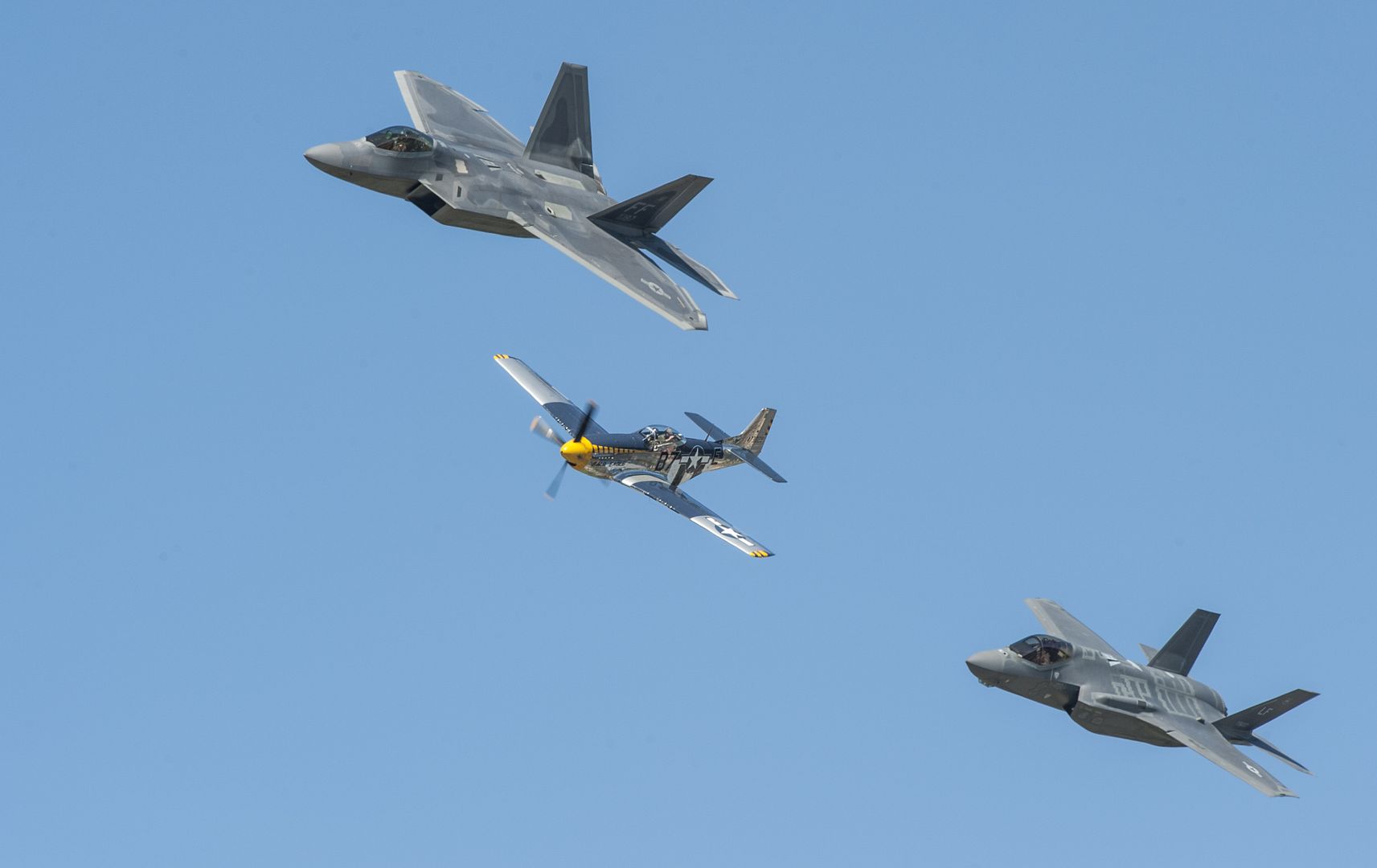
An F-35 Lightning II from the 61st Fighter Squadron deploys a GBU-12 500-pound laser- guided bomb for the first time in the squadron's history April 25, 2016, at the Barry M. Goldwater Range in Gila Bend, Ariz. Three F-35s successfully delivered six inert GBU-12s during the practice sortie, making the 61st FS the second squadron at Luke Air Force Base to drop bombs from the F-35. (U.S. Air Force photo by Airman 1st Class Ridge Shan)
EVERETT, Wash., April 26, 2016 ? With a successful first flight on April 25th, Boeing [NYSE: BA] has added the fourth and final flight test aircraft to the KC-46 Pegasus fleet, a 767-2C.
During the 1 hour, 40 minute flight, test pilots performed operational engine checks, flight controls and environmental systems checks and took the 767-2C to a maximum altitude of 39,000 feet prior to landing at Boeing Field, south of Seattle.
The 767-2C is a KC-46 without the aerial refueling system installed. This aircraft, known as EMD-3, will be used to conduct environmental control system testing, including hot day/cold day testing and smoke penetration testing.
As part of the contract awarded in 2011 to design and develop the U.S. Air Force?s next-generation tanker, Boeing has built four test aircraft ? two are configured as 767-2Cs and two as KC-46 tankers. Eventually, both 767-2Cs will become KC-46 tankers.
EMD-1, the first 767-2C test aircraft, has completed more than 315 flight test hours since its first flight in December 2014. EMD-2, the program?s first KC-46 tanker, made its maiden flight in September 2015 and has completed more than 240 flight test hours, including refueling F-16, F/A-18 and AV-8B aircraft. It also has been refueled by a KC-10 tanker. EMD-4, the second tanker, first flew on March 2, 2016 and has completed 25 flight hours.
Boeing plans to build 179 KC-46 aircraft for the U.S. Air Force.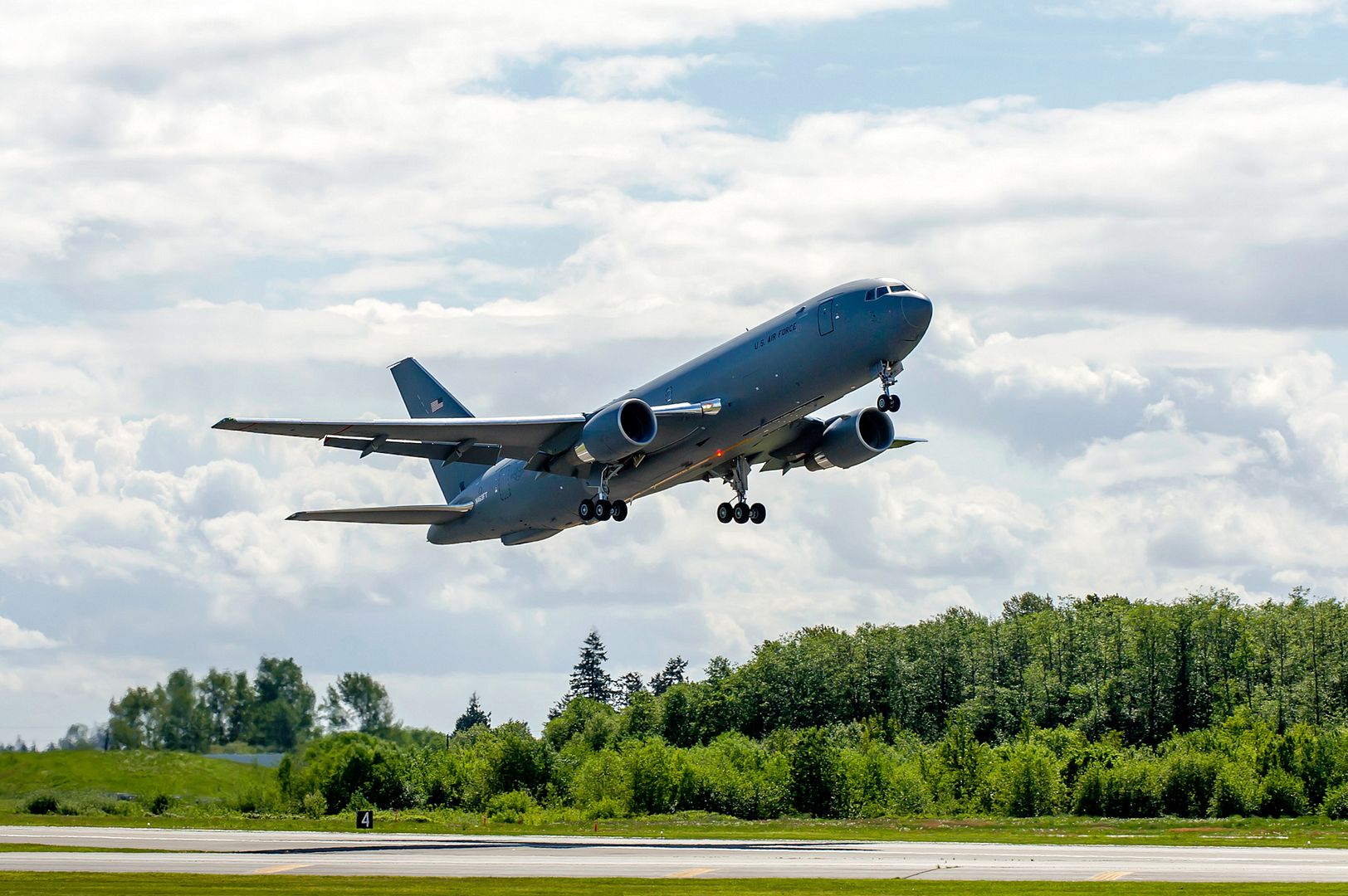
25 April 2016 Press Release
The first ever delivery of an aircraft from the Airbus U.S. Manufacturing Facility took place today, April 25th, in Mobile, Alabama. The entire team of employees from the American assembly line gathered to present their very first completed product, an Airbus A321, to JetBlue. On hand for the occasion were executives from Airbus, JetBlue senior management, including President and CEO Robin Hayes, and a broad collection of dignitaries from the Gulf Coast region.
?I am immensely proud to be here to participate in this first delivery from Mobile,? said John Leahy, Airbus Chief Operating Officer ? Customers. ?Going from breaking ground on this facility three years ago to handing over the first Alabama-produced A321 today is an amazing accomplishment. It?s a testament to how well executed this project was and how strong the teamwork has been here in Mobile and throughout Airbus. The Airbus U.S. Manufacturing Facility has brought together all the best aspects of our other assembly lines around the world, and it shows how Airbus people work hand in hand with our partners to deliver great aircraft to our customers.?
Airbus announced its commitment to build a single-aisle assembly line in Mobile, Alabama in 2012, and less than one year later, broke ground on the $600 million (U.S.) facility. The ceremonial inauguration of the plant came in September 2015. The aircraft delivered today, a JetBlue A321, successfully had its first flight on March 21st, 2016.
In addition to the JetBlue A321 delivered today, there are currently nine other A320 Family aircraft in production at the facility. Airbus anticipates delivering four aircraft per month from the Mobile plant by the end of 2017. The initial deliveries will all be A320 Family aircraft with the Current Engine Option (CEO), but will begin transitioning to New Engine Option (NEO) derivatives in late 2017.
In addition to hundreds of new Airbus jobs the project has brought to the local community, the Mobile area has seen many Airbus suppliers open new facilities in the region, providing even more employment and a parallel boost to the local economy. Airbus is proud to boast that 87 percent of its new employees are from the Gulf Coast region, with nearly one third being U.S. military veterans.
Demonstrating the adage ?The Sun Never Sets on Airbus? ? Airbus aircraft are now produced around the clock, 24 hours a day, at facilities in: Mobile, Alabama; Hamburg, Germany; Toulouse, France; and Tianjin, China.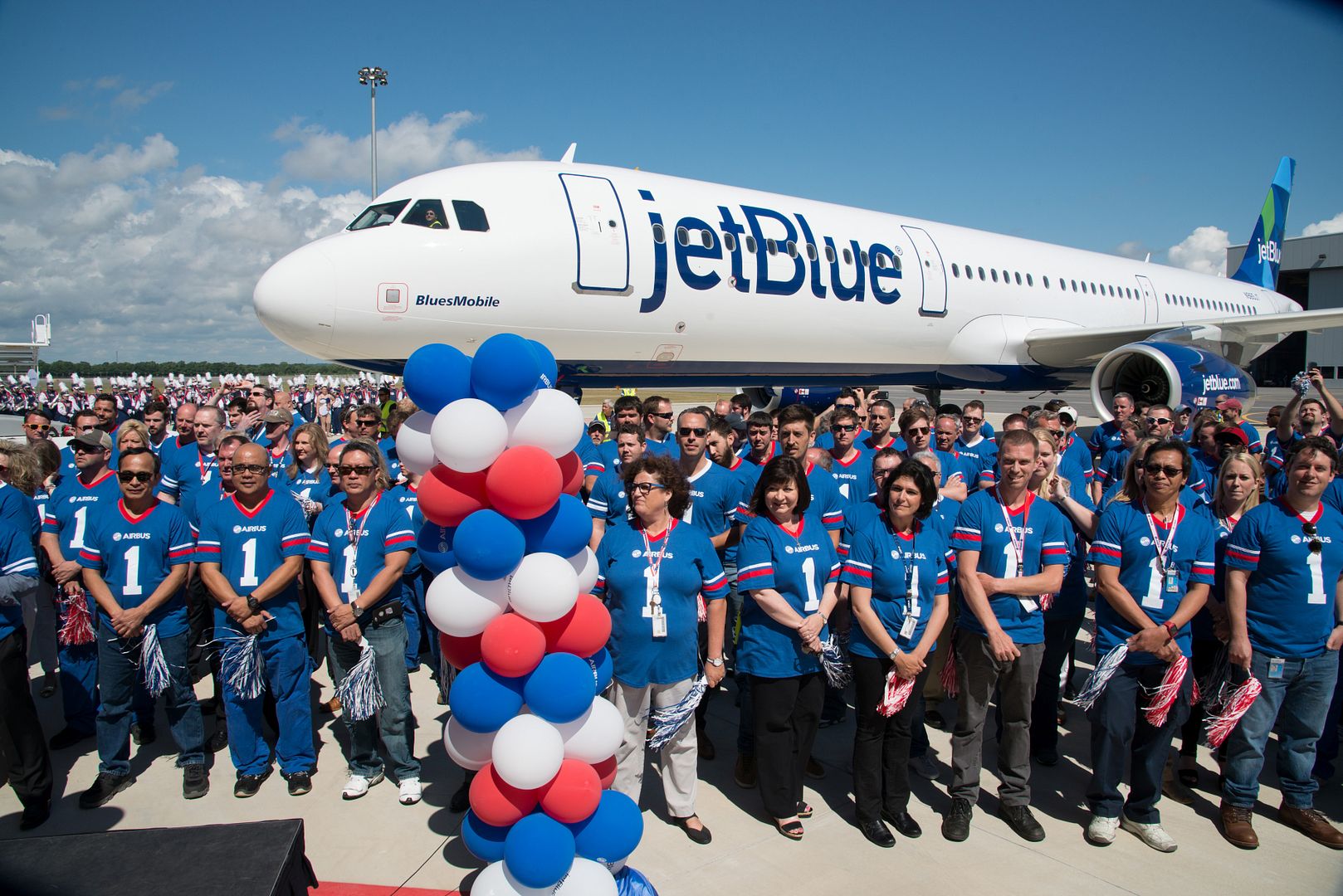
-
 Main Admin26 April 2016
Main Admin26 April 2016
Following months of training, the Royal Air Force Aerobatic Team was formally awarded its Public Display Authority (PDA) earlier today. It is the final assessment before the Red Arrows are allowed to begin their latest season.
The team, which showcases the excellence of the Royal Air Force and represents the United Kingdom, will now embark on its 52nd display season ? performing to millions of individuals across the country and overseas.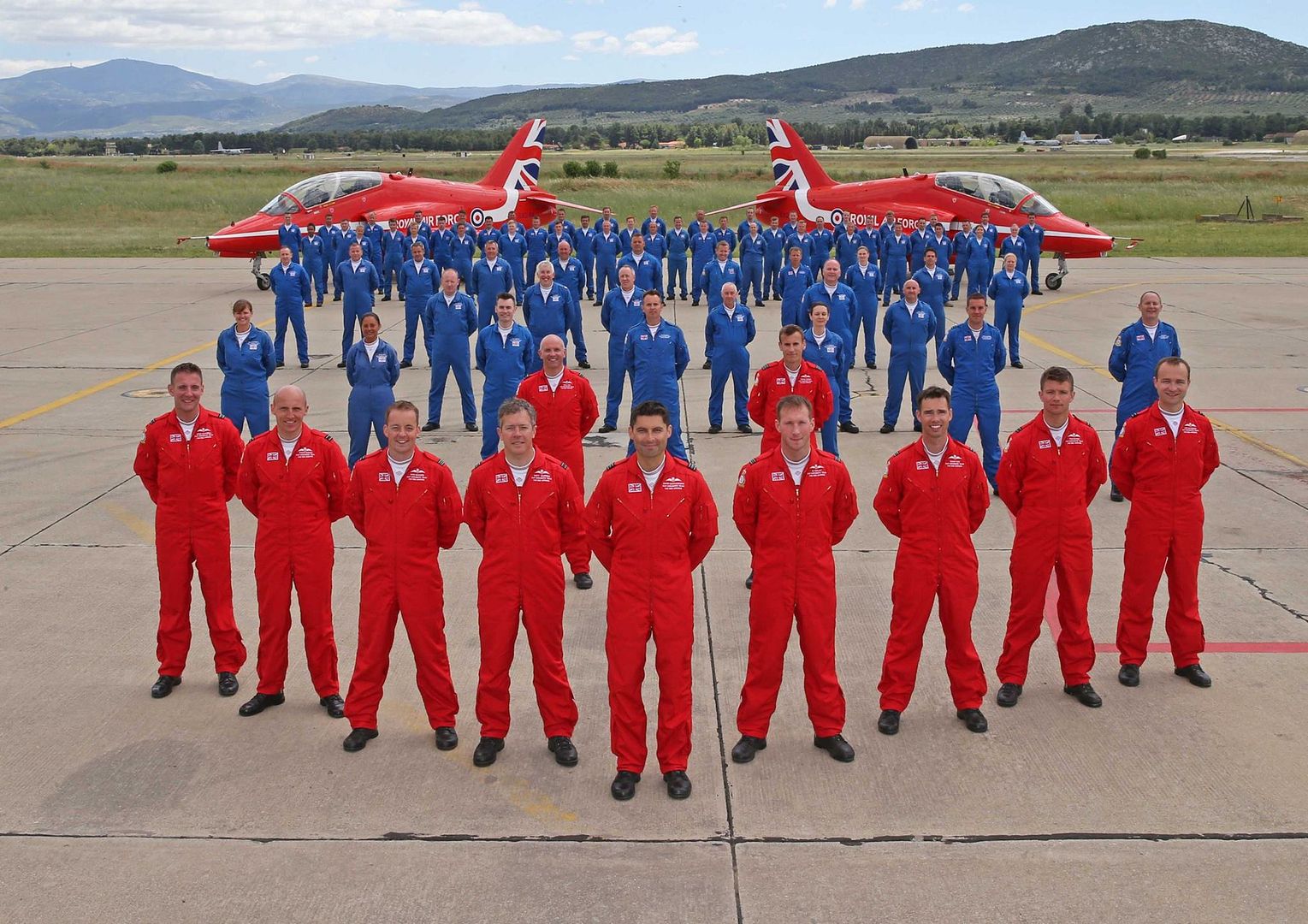
Squadron Leader David Montenegro, Team Leader and Red 1, said: ?Public Display Authority is a very important day in the Red Arrows? calendar as it signifies the end of many months of training.
?We reflect on the efforts from the whole team that have gone into accomplishing the accolade of being ready to display for the UK and global public.
?Everyone on the Red Arrows has a role to play in our winter training months ? we have 18-year-old technicians who are on their first detachment with the team, indeed within the Royal Air Force, and who have being honing their engineering skills throughout the past months and have enabled the air crew to fly our aircraft. ?There are also squadron transport drivers who have covered thousands of miles delivering spare parts for the aircraft around the UK and mainland Europe. ?Furthermore, there are two new team pilots, Reds 2 and 3. In short, PDA is the culmination of teamwork and more than 150 demanding training sorties.?
Following the approval, the pilots were allowed to change from their green coveralls, used during training, into their famous red flying suits, which are worn during the season. The Squadron's support staff, who number more than 100 and include engineering technicians, administrators, photographers and others, also changed their coveralls, into their royal blue flying suits. The team ? famous for flying nine British-built Hawk fast-jets ? changes its display every year, with the 2015 routine seen by more than 15 million people at events and shows across a five-month season.
Sqn Ldr Montenegro, who is responsible for running the training programme and creating the show, said: ?On every RAF squadron, innovation is always the key to success and the Red Arrows are unveiling some innovative new manoeuvres for the watching public this year.
?The arrival into the 2016 show is called Wall, which sees the widest Red Arrows formation flown for many years rapidly transforming into the closest of all our shapes while flying a loop.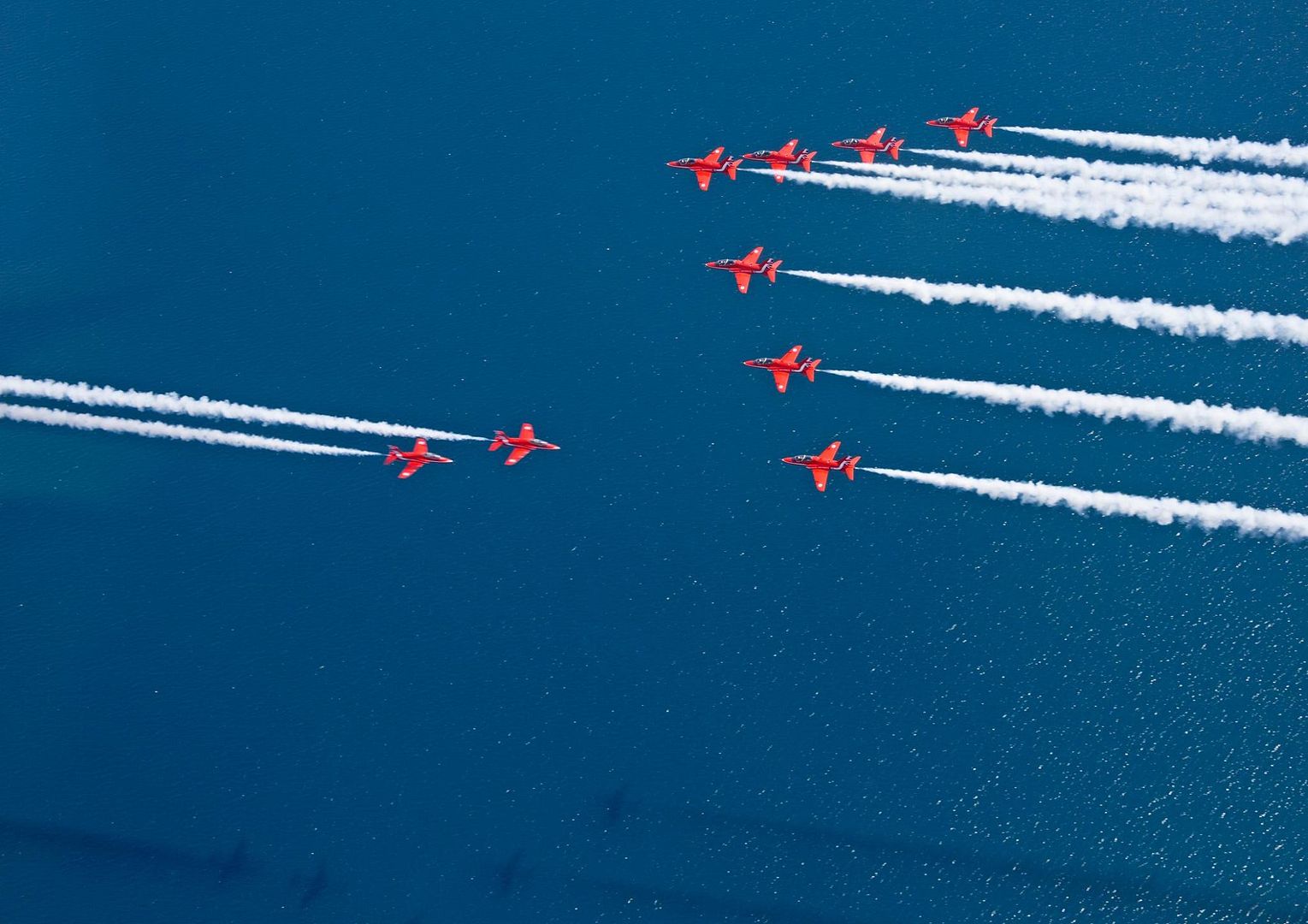
?Another new move is Tornado and celebrates 25 years of continual operational service of the RAF?s Tornado force and displays Reds 8 and 9 rolling around the rest of the team.
?Also, we have the Double Goose, which is a move flown by the team many years ago which presents seven aircraft in a pyramid formation while the Synchro Pair ? Reds 6 and 7 ? fly right through the middle, at a closing speed of 750mph.?
Preparations for the new season began in October, when training commenced at the Red Arrows? home base of RAF Scampton in Lincolnshire. Pilots fly three times a day, five days a week, beginning with small groups of three or four aircraft. The training develops until the team?s full nine-ship formation comes together in February. The final part of the PDA process took place at the Hellenic Air Force Base (HAF) in Tanagra, Greece, this week.
Here, the Red Arrows have been carrying out overseas training, known as Exercise Springhawk ? making full use of the area?s fine weather conditions to allow the team to perfect its 23-minute show.
The Royal Air Force?s Deputy Commander Operations, Air Marshal Greg Bagwell, and Air Officer Commanding 22 Training Group, Air Vice-Marshal Andrew Turner, scrutinised all aspects of the team on the ground and in the air, including several displays over two days.
The arrival into the 2016 show sees the widest Red Arrows formation flown for many years rapidly transforming into the closest of all the team?s shapes while flying a loop.PDA is only awarded when the senior officers are satisfied of the highest safety standards and that the team is performing a display that is a credit to both the Service and United Kingdom.
The latest season is the first as Red Arrows pilots for the team?s newest recruits ? Reds 2 and 3, Flight Lieutenants Matt Masters and Si Taylor ? who will stay with the Squadron for three years.
All Red Arrows pilots are from frontline squadrons and, before joining the team, operated jets such as the Tornado or the Typhoon, helping the Royal Air Force to secure the skies and protect the United Kingdom and its interests at all hours, 365 days a year.
The Red Arrows will return to their home base later this week. The 2016 team?s first major public show is on Sunday, May 8, at Shuttleworth, Bedfordshire. It is one of 80 displays planned this year.
Sqn Ldr Montenegro said: ?We cannot wait to entertain, captivate and inspire our audiences this year. We are extremely proud to represent the RAF and the UK and hope you enjoy our display.?
Editor: Andrew Morton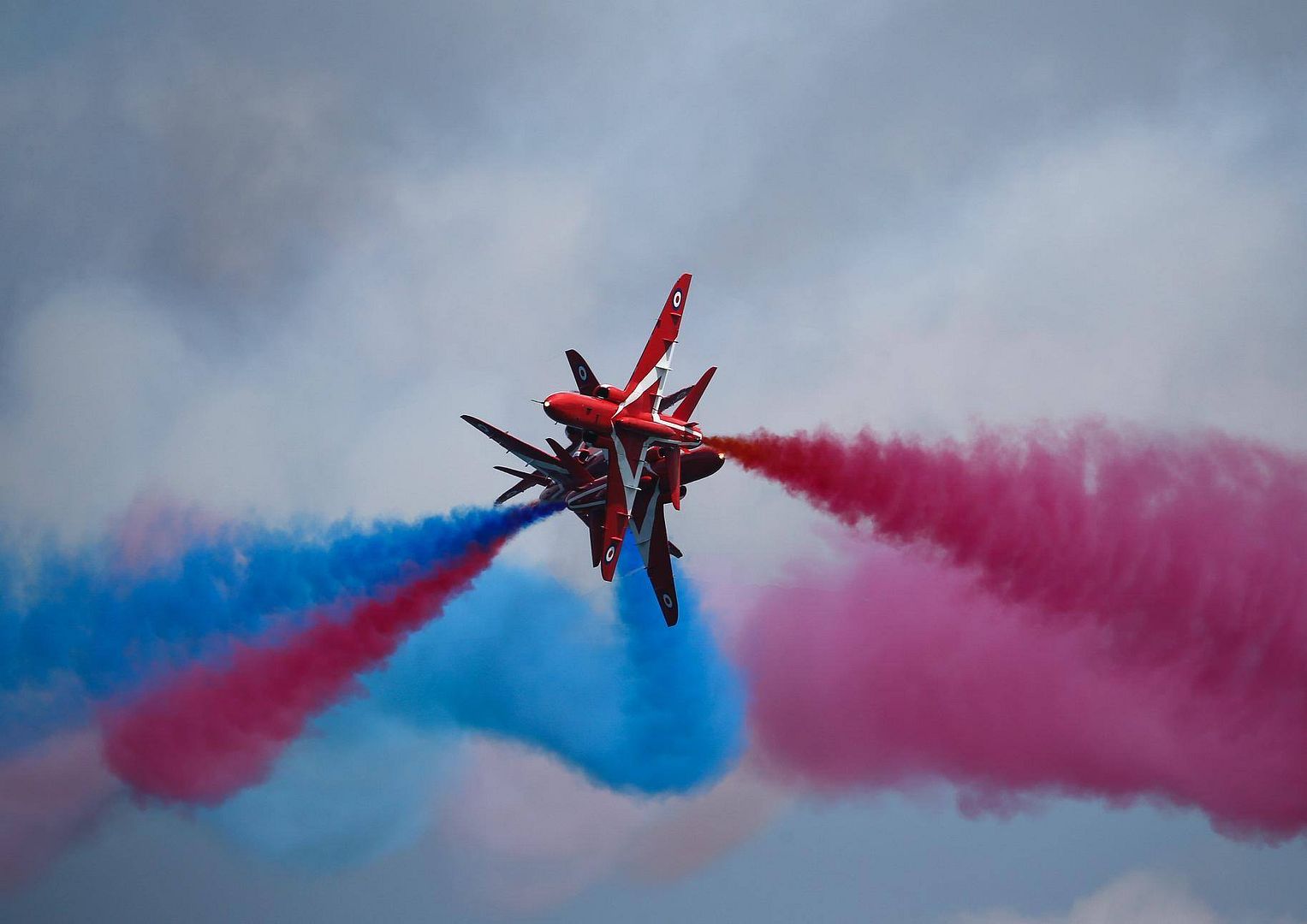
ARABIAN GULF (April 24, 2016) An F/A-18E Super Hornet, assigned to the ?Pukin? Dogs? of Strike Fighter Squadron (VFA) 143, launches from the flight deck of aircraft carrier USS Harry S. Truman (CVN 75). Harry S. Truman Carrier Strike Group is deployed in support of Operation Inherent Resolve, maritime security operations, and theater security cooperation efforts in the U.S. 5th Fleet area of operations. (U.S. Navy photo by Mass Communication Specialist 3rd Class Bobby J Siens/Released)
An U.S. Air Force C-130J Hercules assigned to the 86th Airlift Wing from Ramstien Air Base, Germany prepares to take flight in route to the Marrakech Airshow in Morocco on Apr. 26, 2016. The six member Air Force crew are displaying their aircraft in the air expo as a gesture of partnership with the host Moroccan nation and a way to promote regional security throughout the continent of Africa. (DoD News photo by TSgt Brian Kimball)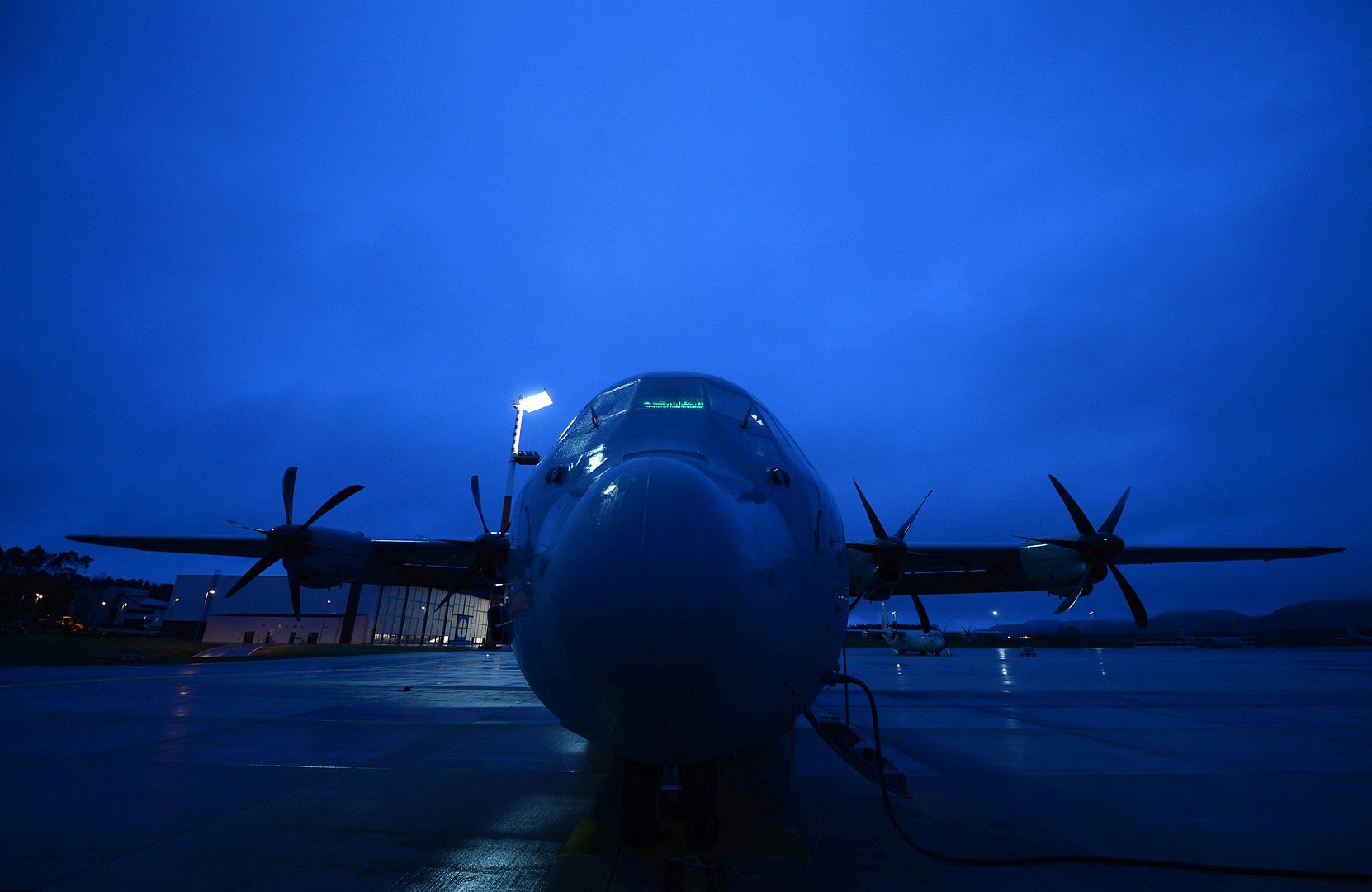
U.S. Air Force Captain Frank Zientek (left) and U.S. Air Force 1st Lieutenant Christopher Reith (right), pilots with the 37th Airlift Squadron, complete their pre-flight checks for a C-130J Hercules prior to take off from Ramstein Air Base, Germany on Apr. 26, 2016. Capt. Zientek and 1st Lt. Reith are part of a six-man flight crew entrusted with transporting the aircraft to the 2016 International Marrakech Airshow in Morocco and showcasing the aircrafts capabilities. (DoD News photo by TSgt Brian Kimball)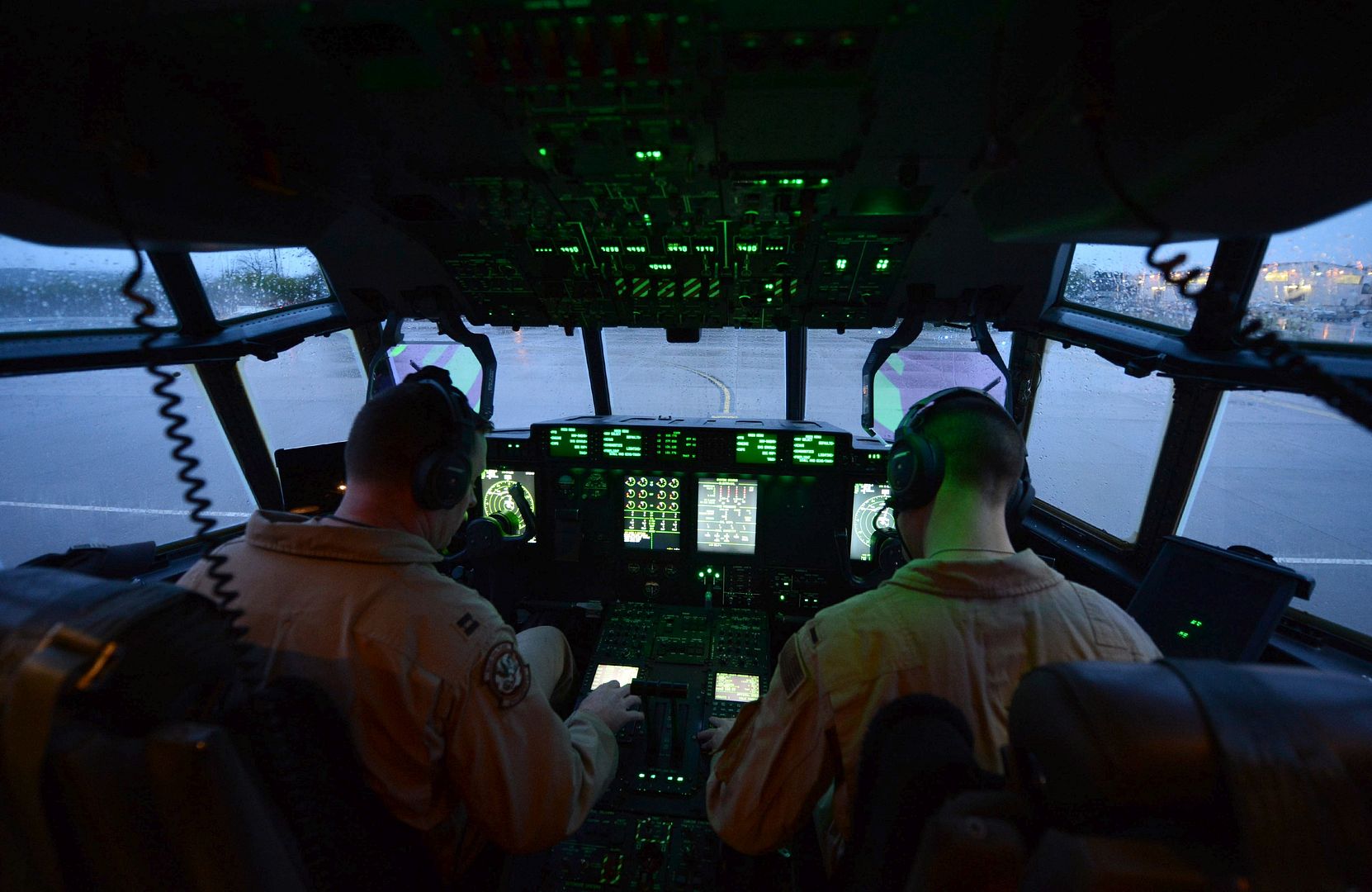
The 190th Air Refueling Wing evacuates four KC-135R Stratotankers from Forbes Field, Topeka, Kan., April 26, 2016 in anticipation of severe weather in the surrounding area through April 27. Projected weather includes high straight-line winds, large, damaging hail and possible tornadoes. (U.S. Army National Guard photo's by Sgt. Zachary Sheely/Released)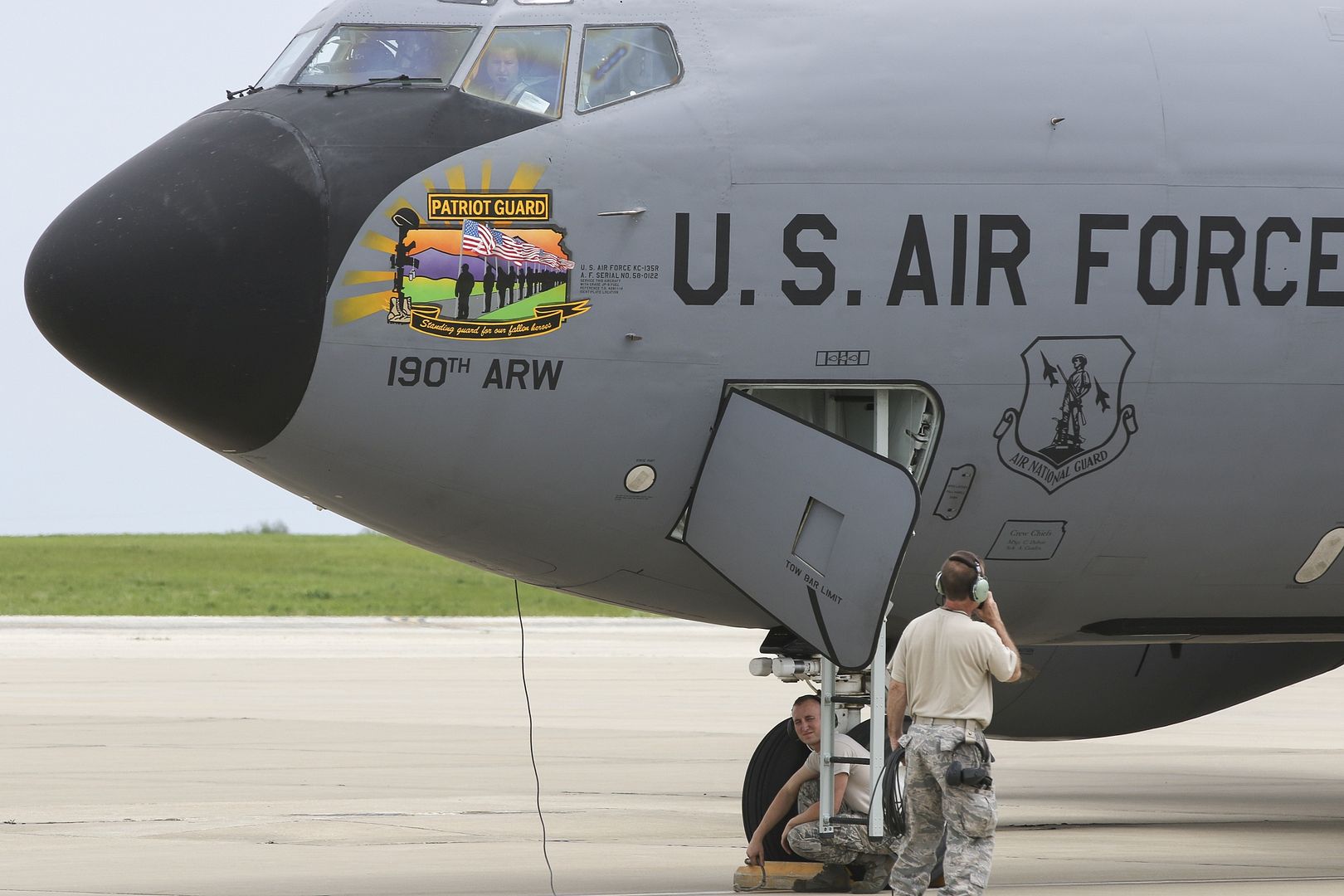
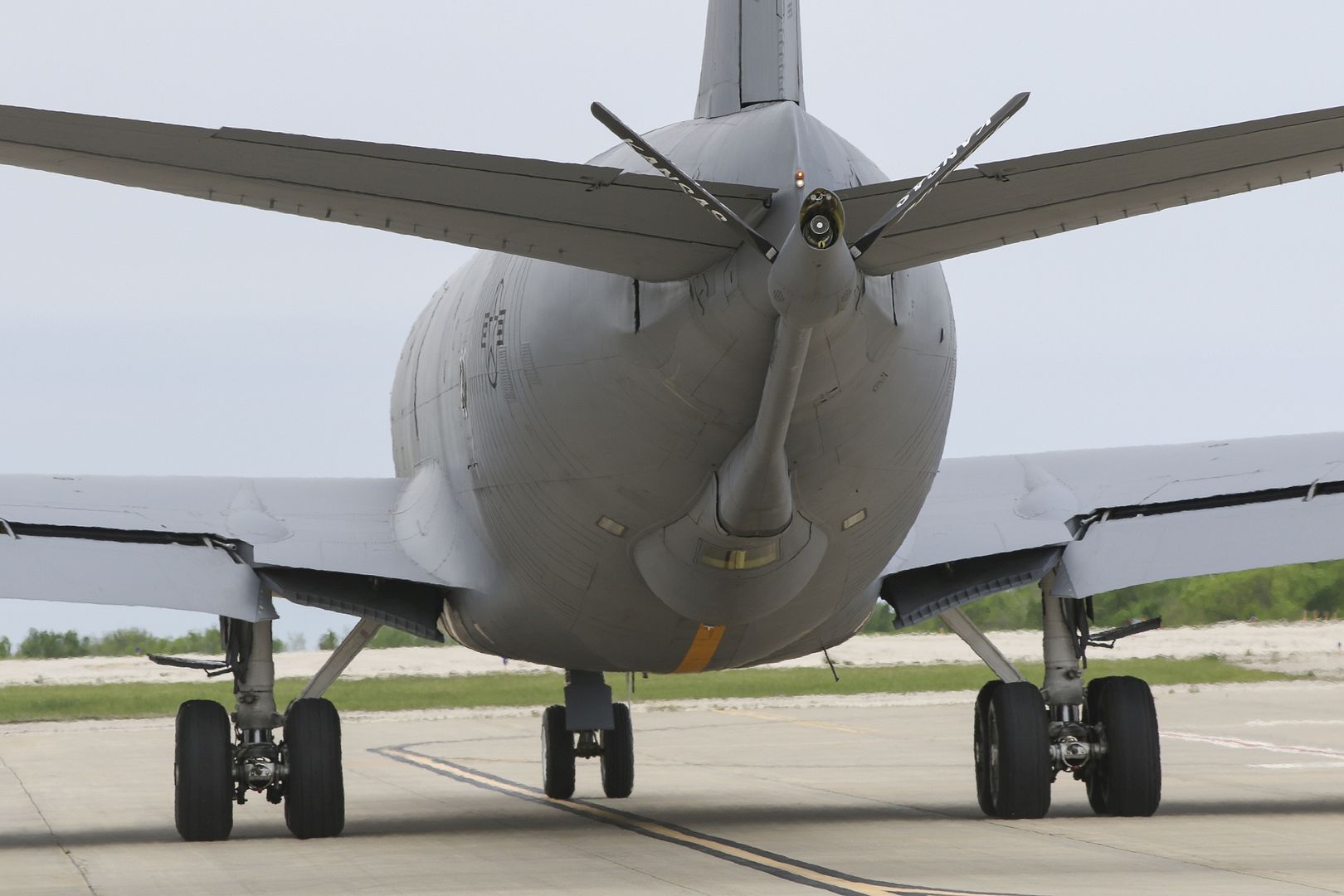
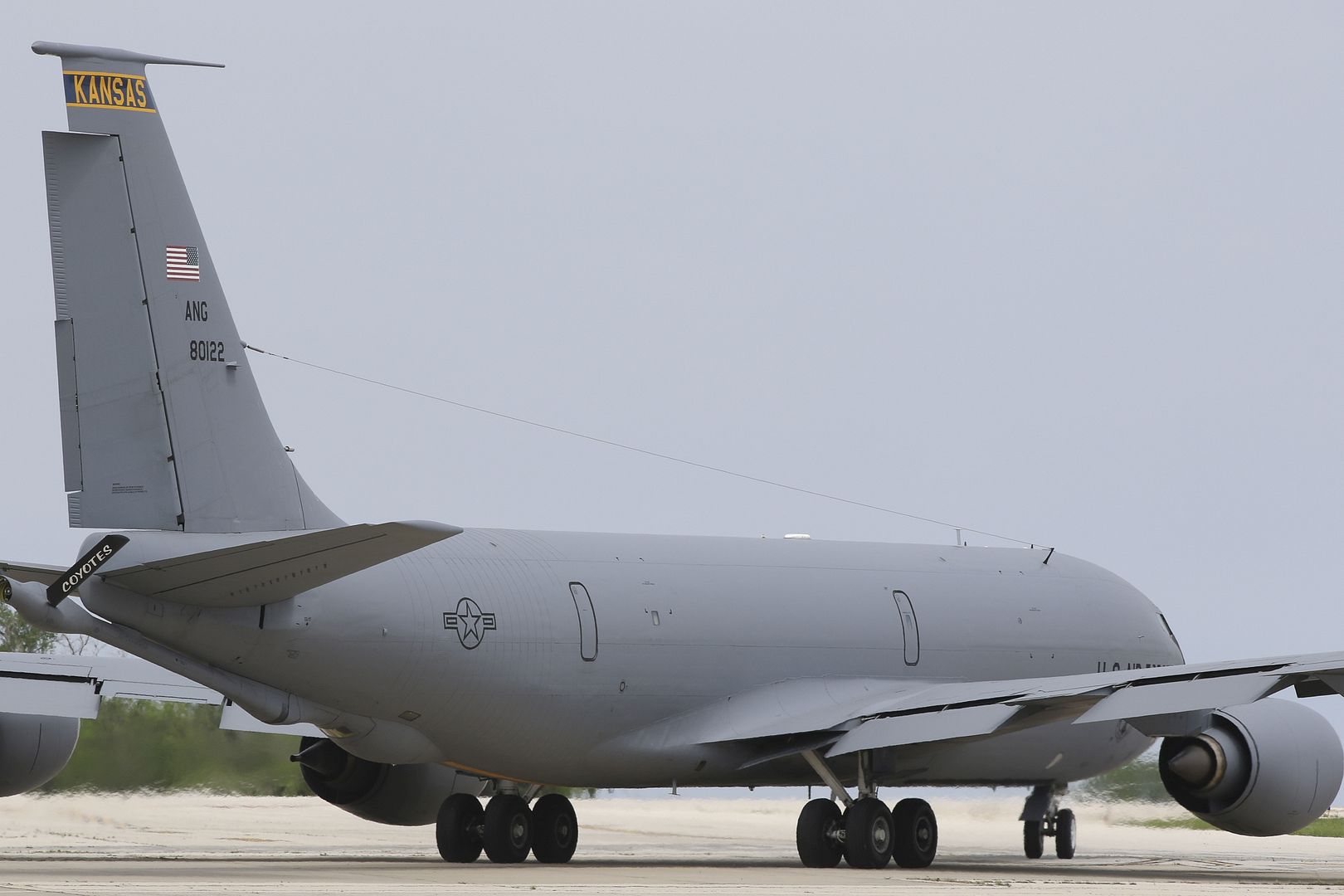
Members of the 718th Aircraft Maintenance Squadron inspect an HH-60G Pave Hawk helicopter during a pre-flight inspection, April 26, 2016, at Kadena Air Base, Japan. The 718th Aircraft Maintenance Squadron maintains military aircraft for flight to ensure safety and reliability in support of the training mission here at Kadena. These inspections are conducted 72 hours before each mission. (U.S. Air Force photo by Naoto Anazawa)
-
 Main AdminAlpha Jet aircraft are displayed on a flight line in Marrakech, Morocco during the International Marrakech Airshow on Apr. 27, 2016. Several U.S. independent and government owned aircraft were displayed at the expo in an effort to demonstrate their capabilities to a broad audience of individuals from approximately 54 other countries. (DoD News photo by TSgt Brian Kimball)
Main AdminAlpha Jet aircraft are displayed on a flight line in Marrakech, Morocco during the International Marrakech Airshow on Apr. 27, 2016. Several U.S. independent and government owned aircraft were displayed at the expo in an effort to demonstrate their capabilities to a broad audience of individuals from approximately 54 other countries. (DoD News photo by TSgt Brian Kimball)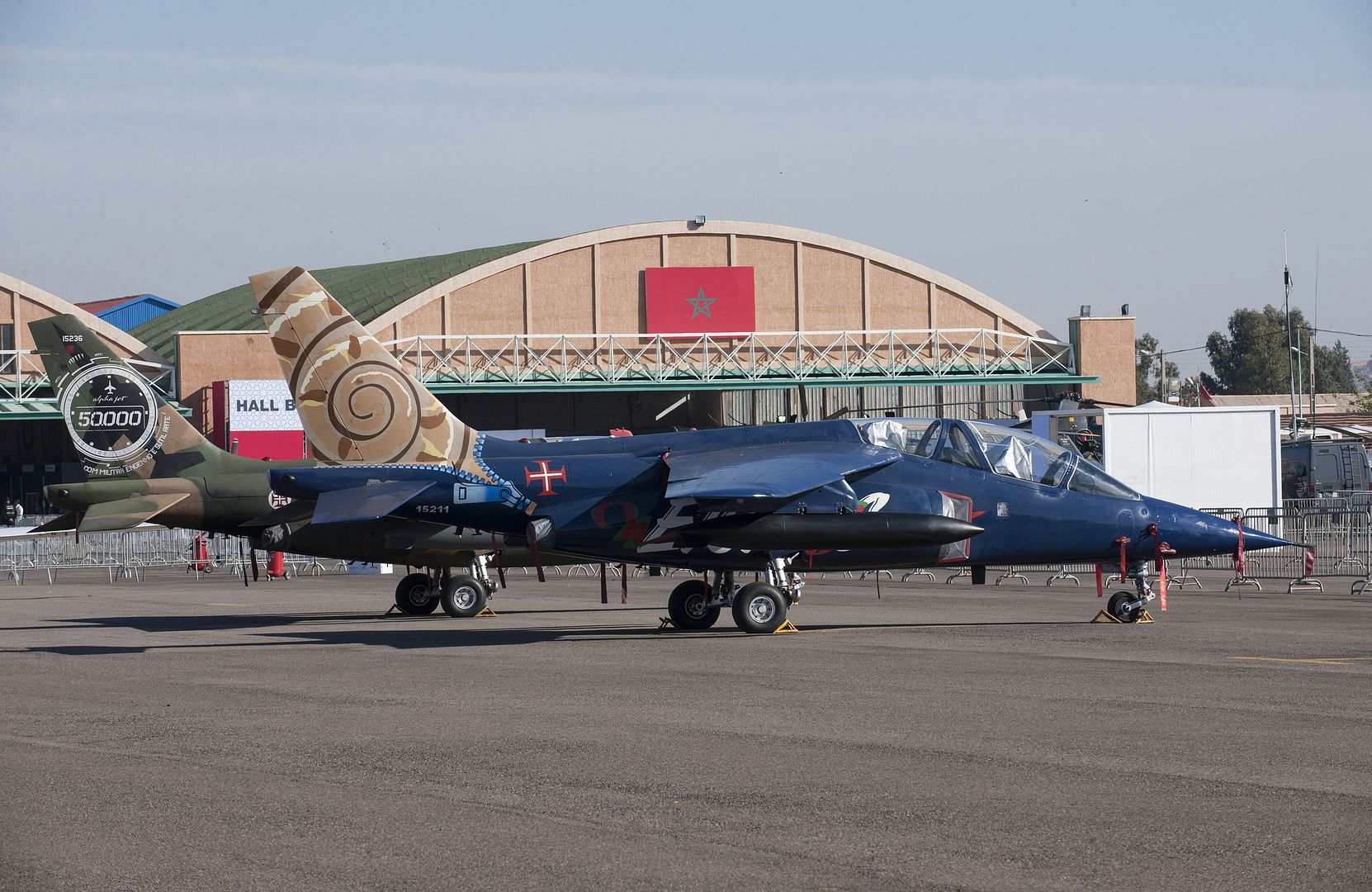
A pilot, with the United Arab Emirates Air Force Aerobatic Display Team, demonstrates the Al Fursan aircrafts inflight capabilities during the International Marrakech Airshow in Morocco on Apr. 27, 2016. Several United States, independent and government owned aircraft were displayed at the expo in an effort to demonstrate their capabilities to a broad audience of individuals from approximately 54 other countries. (DoD News photo by TSgt Brian Kimball)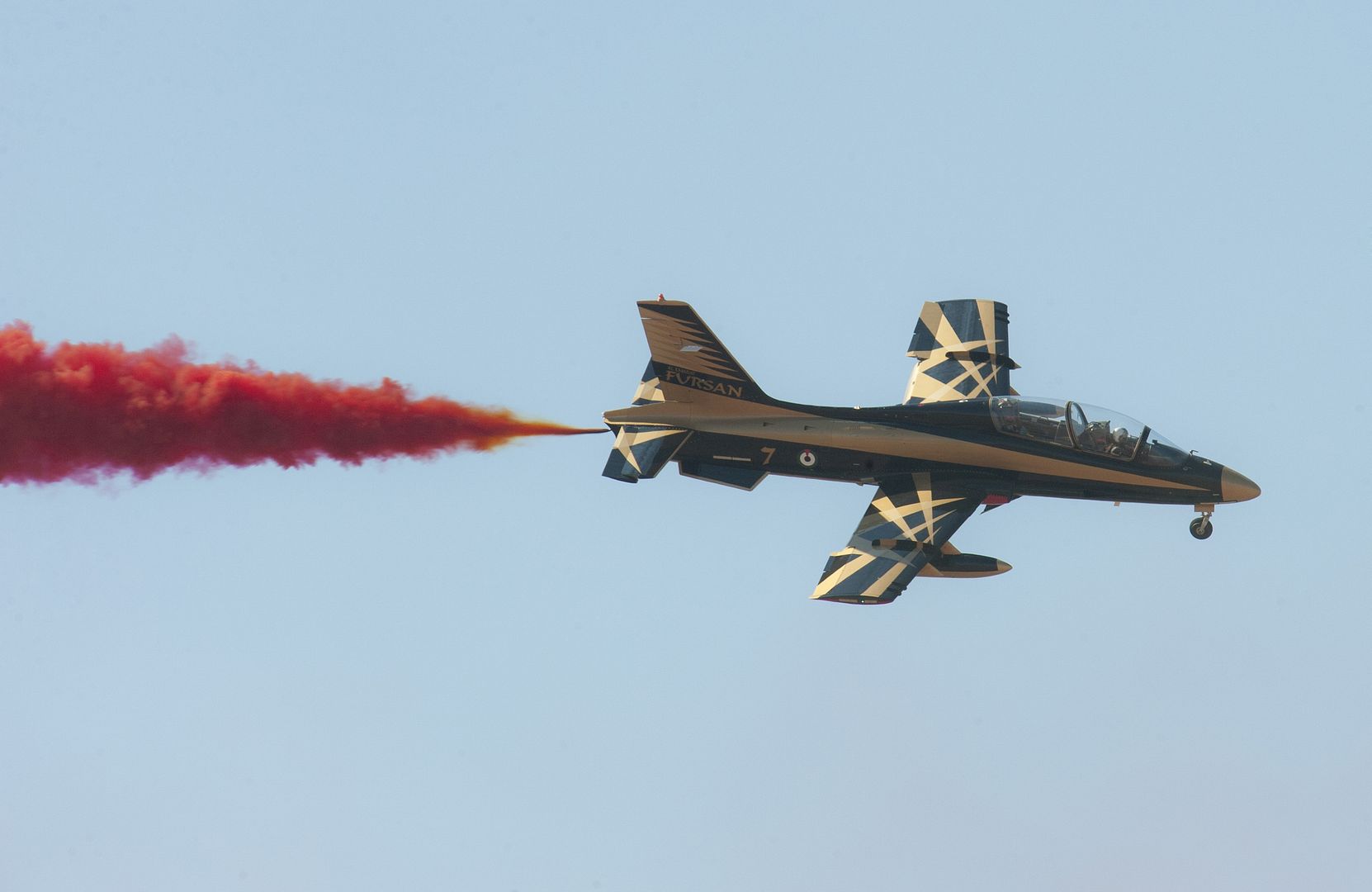
A pilot, with the Spanish Air Force Aerobatic Display Team, prepares for flight take off during the International Marrakech Airshow in Morocco on Apr. 27, 2016. Several United States, independent and government owned aircraft were displayed at the expo in an effort to demonstrate their capabilities to a broad audience of individuals from approximately 54 other countries. (DoD News photo by TSgt Brian Kimball)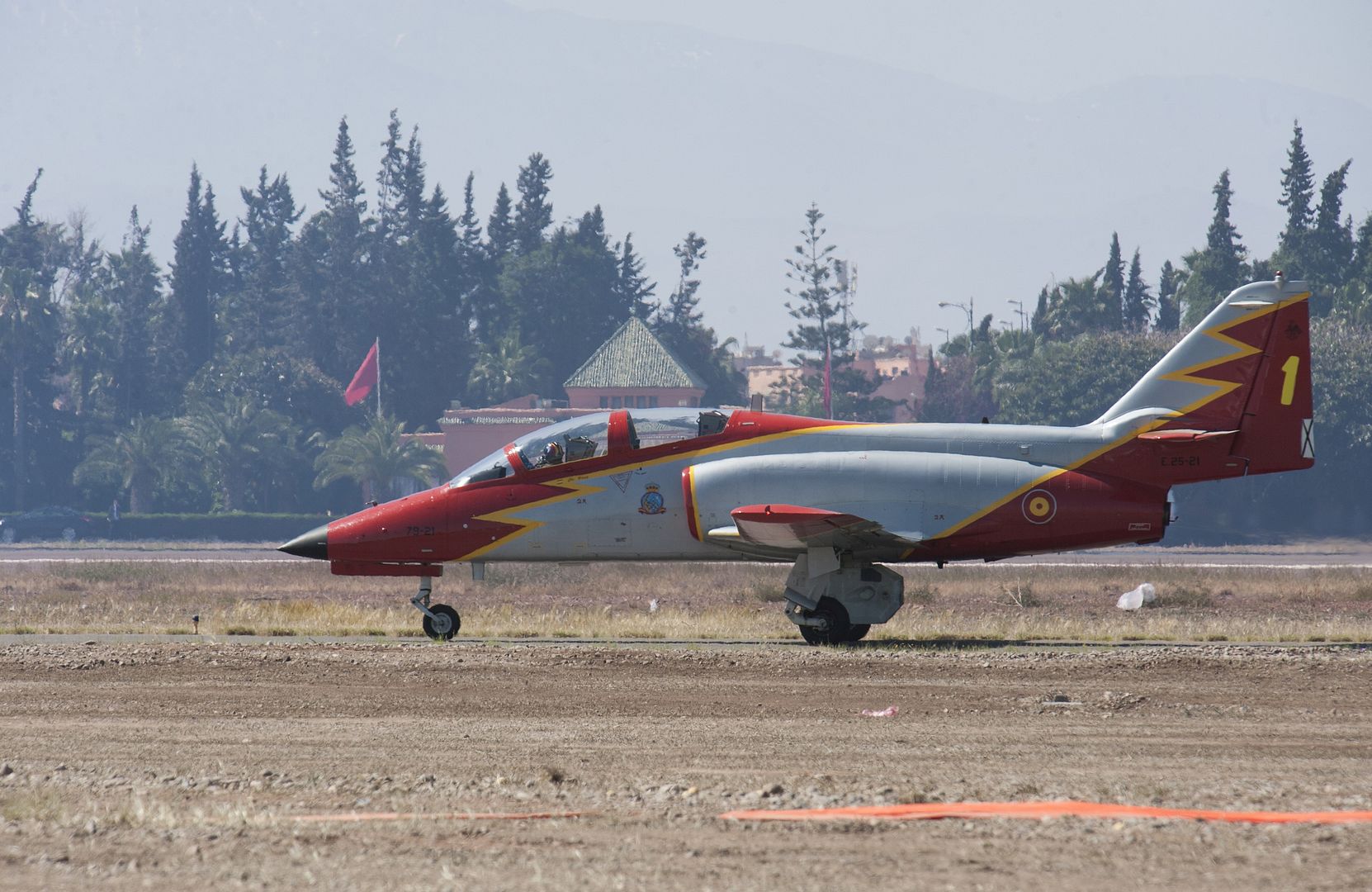
?IAULIAI AIR BASE, Lithuania (AFNS) -- A pair of F-22 Raptors and one KC-135 Stratotanker arrived at ?iauliai Air Base on April 27, following a short stay in Romania.
The F-22s, with about 20 supporting Airmen, are from the 95th Fighter Squadron at Tyndall Air Force Base, Florida. The KC-135 is from the 100th Air Refuel Wing at Royal Air Force Mildenhall, England.
The aircraft and Airmen were welcomed by Lithuanian President Dalia Grybauskait? and other distinguished visitors from the Lithuanian government and military.
"This is a demonstration that the United States is honoring its commitments and is ready to protect our region with all the most modern measures," she said in a press conference.
Both F-22s are currently part of the largest deployment of the fifth-generation aircraft to Europe. The deployment is partially funded by the European Reassurance Initiative, which provides support to bolster the security of NATO allies and partners in Europe while demonstrating the U.S. commitment to regional and global security.
"Today's demonstration is part the collective defense and security of our NATO Allies, a commitment that is underscored in President (Barack) Obama's $3.4 billion request for the European Reassurance Initiative," said U.S. Ambassador to Lithuania Deborah A. McCarthy.
The F-22s will briefly stay at ?iauliai AB before returning to RAF Lakenheath, England, to continue their training deployment that ends in May. Before Lithuania, the aircraft visited Mihail Kogalniceanu AB, Romania.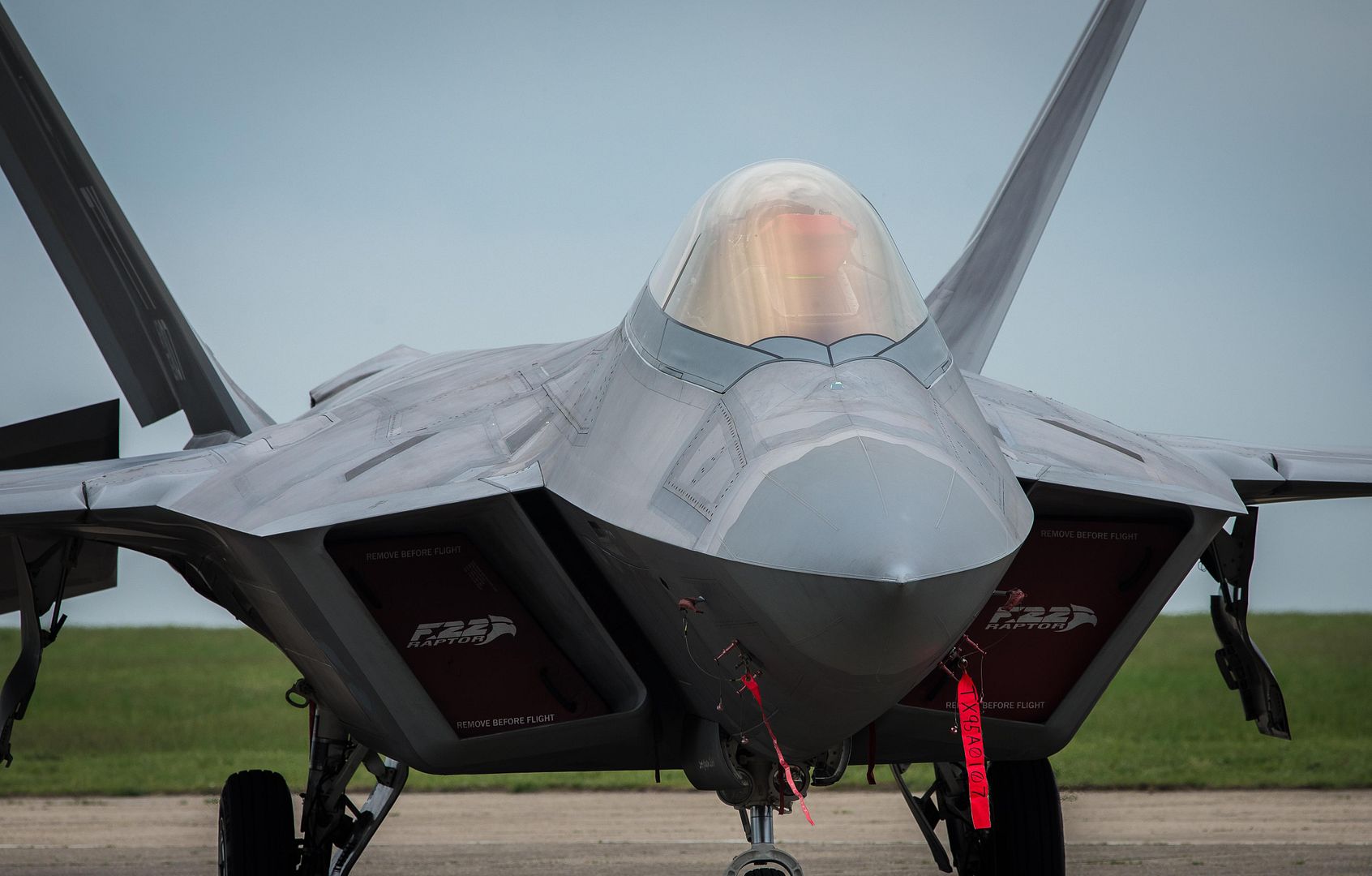
April 28, 2016 Montr?al Commercial Aircraft, Press Release
Bombardier Commercial Aircraft and Delta Air Lines, Inc. of Atlanta, Georgia (Delta Air Lines) announced today that the parties have executed a firm agreement for the sale and purchase of 75 CS100 aircraft with options for an additional 50 CS100 aircraft. Delta Air Lines may elect to convert a number of these aircraft into CS300 at a later date.
Based on the list price of the CS100 aircraft, the firm order is valued at approximately $5.6 billion US.
?As we reshape our fleet for the future, the innovative onboard experience of the C Series is a perfect complement for the top-notch service provided every day by Delta people,? said Ed Bastian, Delta?s incoming chief executive. ?These new aircraft are a solid investment, allowing us to take advantage of superior operating economics, network flexibility and best-in-class fuel performance.?
?Welcoming Delta Air Lines to the C Series family of operators is a watershed moment for our game-changing aircraft. As an industry leader, Delta consistently ranks first with customers, business leaders and its peers - a benchmark for operational performance,? said Fred Cromer, President, Bombardier Commercial Aircraft. ?This order is a resounding endorsement of the CS100 aircraft performance and its exceptionally low operating costs. In addition, its widest aisle, widest seats and largest bins in its class will be attractive features for Delta?s passengers.?
With this order, the largest in Bombardier Commercial Aircraft history, Delta becomes the C Series aircraft?s largest customer. Deliveries are scheduled to commence in spring 2018.
About C Series Aircraft
The C Series family of aircraft, representing the fusion of performance and technology, is a 100 per cent all-new design that offers operators up to US $13 million extra value per aircraft.
By focusing on the 100- to 150-seat market segment, Bombardier has designed the C Series aircraft to deliver unparalleled economic advantage to operators and to open up new opportunities for single-aisle aircraft operations.
By employing advanced materials, state-of-the-art technologies and advanced aerodynamics, combined with the Pratt & Whitney PurePower? PW1500G engine, the CS100 is delivering a 15 to 20 per cent fuel burn advantage compared to other re-engined aircraft.
In addition to delivering best-in-class economics with the C Series aircraft, Bombardier has placed considerable emphasis on cabin design to ensure a superior passenger experience. The aircraft offers 19-inch-wide seats that set a new industry standard, large overhead bins that accommodate a carry-on bag for each passenger, and the largest windows in the single-aisle market. Together these attributes create a widebody feel that offers passengers an unparalleled level of comfort.
All noise performance testing on the CS100 aircraft has been completed and data confirms it is the quietest in-production commercial jet in its class. The aircraft?s noise performance and its outstanding short-field capability make it ideal for varied types of operations.
The C Series aircraft's maximum range has also been confirmed to be up to 3,300 NM (6,112 km), some 350 NM (648 km) more than originally targeted.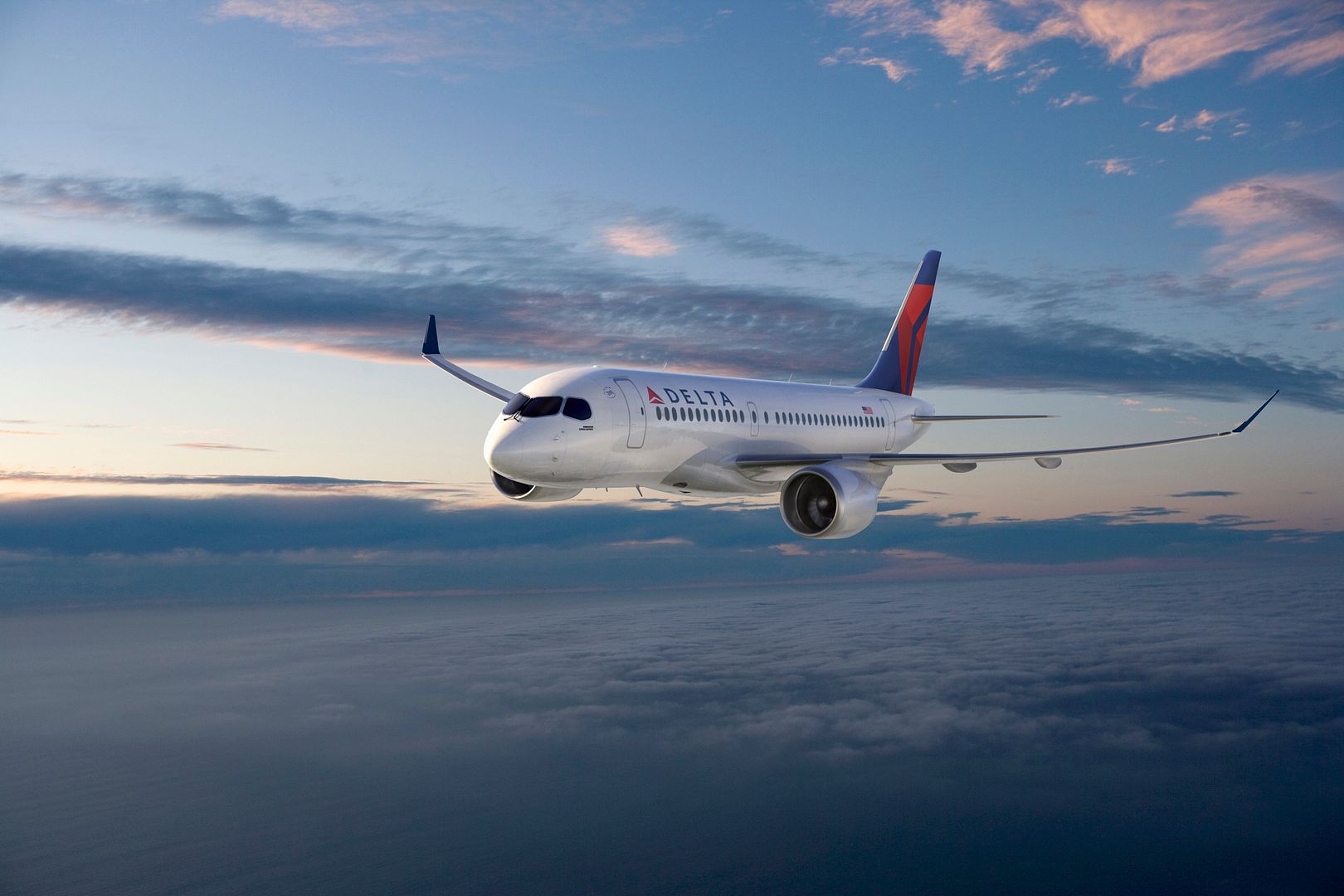
-
 Main AdminA U.S. Army AH-64 Apache helicopter assigned to 16th Combat Aviation Brigade supports air assault training with 4th Battalion, 23rd Infantry Regiment, 2nd Stryker Brigade Combat Team at Joint Base Lewis-McChord, Wash., April 27. The battalion-sized air assault allowed the infantry Soldiers to train in preparation for future missions.
Main AdminA U.S. Army AH-64 Apache helicopter assigned to 16th Combat Aviation Brigade supports air assault training with 4th Battalion, 23rd Infantry Regiment, 2nd Stryker Brigade Combat Team at Joint Base Lewis-McChord, Wash., April 27. The battalion-sized air assault allowed the infantry Soldiers to train in preparation for future missions.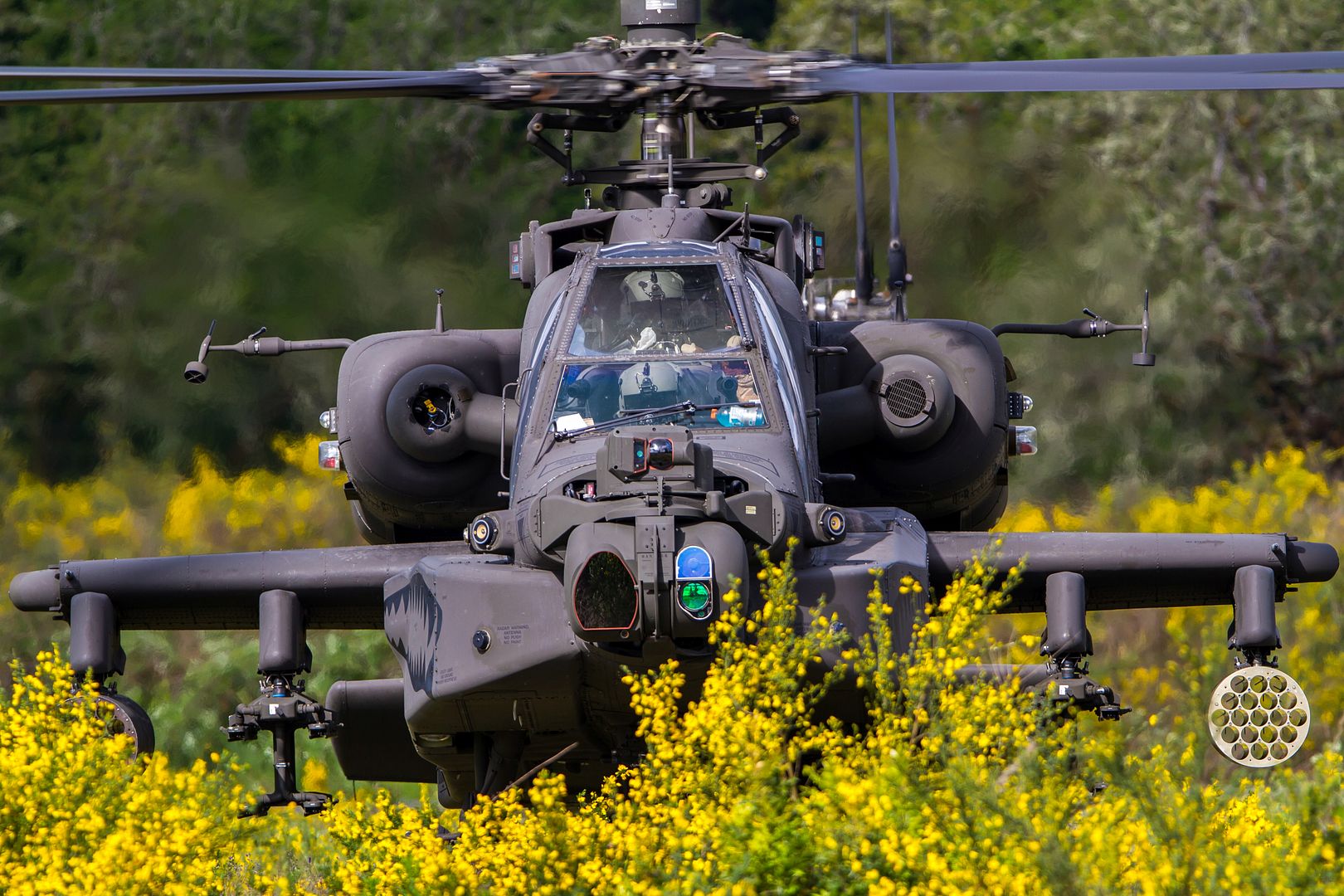
Show maneuvers in the F-35B Lightening II on the flight line aboard Marine Corps Air Station (MCAS) Beaufort, S.C., April 25, 2016. MCAS Beaufort conducted the training exercise to ensure that pilots of VMFAT-501 are properly prepared for the 2016 Air Show hosted at MCAS Cherry Point, N.C., April 29, 2016 through May 01, 2016. (U.S. Marine Corps photo by Lance Cpl. Kayla L. Douglass/ Released)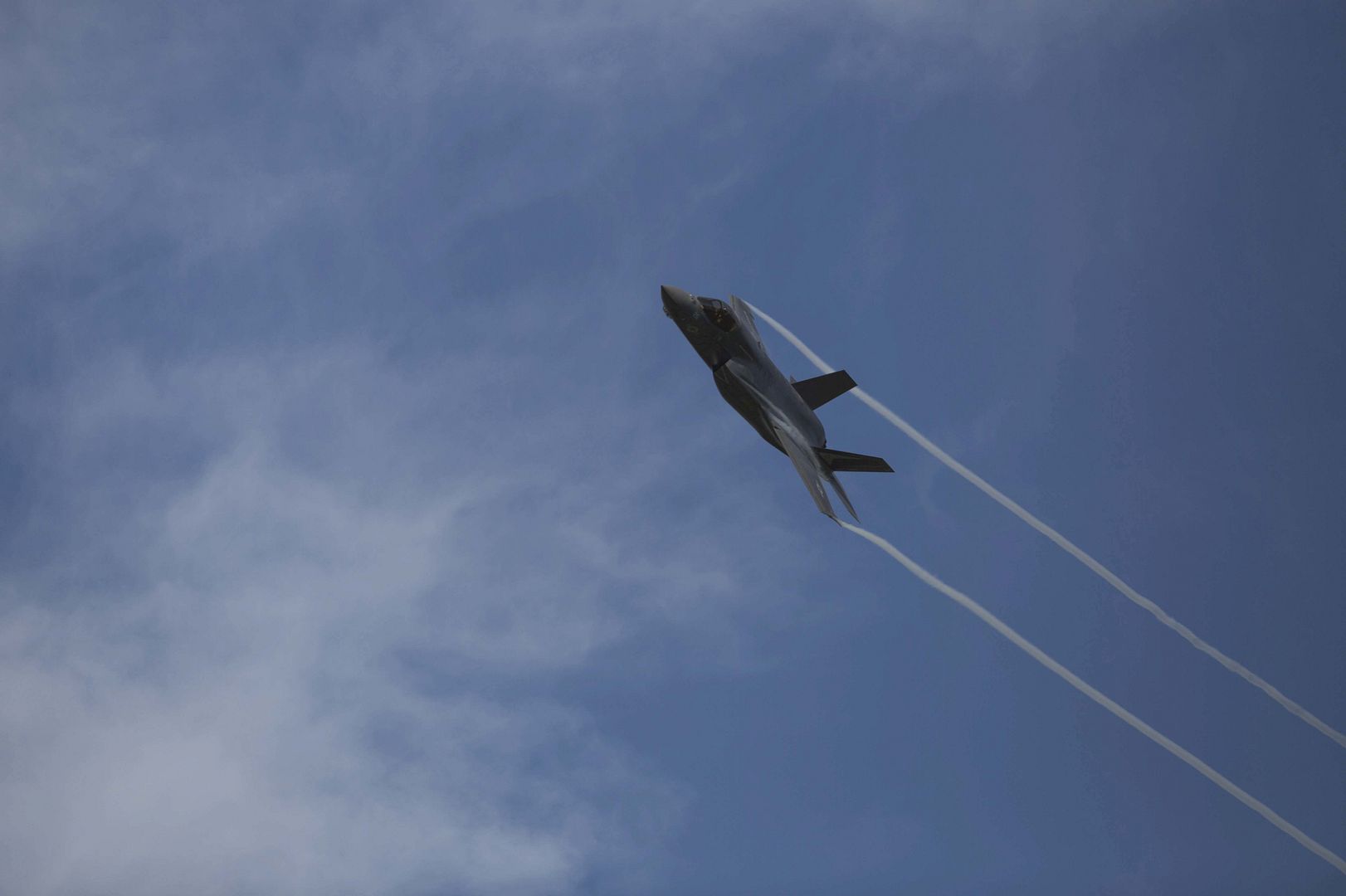
4/28/2016 - EDWARDS AIR FORCE BASE, Calif. -- The Air Force's F-15 Eagle fleet is scheduled to receive a wheel and brake upgrade after completion of flight testing here.
The Air Force F-15 fleet of more than 500 aircraft benefit from F-15 Wheels and Brakes System Improvement program by saving $194 million in F-15 maintenance costs by increasing number of landings to 1,400 between brake changes, reducing chance of brake fires and improving the braking capability of the F-15 C/D and E aircraft.
Glen Atkinson, the 412th Test Engineering Group modification manager for the F-15 WBSI project.
"I have overall responsibility for initiating documentation, planning, executing, monitoring and controlling, and closing of the modification effort," he said. He also experienced challenges during the test process. "The designated aircraft was to be an F-15E model. All design efforts were vectored towards that model," Atkinson said. But no Air Force command could supply an F-15E, so the systems program office had to look to the Air National Guard, which was able to provide an F-15D. "The D model has much different landing gear and brakes, and the aircraft is configured differently than the E model with regards to production equipment. So, the design basically started over very late in the process," he explained.
Time constraints were probably the biggest challenge for the team.
"We were under constant schedule pressure ... due to the imminent discontinuation of the production brake manufacturing," Atkinson said. "With the design now way behind the curve, the modification schedule was under pressure to finish significantly under the estimated time. Modifications almost never go exactly to plan because each aircraft is a little different, and unknown issues pop up constantly."
Eric Biesen, lead flight test engineer with the 416th Flight Test Squadron also said that there were some unusual points to this test.
"(Wheel and brake) testing sounds like business as usual at Edwards Air Force Base, but this is new to the 416th," he said. "We've been leveraging knowledge from engineers and technicians." The F-15 testing was assigned engineers and technicians with previous wheel and brake testing on bombers and cargo aircraft. According to Biesen, there has been no F-15 brake testing since the 1980s.
The test aircraft, as well as several maintainers, came from the 173rd Fighter Wing, Kingsley Field Air National Guard Base, Oregon. Other maintainers came from 142nd Fighter Wing, Portland Air National Guard Base, Oregon; the 125th Fighter Wing, Jacksonville, Florida; the 159th Fighter Wing, Louisiana Air National Guard, located at the Naval Air Station-Joint Reserve Base, New Orleans; and the 104th Fighter Wing at Barnes Air National Guard Base, Westfield, Massachusetts. Locally, the aircraft modifications for the test were performed by members of the 412th Maintenance Group Instrumentation Division. Pilots from the Palmdale detachment flew the test missions.
Since Edwards does not have any F-15s, all parts and maintenance support had to come from organizations with F-15s. The project received support from the NASA Armstrong Flight Research Center here.
Master Sgt. Marty Nance, 142nd FW, is the production superintendent and crew chief for the testing. He said that the military members' roles in the testing were primarily maintenance and support. "It's kind of like being deployed somewhere," he said.
Since Edwards technicians were not qualified to work in the crew compartment without the proper training, and NASA has F-15s, Armstrong Flight Research Center was able to support with the proper training. NASA also helped with physical support for the maintenance of the aircraft egress system.
"NASA supplied us with weapons, parts, and egress support," Nance said.
Modifications for the testing were accomplished by 412th MXI. Engineering, instrumentation technicians and model makers were key players in this. Before the aircraft could even begin testing, it had to be fitted with measurement equipment to get baseline measurements. Sensors to measure hydraulic pressure, temperatures, and component positions had to be installed.
Charles Vatcher, the 412th TENG lead mechanical engineer for the project, said there were a few challenges in selection and installation of measuring devices. One such challenge was measuring the nose landing gear displacement. Typically, distance and travel measurements are made using a cable actuated potentiometer, but this only for straight-line measurements. Since the nose gear has compression, extension, and rotation (steering), another method had to be created.
"This was accomplished using an innovative laser distance measurement sensor and a reflector mounted to the lower nose landing gear strut," Vatcher said.
What seems like miles of wiring also had to be run, and measurement and recording equipment had to be installed in an aircraft that was not designed to be fitted with this equipment.
Damon Hall, a wiring technician with the 412th MXIS, worked on F-15s early in his career.
"It's been a long time," he said. Hall is familiar with the aircraft, but he said that as a wiring technician, there were certain areas on the aircraft that were difficult to run wires.
Rudolph Harris, another instrumentation technician, agreed with Hall.
"One challenge was the crew compartment," Harris said. "There were no holes, so we had to find vacancies in existing connectors to run the wiring."
Biesen said the testing, especially the conglomeration of people on the project, has been a great experience for him. This was absolutely a great bunch of guys," he said. "The Guard support has been unreal."
Atkinson agreed, saying "one bright spot has been the (Air National Guard) personnel that are here to support the jet. They are friendly, willing and eager to do whatever it takes to get this testing done."
by Christopher Ball
412th Test Wing Public Affairs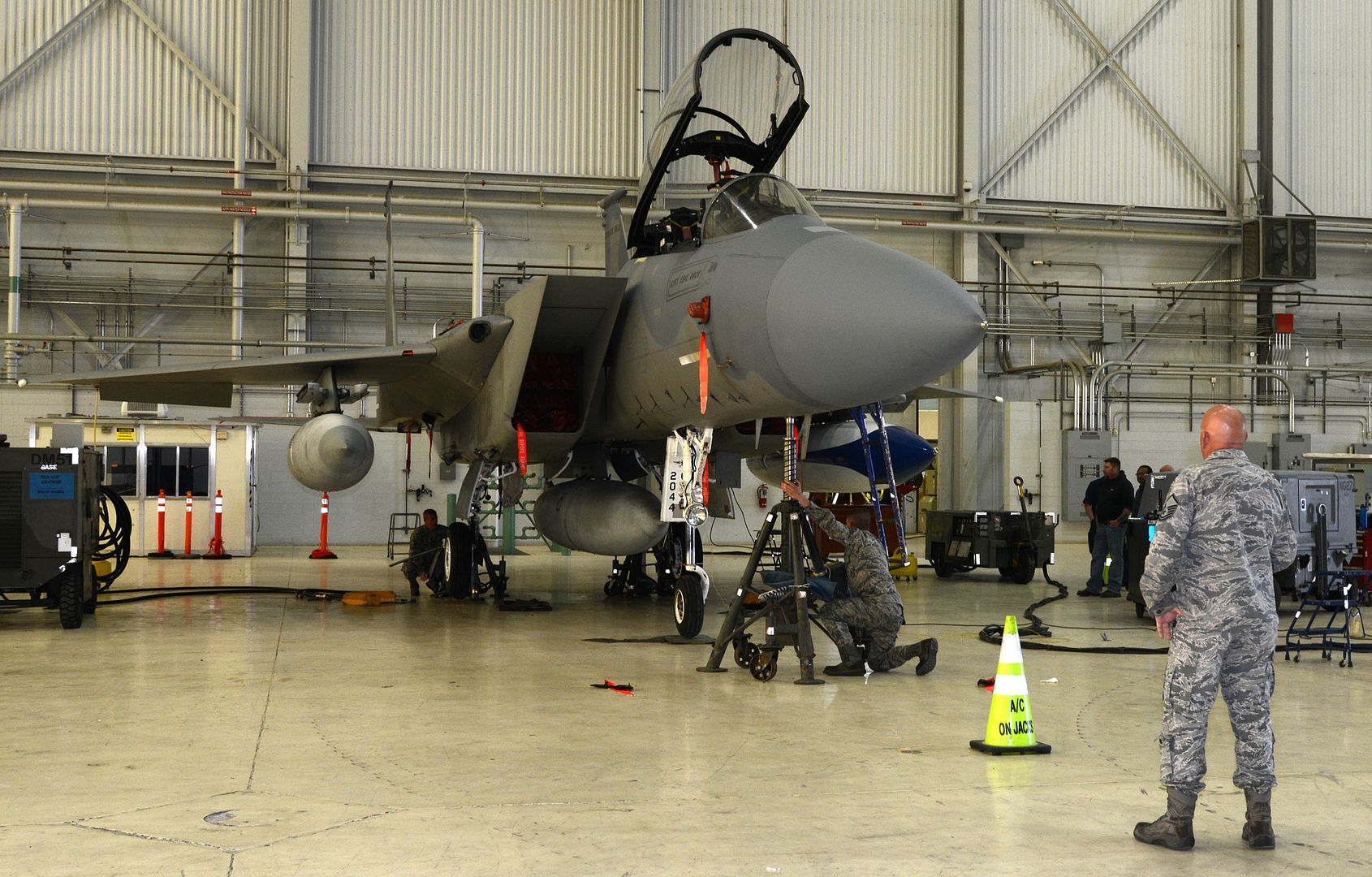
SHANGHAI, April 28, 2016 /PRNewswire/ -- Boeing [NYSE: BA] and China Eastern Airlines today finalized an order for 15 787-9 Dreamliners. The order, valued at nearly $4 billion at current list prices, strengthens China Eastern's expanding long-haul fleet.
"We are very happy to introduce the new 787 Dreamliners into our long-haul fleet," said China Eastern Airlines Chairman Liu Shaoyong. "The addition of these next-generation, fuel-efficient airplanes will play a key role in supporting China Eastern's strategy for international expansion, and enable us to realize profits in point-to-point routes across the Pacific Ocean, and between China and Europe."
China Eastern plans to operate the new 787-9s on routes between China, North America and Europe, bolstering its competitiveness in the international long-haul market.
With growing air traffic demand, the carrier plans to increase frequencies on existing routes from Shanghai to Los Angeles, New York, San Francisco and Toronto, as well as their newly launched destination, Chicago. The routes are currently operated by the airline's flagship 777-300ER airplane.
"China Eastern has been a long-standing Boeing customer and we are honored that the passenger-preferred 787 Dreamliner will join their world-class fleet," said Ihssane Mounir, senior vice president, Northeast Asia Sales, Boeing Commercial Airplanes. "The combination of both the 777-300ER and 787-9 will provide the airline with market-leading economics as well as flexibility that will contribute significantly to their success operating long-haul flights to North America."
The 787 family has proven to be an unmatched market opener, with more than 100 new nonstop routes already in service or announced, as well as an effective tool to increase frequency profitably, often in conjunction with the 777.
For China Eastern, operating both the 777 and 787 will allow the airline to continue growing its international presence with more capacity and cargo payload on key existing frequencies, while also providing the flexibility for further expansion in high-growth markets.
The 787-9 complements and extends the super-efficient 787 family. With the fuselage stretched by 20 feet (6 meters) over the 787-8, the 787-9 can fly more passengers and more cargo farther yet with the same exceptional environmental performance ? 20 percent less fuel use and 20 percent fewer emissions than the airplanes they replace.
Headquartered in Shanghai, China Eastern Airlines is one of the three major airlines in mainland China. Flying a fleet of over 560 long-haul and short-haul airplanes with an average age of less than seven years, China Eastern serves nearly 100 million travelers annually and ranks the 7th largest carriers in the world in terms of passenger transportation volume.
More than 60 customers from six continents of the world have placed orders for more than 1,100 787s, making the 787 the fastest selling twin-aisle airplane in Boeing history. With this order, the 787 Dreamliner will have nearly 100 orders and commitments from Chinese customers.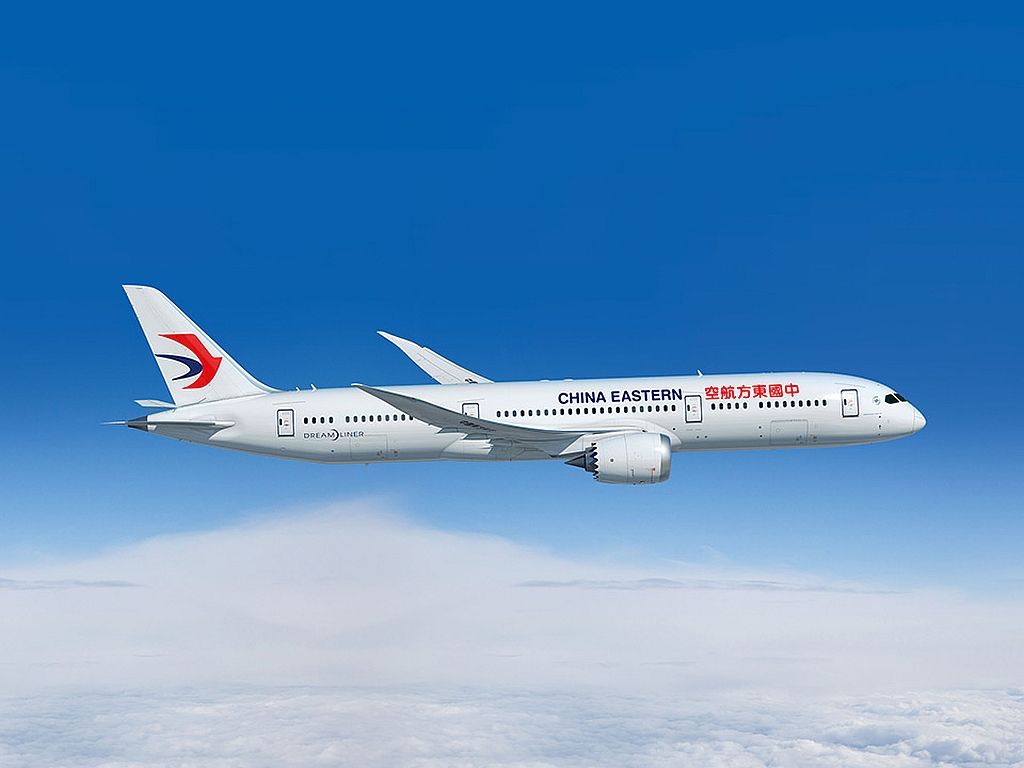
29 April 2016 Press Release
Philippine Airlines (PAL) has finalised a purchase agreement with Airbus covering the firm order of six A350-900s, plus six options. The contract firms up a Memorandum of Understanding announced earlier this year during the Singapore Airshow.
The A350 XWB will become the flagship of PAL?s future long haul fleet and will be configured with a premium three class layout. The airline will operate the aircraft on non-stop flights to the US, as well as on services to new destinations in Europe.
?We are pleased to finalise this important order and are now defining the final layout for the aircraft,? said Jaime J. Bautista, President & COO of Philippine Airlines. ?With the A350 we will introduce a whole new level of comfort for long haul flights, with more personal space in all classes, a quieter cabin and the very latest on-board amenities. At the same time we will benefit from the A350?s enhanced efficiency and ability to fly non-stop on even our longest sector from New York to Manila, all year round.?
?The order from Philippine Airlines underscores A350 XWB?s position as the aircraft of choice in the larger twin aisle category,? said John Leahy, Airbus Chief Operating Officer, Customers. ?The A350 XWB has set new standards, combining extra-long range capability with the lowest operating costs of any aircraft in its class. It will be the perfect aircraft for Philippine Airlines to reinforce its position as one of Asia?s leading premium carriers, especially on its longest intercontinental routes.?
The A350 XWB is the newest member of the Airbus widebody family. Featuring the most modern aerodynamic design, carbon fibre fuselage and wings, plus new fuel-efficient Rolls-Royce Trent XWB engines, the A350 XWB brings a 25 percent reduction in fuel burn and emissions, and significantly lower maintenance costs. For passengers the extra-wide cabin offers more personal space, including 18-inch wide seats as standard in economy class.
To date, Airbus has recorded 783 firm orders for the A350 XWB from 42 customers worldwide, already making it one of the most successful widebody aircraft ever.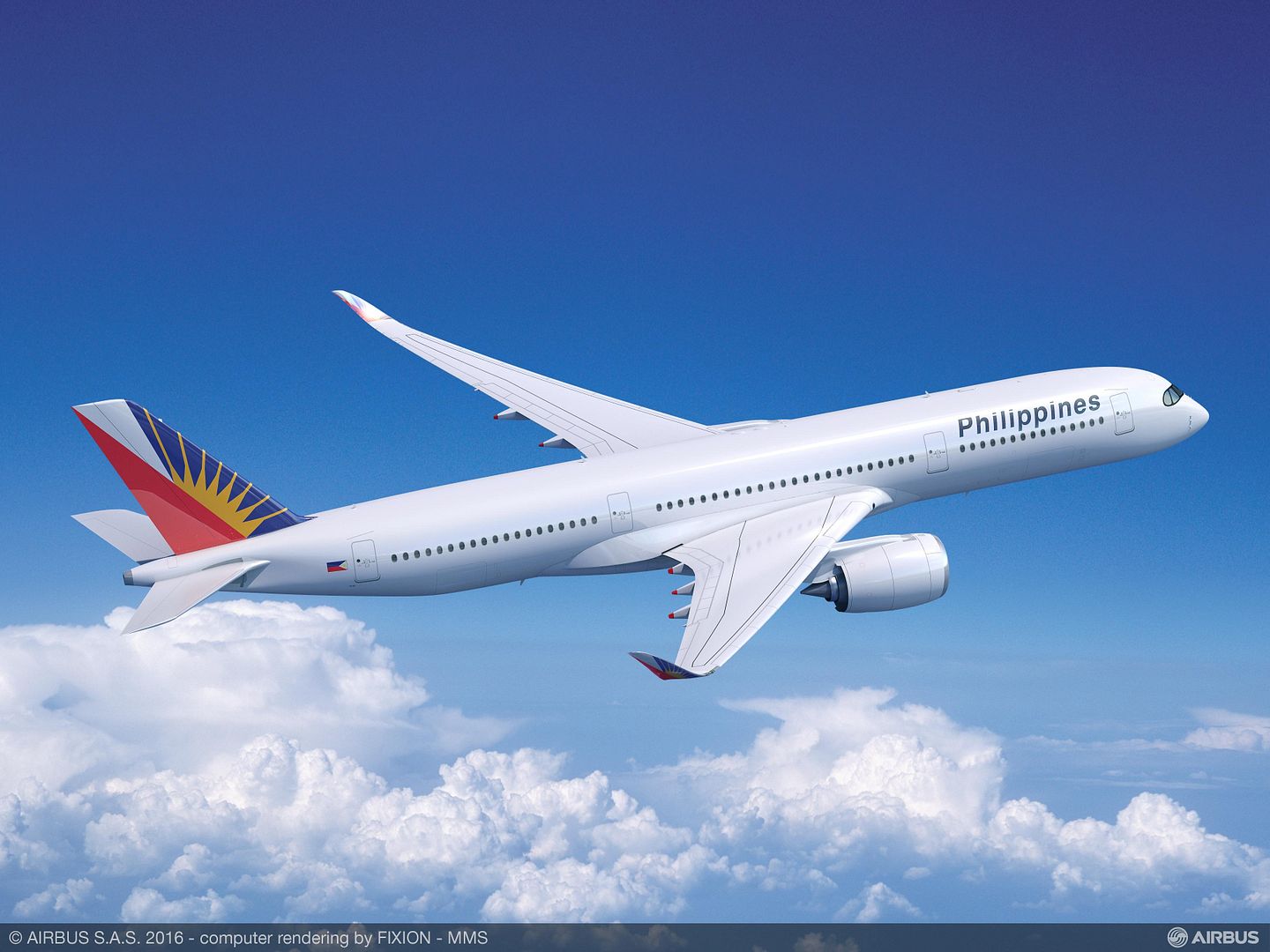
29 April 2016 Press Release
China Eastern Airlines has signed a purchase agreement with Airbus for 20 A350-900 aircraft, making the airline the latest customer for the aircraft.
?The introduction of the latest generation A350 XWB aircraft demonstrates that the partnership between China Eastern Airlines and Airbus has embarked on a new phase. The introduction of A350 XWB will play a very important role in promoting our operational capability, profitability and service brand on our international long haul routes and opening a new chapter in the international development of China Eastern Airlines,? said Liu Shaoyong, Chairman of China Eastern Airlines.
?We are proud to welcome China Eastern Airlines, a long time and loyal Airbus partner, to become the latest airline to select the A350 XWB,? said John Leahy, Airbus Chief Operating Officer ? Customers. ?The outstanding A350?s long haul performance, fuel efficiency and passenger comfort with its extra wide cabin and wider-seats, will allow China Eastern Airlines to achieve its ambitions to develop and efficiently expand its international route network.?
China Eastern Airlines operates one of the largest Airbus fleet in the world with nearly 300 Airbus aircraft in service, comprising A320 Family and A330 Family.
The A350 XWB is the world?s latest generation airliner and the newest member of Airbus? modern, comfortable & efficient wide-body product family. It features the latest aerodynamic design, carbon fiber fuselage and wings, plus new fuel-efficient Rolls-Royce Trent XWB engines. Together, these latest technologies translate into unrivalled levels of operational efficiency, with a 25 per cent reduction in fuel burn and emissions, and significantly lower maintenance costs. For passengers the extra-wide cabin offers more personal space in all classes, including 18-inch wide seats as standard in economy class.
With this latest order, Airbus has recorded 803 firm orders for the A350 XWB from 43 customers worldwide, making it one of the most successful wide-body aircraft ever. So far 20 A350 XWBs have been delivered to five customers worldwide.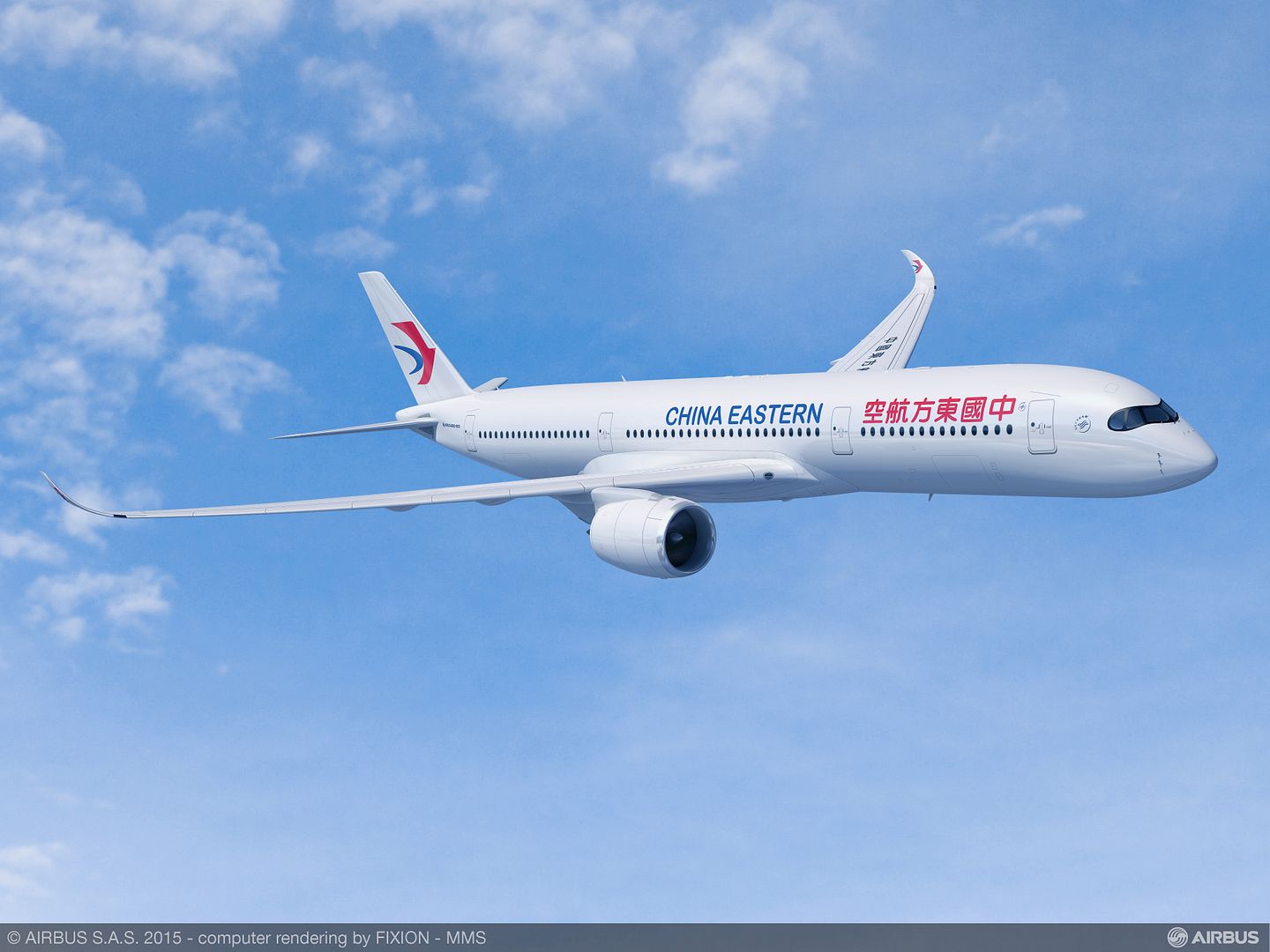
29 April 2016 Press Release
Atlanta, Georgia (U.S.) ? based Delta Air Lines has placed an order for 37 A321ceo aircraft. This order follows previous Delta orders for the Current Engine Option version of the largest Airbus A320 Family member in 2013 and 2014. Delta took delivery of its first A321 in March 2016. Including that aircraft and today?s announcement, Delta has ordered a total of 82 A321s. Each will be powered by CFM56 engines from CFM International.
"The Airbus A320 family of aircraft continues to be a cost-efficient, reliable and customer-pleasing mainstay of our narrowbody fleet," said Ed Bastian, Delta's incoming chief executive. "The order for the A321s is an opportunistic fleet move that enables us to produce strong returns and cost-effectively accelerate the retirement of Delta's 116 MD-88s in a capital efficient manner."
?Delta is an industry leader in many ways, not the least of which is contributing to the trend toward larger, more fuel-efficient aircraft for their single-aisle fleet,? said John Leahy, Airbus Chief Operating Officer ? Customers. ?The A320 Family continues to be the backbone of every airline in the world that is paying attention to what their passengers want and their investors need. In 2015, nearly 40 percent of our A320 Family deliveries were A321s, up some 10 percent from the previous year. Our customers, like Delta, know where to find the best comfort, economy and reliability.?
All of Delta?s A321s will feature fuel-saving Sharklets ? lightweight composite wingtip devices that offer up to 4 percent fuel-burn savings. This environmental benefit gives airlines the option of extending their range up to 100 nautical miles/185 kilometres or increasing payload capacity by some 1000 pounds/450 kilograms.
Many of Delta?s A321s will be delivered from the Airbus U.S. Manufacturing Facility in Mobile, Alabama. Aircraft assembly there began in July 2015, with the first aircraft, an A321ceo, being delivered April 25, 2016. By the end of 2017, the Mobile facility is expected to produce four aircraft per month, most going to Airbus? U.S. customers.
As of the end of March 2016, Delta was flying a fleet of 165 Airbus aircraft, including 127 A320 Family members and 38 A330 widebodies. In addition to its A320 Family aircraft orders, the airline has a backlog of 5 A330-300, 25 A330-900 and 25 A350 XWB aircraft
-
 Main Admin29 April 2016
Main Admin29 April 2016
The Defence Secretary has announced today that four Royal Air Force (RAF) Typhoons, flying from the Amari airbase in Estonia, will join the NATO Baltic Air Policing (BAP) mission until the end of August.
The jets, alongside pilots and engineers, will be on 24/7 stand by to launch a Quick Reaction Alert (QRA) in response to any aggression directed from Russia, or others. Two of the four Typhoons will be ready to take off at moment?s notice to provide security to the airspace over Estonia, Latvia and Lithuania.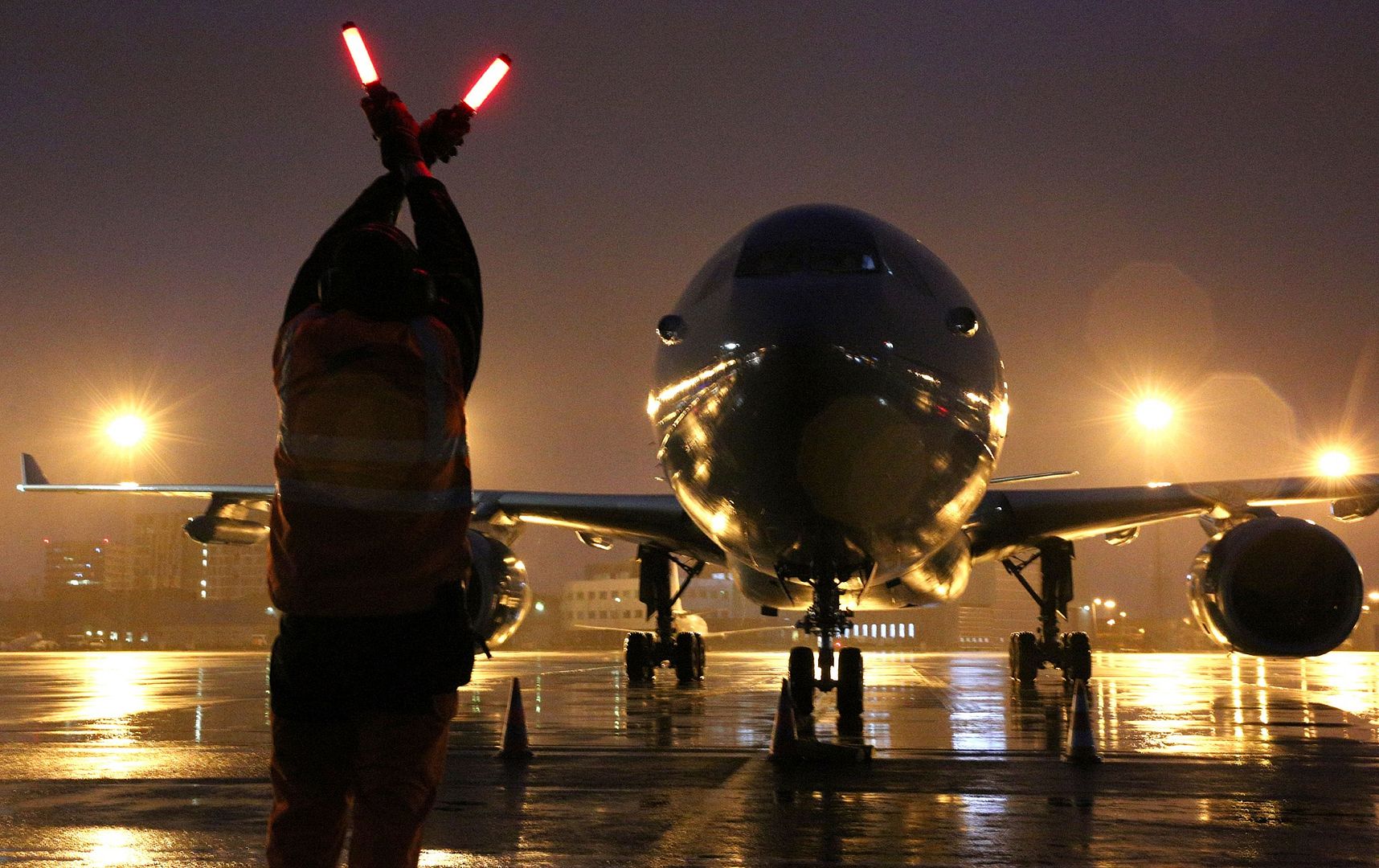
Defence Secretary Michael Fallon said:
"This deployment underlines our commitment to the sovereignty of the democratic nations of Eastern Europe.
"24 hours a day, seven days a week for the next four months, our RAF Typhoons will be ready to respond instantly to Russian aggression in Baltic airspace".
This is the third consecutive year the UK has committed to BAP, after rotations in 2014 and 2015. Last time, Typhoon fighters were scrambled 17 times, and intercepted over 40 Russian aircraft. During one launch last July, the Typhoons intercepted 10 separate Russian aircraft, including eight fighters.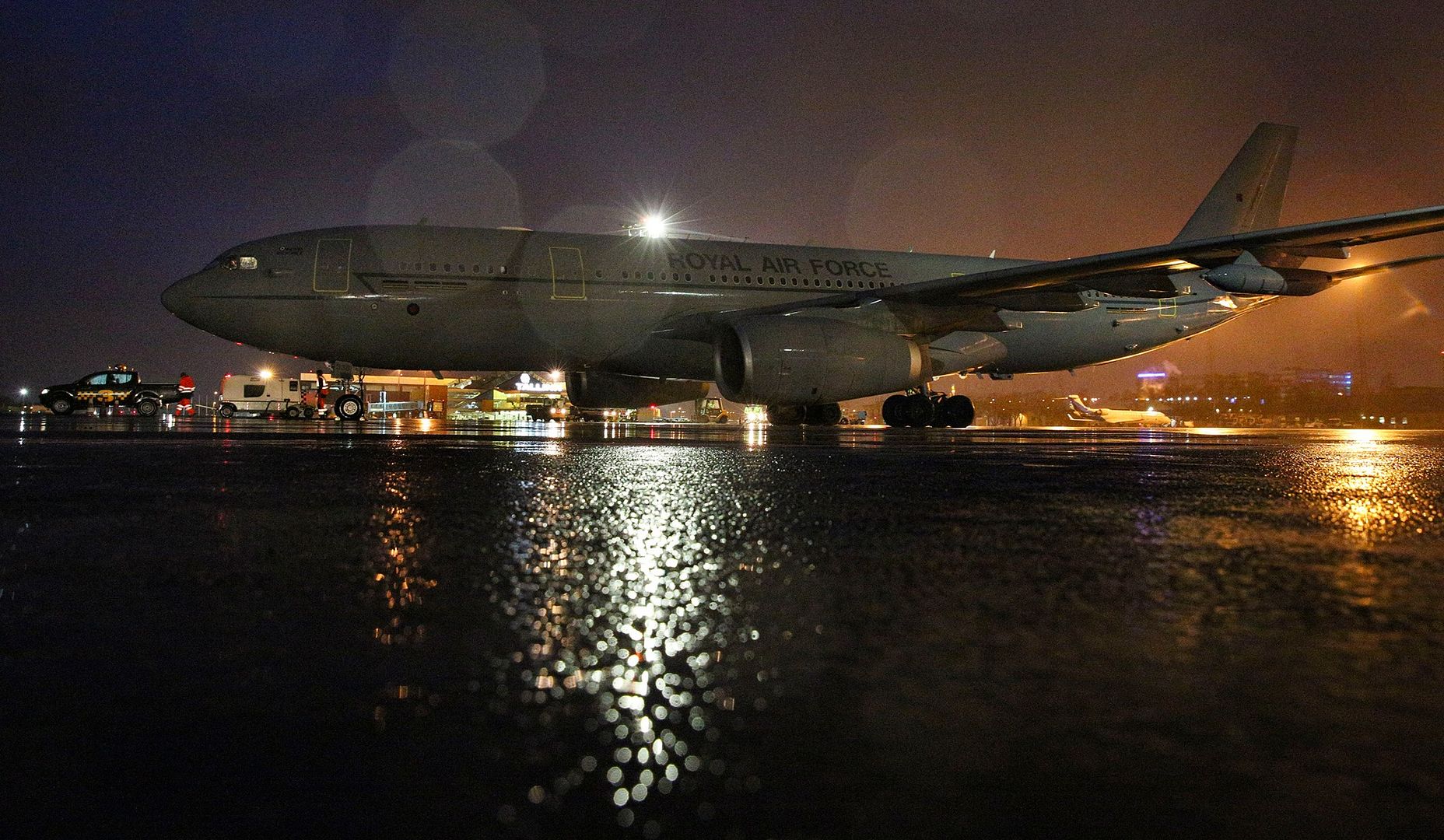
Wing Commander Gordon Melville, Commanding Officer of 140 Expeditionary Air Wing RAF, said:
"I am very proud to be leading 140 Expeditionary Air Wing as we again provide air policing support to our Estonian NATO allies.
"Although we are all far from our families and friends while over here, our hosts have given us a warm welcome and we are looking forward to working with them over the next four months".
BAP is an enduring defensive NATO effort that sees alliance members without their own air policing assets assisted by others in four-monthly cycles. The UK?s key role, which includes operating alongside the Portuguese Air Force, has been welcomed by NATO and its Supreme Allied Commander Europe, General Philip Breedlove.
The UK is playing a central role in responding to Russian aggression in Eastern Europe. In addition to Baltic Air Policing, we are:
Training the Ukrainian Armed Forces in countering-IEDs, operations in urban environments, medical care, logistics and operational planning. The UK has also gifted over ?1million worth of equipment to the country.
Making a substantial contribution to NATO Assurance Measures, in response to Russian aggression in Ukraine. Plans are in place to contribute over 4,000 Armed Forces personnel to assurance activities in 2016, including participation in NATO exercises, and conducting airborne surveillance of NATO?s Eastern Flank by committing an E-3D Sentry aircraft to the NATO Airborne Early Warning and Control Force.
Provide reassurance and training support to the armed forces of the Baltic States and Poland as part of the US-German Transatlantic Capability Enhancement and Training (TACET) initiative.
Deploying HMS Iron Duke to the Baltic sea between January and July as part of a multinational NATO task group which includes participation in exercises and operations.
Contributing five ships including HMS Iron Duke, HMS Ocean and HMS Pembroke to the maritime exercise Baltops 16, in the Baltic Sea.
Photographs: Cpl Graham Taylor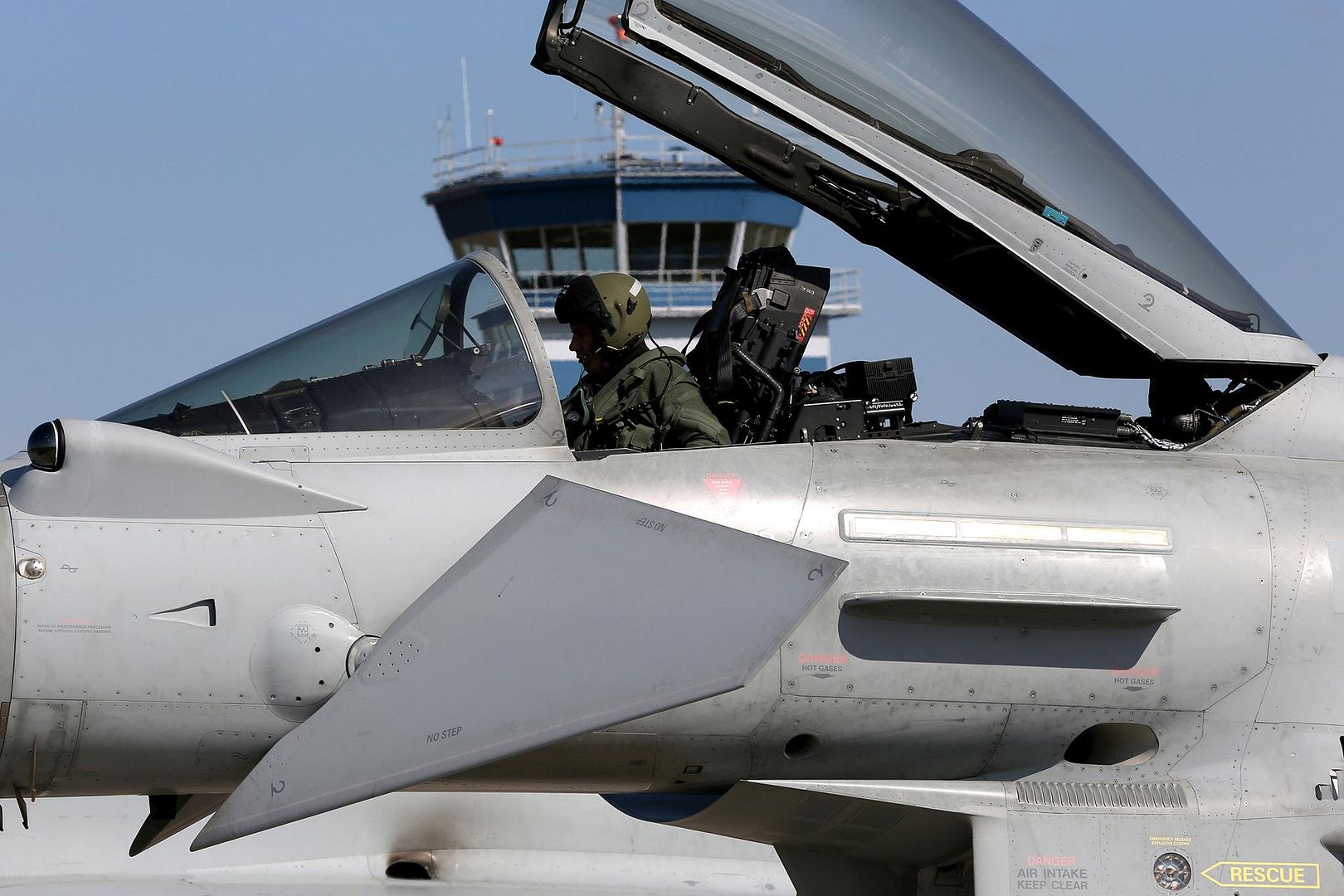
4/29/2016 - EDWARDS AIR FORCE BASE, Calif. -- A U.S. Marine Corps MV-22B Osprey descended on Edwards to link up with a Marine F-35B Joint Strike Fighter April 28.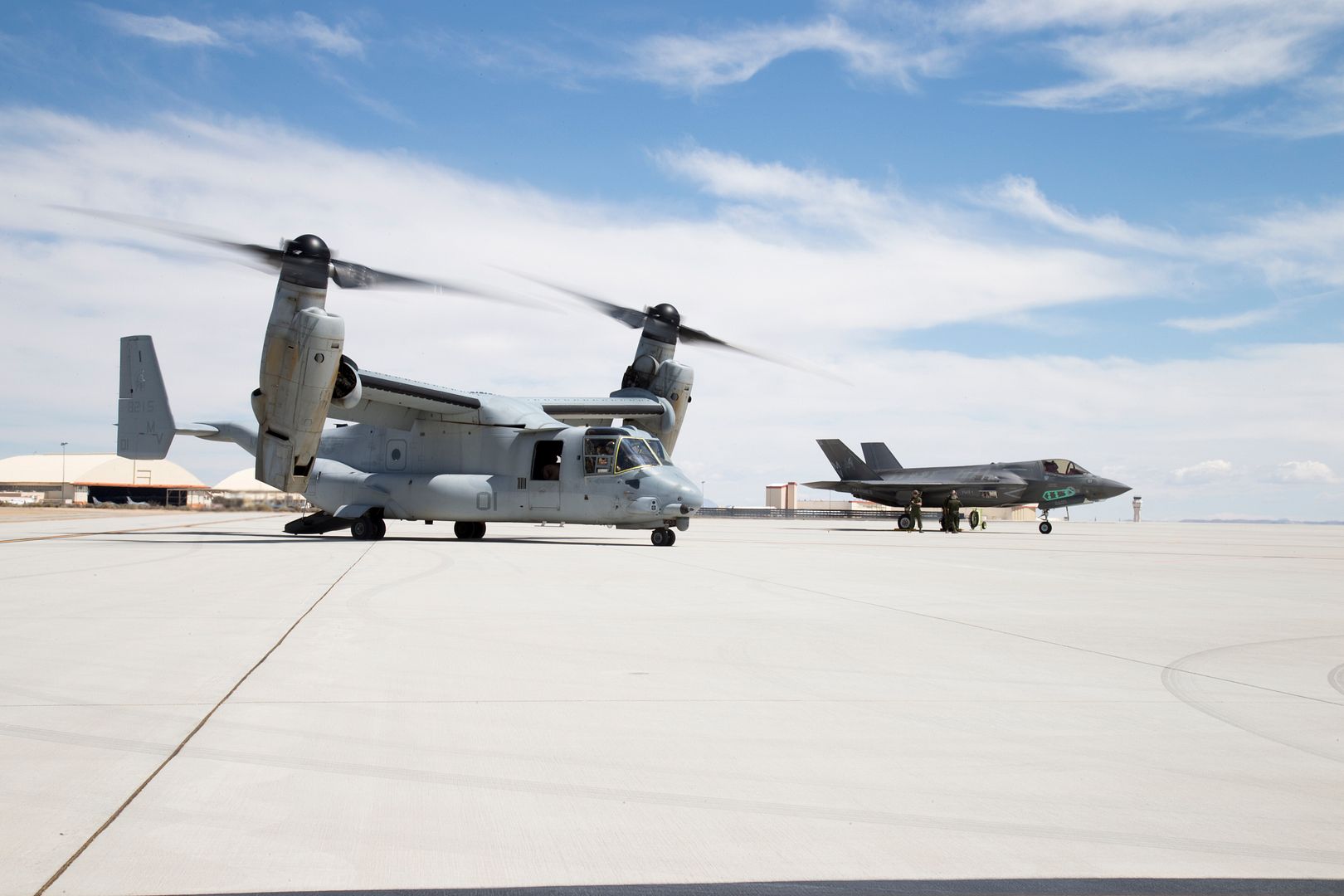
Both aircraft are assigned to Marine Operational Test & Evaluation Squadron 22 (VMX-22) out of Marine Corps Air Station Yuma in Arizona.
VMX-22 has a detachment here where Marines are testing and evaluating their version of the JSF, which is the short take-off and vertical landing variant.
The Osprey dropped by for a quick but important test.
"The test was to validate ground refueling from an MV-22 to an F-35B, which is integral to the construct of the Marine Air Ground Task Force," said USMC Maj. Adam Geitner, pilot and VMX-22 F-35 Detachment Aircraft Maintenance officer.
The Marine Air-Ground Task Force is the organizational foundation for all missions across the range of USMC military operations. MAGTFs are a balanced air-ground, combined arms task organization of Marine Corps forces under a single commander that is structured to accomplish a specific mission.
"This was the first time an MV-22 has refueled an F-35. Both ground refueling and air-to-air refueling are important pieces to the Marine Corps' MAGTF operational construct. From a tactical point of view, the MV-22 to F-35 ground refueling allows the Marine Corps to employ assets in austere environments on a short notice without having to rely on long-term planning and fixed facilities," Geitner said.
The one-hour test consisted of hooking up fuel transfer lines between the two aircraft with the MV-22 fueling up the F-35B. The test validated the equipment and procedures on both the F-35B and MV-22.
Geitner said the MV-22 Osprey has the ability to carry approximately 10,000 lbs. of fuel in its fuel containers loaded in the back of the aircraft. This is coupled with approximately 12,000 lbs. carried internally, which can either provide fuel to its own aircraft or to external aircraft in air-to-air refueling operations.
Fuel was successfully transferred to the F-35, which taxied off back to the Joint Operation Test Team area.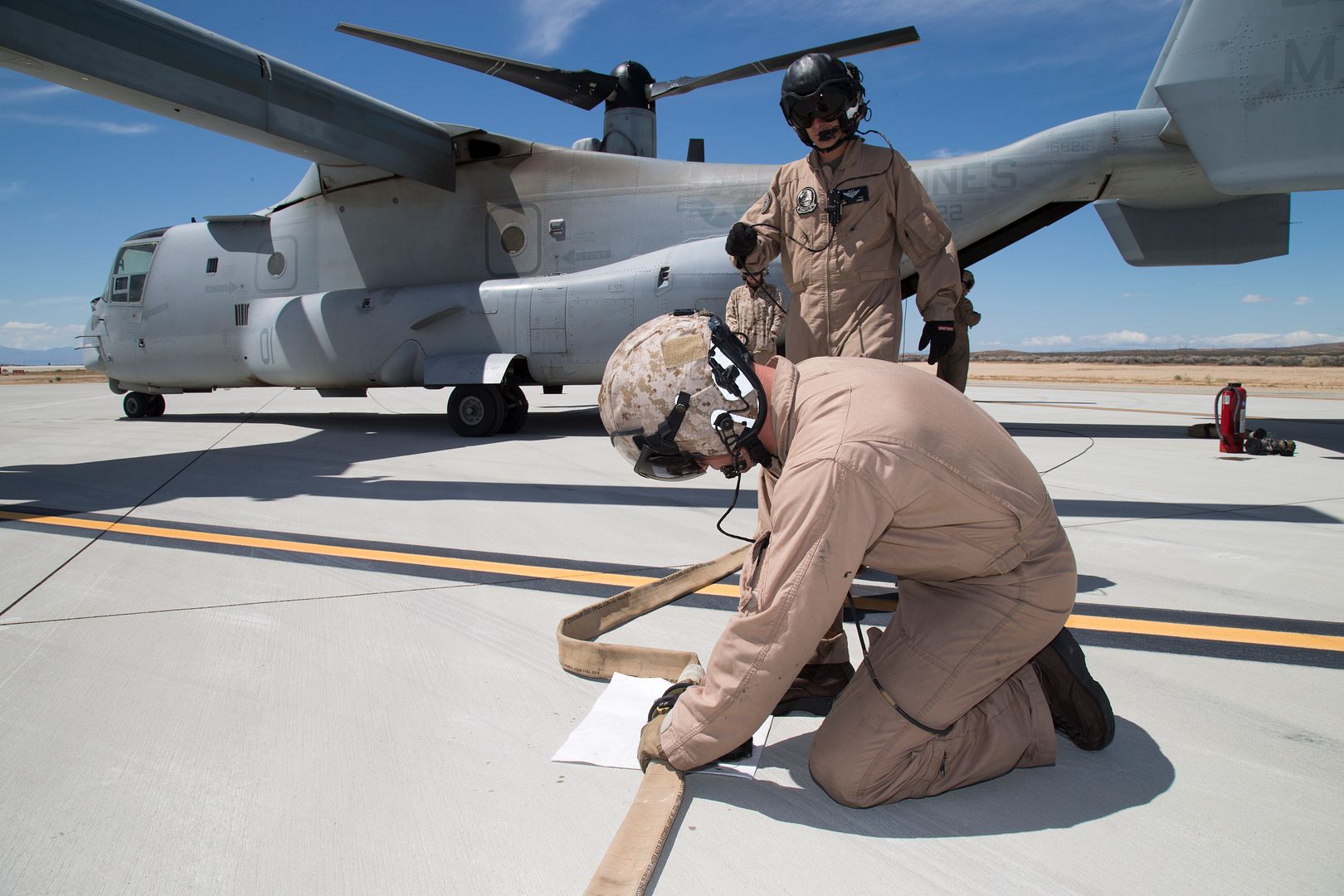
"The next step will be air-to-air refueling from an MV-22. This is even more significant for the MAGTF when operating F-35s from [amphibious assault ships] because it provides organic air-to-air refueling capability that vastly extends the range of the aircraft and also provides operational flexibility," said Geitner.
Previously, Marine AV-8B Harrier aircraft would require USMC KC-130s to provide air-to-air refueling capabilities. However, they are limited to land and when the amphibious assault ships are operating in either blue water operations, or in regions that deny them access to land-based air facilities, as it limits air-to-air refueling capabilities, Geitner added.
"With the MV-22 being on the ship, co-located with the F-35, all of those constraints with the KC-130 no longer apply."
The MV-22B Osprey is a tiltrotor vertical and/or short take-off and landing aircraft that serves as the medium-lift assault support aircraft for the Marines. The Osprey can operate as a helicopter or a turboprop aircraft. It can transport troops, equipment and supplies from ships and land bases for combat assault and support.
Edwards AFB hasn't seen an Osprey in the skies regularly since 2007. That's the year the 418th Flight Test Squadron said goodbye to the CV-22 Integrated Test Team after completing developmental test of the aircraft.
(U.S. Air Force photo's by Christian Turner)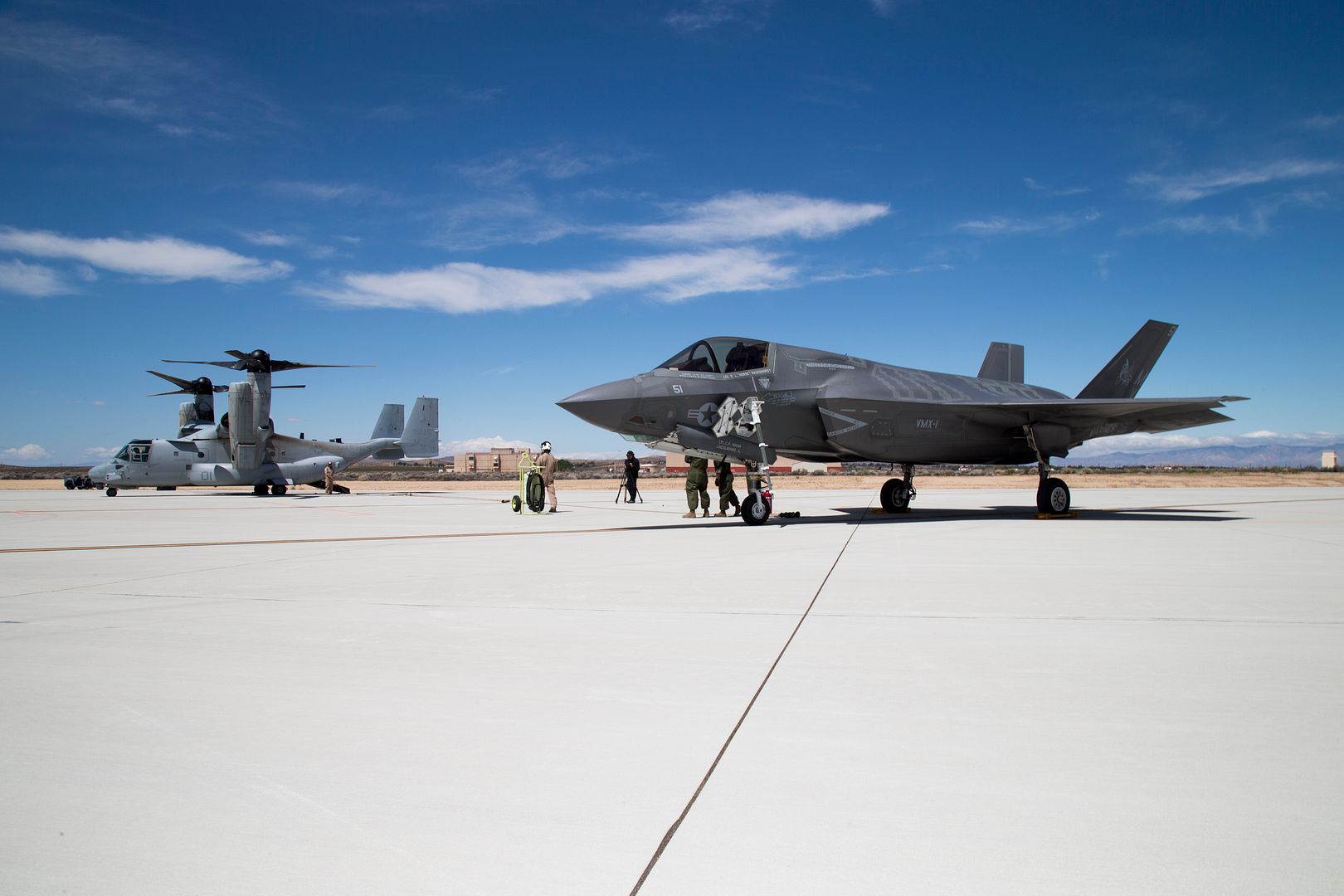
ISTANBUL, April 29, 2016 /PRNewswire/ -- Boeing [NYSE: BA] is set to deliver a record number of airplanes this year to Turkey's flag carrier, Turkish Airlines. In total, the carrier will take delivery of six 777-300ERs and 20 Next-Generation 737-800s in 2016.
"Turkish Airlines is one of the world's ascendant airlines and an established global network carrier. It has achieved this through various significant investments in its fleet which now stands at over 311 and growing," said Ahmet Bolat, Chief Investment and Technology Officer, Turkish Airlines. "The delivery of a further 26 Boeing aircraft this year, which form a substantial part of our long-haul and short-haul fleets, are integral to Turkish's continued growth and we look forward to introducing the new planes on our domestic and international network."
The Next-Generation 737's market success has been confirmed by investors who consistently rank it as the most preferred single-aisle airplane due to its wide market base, superior efficiency and lowest operating costs in its class. To date, more than 7,000 Next-Generation 737s have been ordered by the world's leading airlines.
"We are pleased that Turkish Airlines continues to show faith in Boeing's products and services," said Monty Oliver, vice president, European Sales, Boeing Commercial Airplanes. "We have a strong relationship with the airline and are honored that we continue to play a key part in supporting its ambitious growth plans."
Turkish Airlines and Boeing share a long history that goes back to 1945, with the arrival of the airline's first DC-3/C-47 airliners. Turkish Airlines entered the jet age in the late 1960s, when the airline began operating DC-9, DC-10 and Boeing 707 airplanes.
Over the years, Turkish carriers have also flown the Boeing 727, 757, MD-80 and the most modern 737 and 777 airplanes. Turkish Technic, a prominent subsidiary of the airline, is a world-class maintenance center for Boeing 737 airplanes, with certifications from regulatory authorities throughout the region and beyond.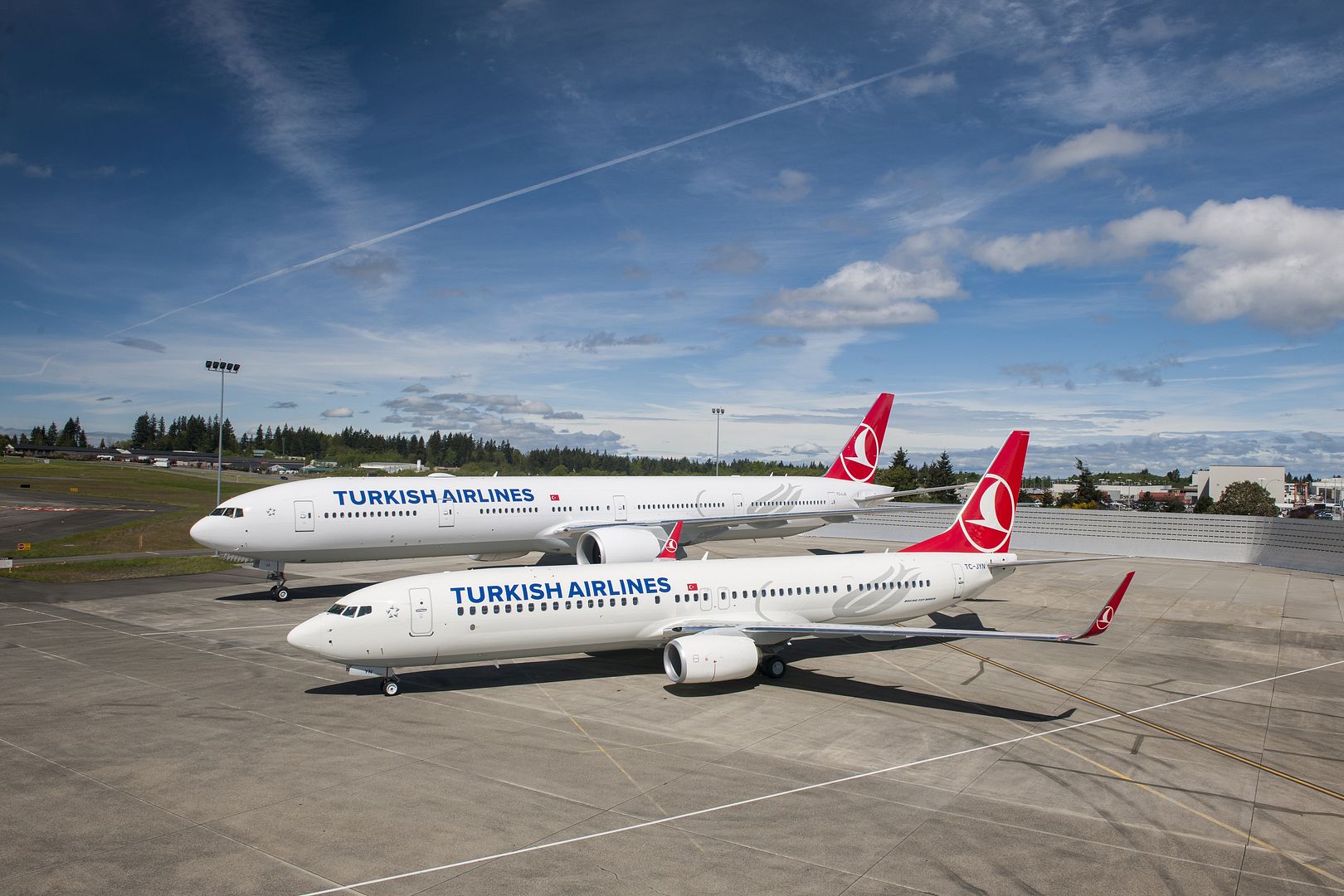
April 29, 2016 Los Angeles Business Aircraft, Bombardier Inc., Press Release
Attendees at the annual Milken Institute Global Conference in Los Angeles, California will have a unique opportunity to tour the impressive full-scale mock-up of Bombardier?s innovative Global 7000 business jet. The life-size mock-up, which will be displayed adjacent to the conference headquarters at the Beverly Hilton Hotel from May 1-4, 2016, showcases the aircraft?s stylish and precedent-setting four-zone interior. This is the first time an aircraft mock-up has been displayed at the conference.
The four-day conference will attract more than 3,500 prominent business leaders, politicians, philanthropists, scientists and scholars from around the world and will feature over 700 speakers. Delegates will explore the role of financial tools and policy in creating strong societies and devise solutions aimed at widening global access to capital, creating jobs and improving health care and education. Bombardier has been a sponsor of the conference for the past nine years.
?The Milken Institute Global Conference is the ideal venue to showcase an aircraft that will revolutionize the business jet experience, enhancing how companies, governments and individuals connect,? said David Coleal, President, Bombardier Business Aircraft. ?We developed this breakthrough design by consulting business leaders from around the world and asking ourselves, ?What if?? It?s the same question that the leading minds at this conference are asking: they reimagine what?s possible and then map out innovative ways to achieve it.?
Global 7000 aircraft: The first and only business jet to offer four unique living spaces, the Global 7000 aircraft will set the standard for a new category of large business jets, providing unmatched performance, flexibility, and comfort. The state-of-the-art Global 7000 aircraft will feature a wing that optimizes both short-field and high-speed, long-range performance, coupled with highly efficient engines, the largest cabin and the most advanced cockpit.
Passengers flying on the Global 7000 business jet will experience an impressive long-range capability of 7,400 NM (13,705 km) at M 0.85 with eight passengers. This business aircraft will be able to connect Los Angeles to major economic hubs, such as Hong Kong*, Sydney* or Moscow* non-stop, and will feature a maximum operating speed of M 0.925*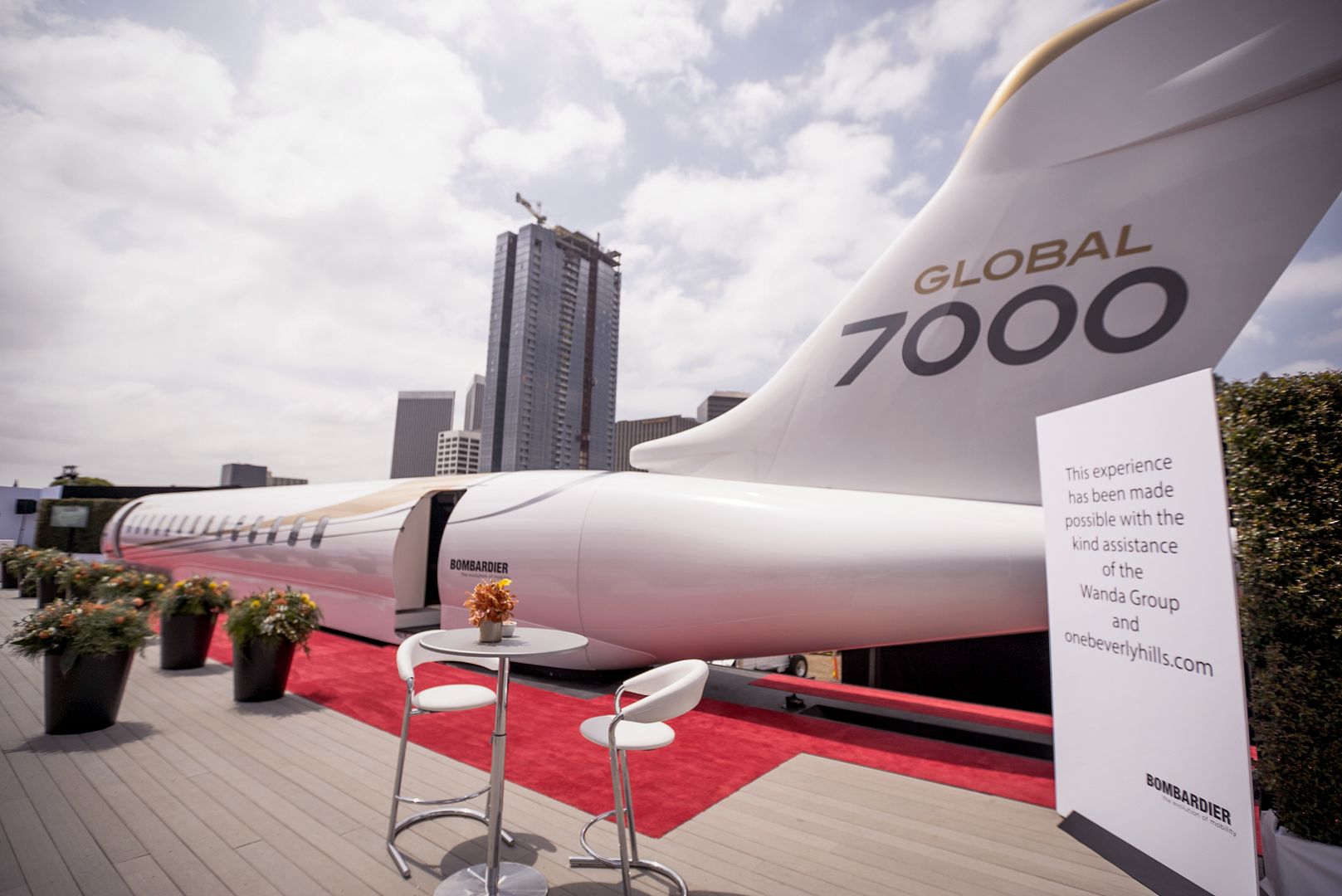
29th April
Donauw?rth, With today?s successful technical acceptance, Airbus Helicopters has handed over the first two of five lightweight military multi-role H145M helicopters to the Royal Thai Navy. This marks an important milestone in the H145M programme on its way to the final acceptance and entry into service in Thailand at the end of 2016. A delegation from the Royal Thai Navy and Airbus Helicopters Germany CEO Wolfgang Schoder participated in the ceremony at Airbus Helicopters? Donauw?rth site.
?After the H145M made its market entry with the German Air Force at the end of last year, we are very proud that the Royal Thai Navy has become another operator of the new H145M?, said Wolfgang Schoder. ?The helicopter is the most advanced solution for the increasingly challenging demands of our military customers in modern-day missions. It combines state-of-the-art technologies, outstanding performance and true multi-role capabilities while maintaining very high versatility and low operating costs.?
The H145M is the military version of the civil H145 that entered service in mid-2014 and has recently reached the milestone of 15,000 flying hours in customer operations. With a maximum take-off weight of 3.7 tons, the H145M can be used for a wide range of military operations including naval, utility, reconnaissance, search and rescue, medical evacuation and armed scout. The Royal Thai Navy H145M is equipped with Multi-Purpose Pylons incl. aerodynamic fairings, cargo hooks, hoists, HF system for SAR operations, weather radar, internal long range fuel tank system and fixed provisions for future special operations upgrade.
These two H145M helicopters will stay in Germany for pilot training at Airbus Helicopters? Training Academy. All helicopters are scheduled for delivery in Thailand by September 2016.
Designed as a true military multi-role helicopter, the H145M offers a single platform, which is able to perform day and night missions in harsh weather conditions and difficult terrain. Its large mission equipment range, depending on the customer configuration, increases mission flexibility for military operators. The helicopter?s Helionix? digital avionics suite ? incorporating the in-house developed 4-axis autopilot ? is designed to reduce crew workload while providing high levels of safety and improved situational awareness. The H145M is powered by two Turbomeca Arriel 2E equipped with full authority digital engine control (FADEC). Its low acoustic footprint makes the H145 the quietest helicopter in its class.
The H145 helicopter family has proven its value for military customers for many years. For instance, the German Armed Forces (Bundeswehr), the launch customer for the H145M, has ordered 15 of these helicopters in a Special Forces configuration. The third helicopter will be delivered in the coming days.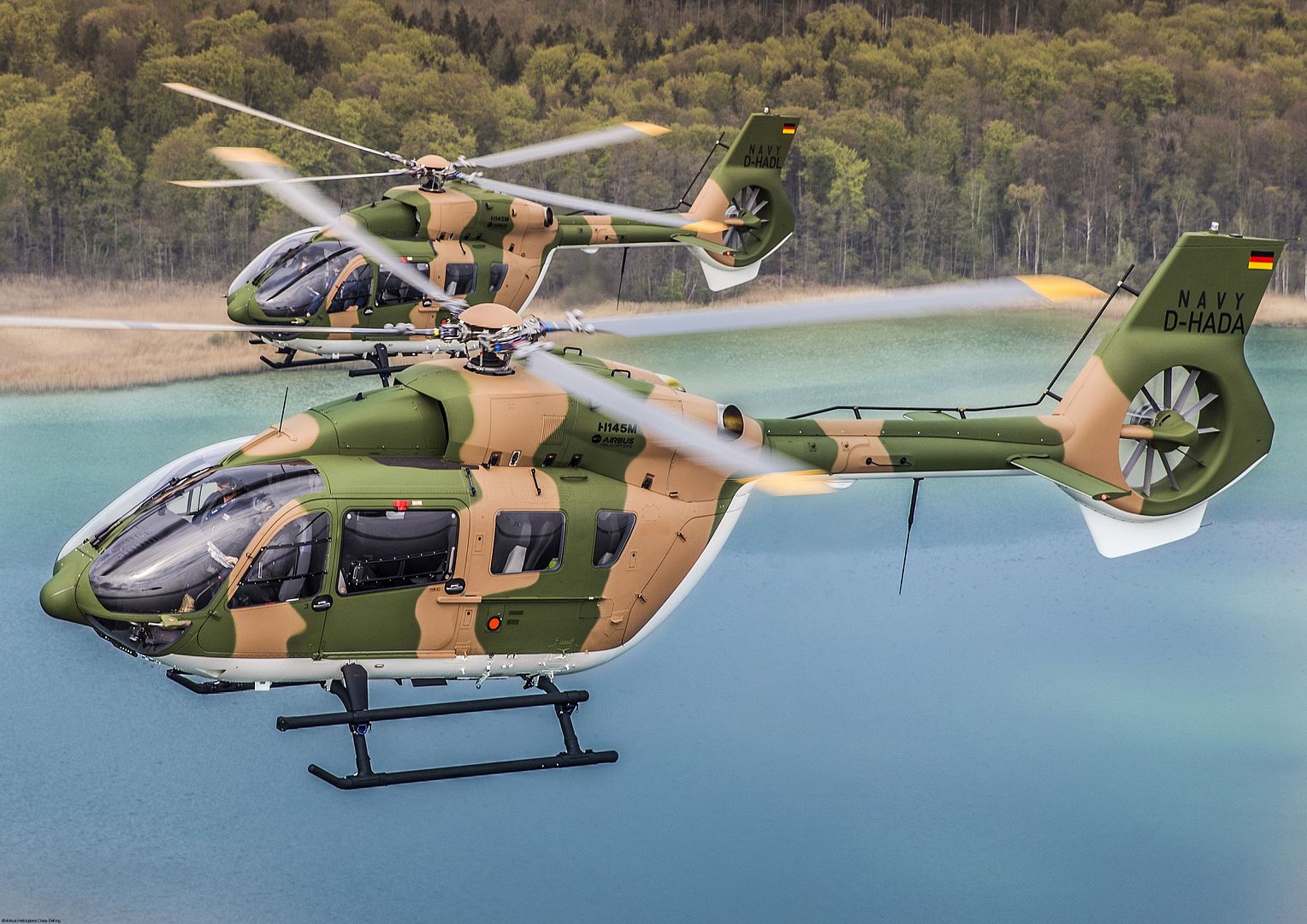
Post a reply
- Go to Next topic
- Go to Welcome
- Go to Introduce Yourself
- Go to General Discussion
- Go to Screenshots, Images and Videos
- Go to Off topic
- Go to Works in Progress
- Go to Skinning Tips / Tutorials
- Go to Skin Requests
- Go to IJAAF Library
- Go to Luftwaffe Library
- Go to RAF Library
- Go to USAAF / USN Library
- Go to Misc Library
- Go to The Ops Room
- Go to Made in Germany
- Go to Campaigns and Missions
- Go to Works in Progress
- Go to Juri's Air-Raid Shelter
- Go to Campaigns and Missions
- Go to Works in Progress
- Go to Skinpacks
- Go to External Projects Discussion
- Go to Books & Resources
